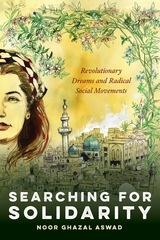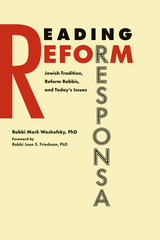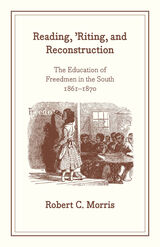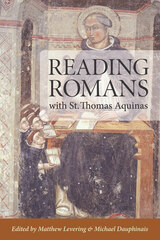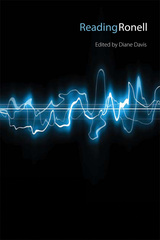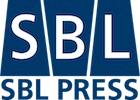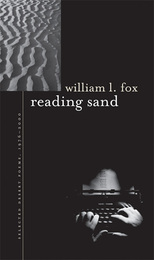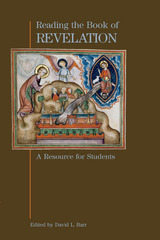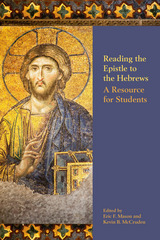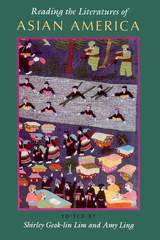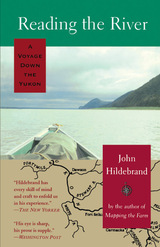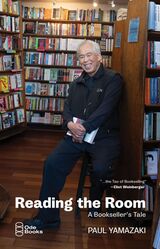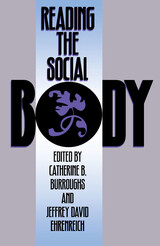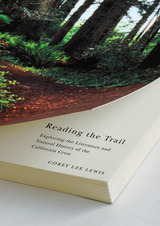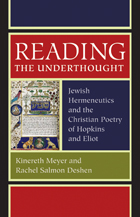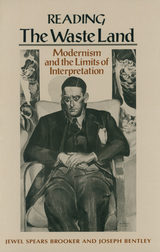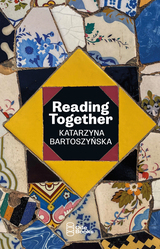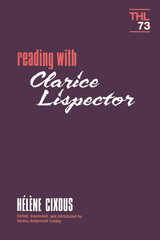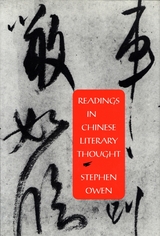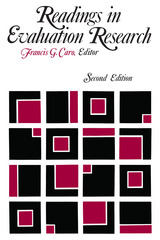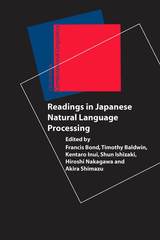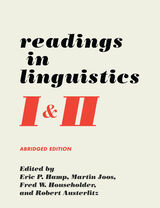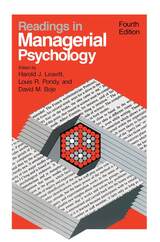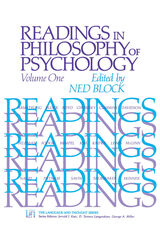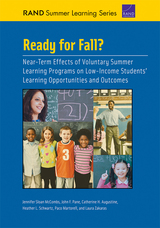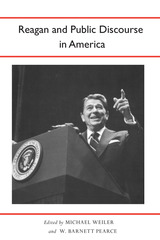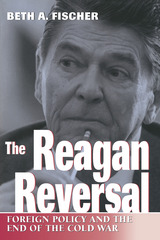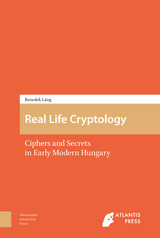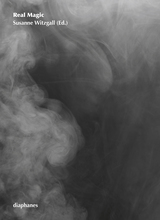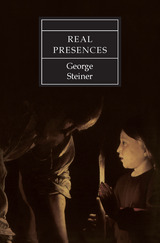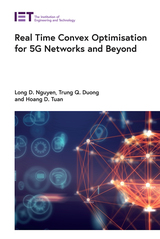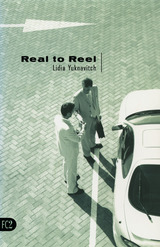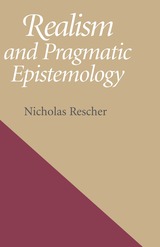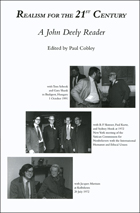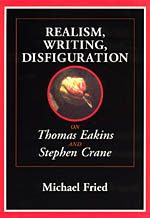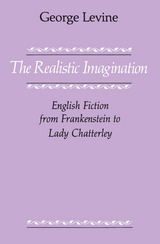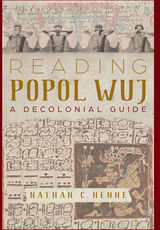 Reading Popol Wuj: A Decolonial Guide
Nathan C. Henne
University of Arizona Press, 2020 Popol Wujis considered one of the oldest books in the Americas. Various elements of Popol Wuj have appeared in different written forms over the last two millennia and several parts of Popol Wuj likely coalesced in hieroglyphic book form a few centuries before contact with Europeans. Popol Wuj offers a unique interpretation of the Maya world and ways of being from a Maya perspective. However, that perspective is often occluded since the extant Popol Wuj is likely a copy of a copy of a precontact Indigenous text that has been translated many times since the fifteenth century. Reading Popol Wujoffers readers a path to look beyond Western constructions of literature to engage with this text through the philosophical foundation of Maya thought and culture. This guide deconstructs various translations to ask readers to break out of the colonial mold in approaching this seminal Maya text. Popol Wuj, or Popol Vuh, in its modern form, can be divided thematically into three parts: cosmogony (the formation of the world), tales of the beings who inhabited the Earth before the coming of people, and chronicles of different ethnic Maya groups in the Guatemala area. Examining thirteen translations of the K’iche’ text, Henne offers a decolonial framework to read between what translations offer via specific practice exercises for reading, studying, and teaching. Each chapter provides a close reading and analysis of a different critical scene based on a comparison of several translations (English and Spanish) of a key K’iche’ word or phrase in order to uncover important philosophical elements of Maya worldviews that resist precise expression in Indo-European languages. Charts and passages are frontloaded in each chapter so the reader engages in the comparative process before reading any leading arguments. This approach challenges traditional Western reading practices and enables scholars and students to read Popol Wuj—and other Indigenous texts—from within the worldview that created them.
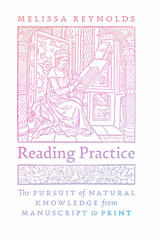 Reading Practice: The Pursuit of Natural Knowledge from Manuscript to Print
Melissa Reynolds
University of Chicago Press, 2024 Through portraits of readers and their responses to texts, Reading Practice reconstructs the contours of the knowledge economy that shaped medicine and science in early modern England.
Reading Practice tells the story of how ordinary people grew comfortable learning from commonplace manuscripts and printed books, such as almanacs, medical recipe collections, and herbals. From the turn of the fifteenth century to the close of the sixteenth century, these were the books English people read when they wanted to attend to their health or understand their place in the universe. Before then, these works had largely been the purview of those who could read Latin. Around 1400, however, medical and scientific texts became available in Middle English while manuscripts became less expensive. These vernacular manuscripts invited their readers into a very old and learned conversation: Hippocrates and Galen weren’t distant authorities whose word was law, they were trusted guides, whose advice could be excerpted, rearranged, recombined, and even altered to suit a manuscript compiler’s needs. This conversation continued even after the printing press arrived in England in 1476. Printers mined manuscripts for medical and scientific texts that they would publish throughout the sixteenth century, though the pressures of a commercial printing market encouraged printers to package these old texts in new ways. Without the weight of authority conditioning their reactions and responses to very old knowledge, and with so many editions of practical books to choose from, English readers grew into confident critics and purveyors of natural knowledge in their own right.
Melissa Reynolds reconstructs shifting attitudes toward medicine and science over two centuries of seismic change within English culture, attending especially to the effects of the Reformation on attitudes toward nature and the human body. Her study shows how readers learned to be discerning and selective consumers of knowledge gradually, through everyday interactions with utilitarian books.
Reading Prester John: Cultural Fantasy and its Manuscript Contexts
John Eldevik
Arc Humanities Press, 2024
During the Middle Ages, many Europeans imagined that there existed a powerful and marvel-filled Christian realm beyond the lands of Islam ruled by a devout emperor they called “Priest John,” or “Prester John.” Spurred by a forged letter that mysteriously appeared around 1165 and quickly “went viral” in hundreds of manuscripts across Western Europe, the legend of Prester John and his exotic kingdom was not just a utopian fantasy, but a way to bring contemporary political and theological questions into sharper focus. In this new study, John Eldevik shows how the manuscripts that transmitted the story of Prester John reflect the ways contemporary audiences processed ideas about religious conflict and helped them imagine a new, global dimension of Christianity. It includes an appendix with a new translation of the B recension of The Letter of Prester John.
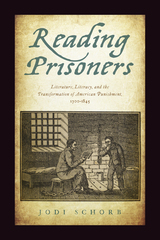 Reading Prisoners: Literature, Literacy, and the Transformation of American Punishment, 1700–1845
Schorb, Jodi
Rutgers University Press, 2014 Shining new light on early American prison literature—from its origins in last words, dying warnings, and gallows literature to its later works of autobiography, exposé, and imaginative literature— Reading Prisoners weaves together insights about the rise of the early American penitentiary, the history of early American literacy instruction, and the transformation of crime writing in the “long” eighteenth century.
Looking first at colonial America—an era often said to devalue jailhouse literacy—Jodi Schorb reveals that in fact this era launched the literate prisoner into public prominence. Criminal confessions published between 1700 and 1740, she shows, were crucial “literacy events” that sparked widespread public fascination with the reading habits of the condemned, consistent with the evangelical revivalism that culminated in the first Great Awakening. By century’s end, narratives by condemned criminals helped an audience of new writers navigate the perils and promises of expanded literacy.
Schorb takes us off the scaffold and inside the private world of the first penitentiaries—such as Philadelphia’s Walnut Street Prison and New York’s Newgate, Auburn, and Sing Sing. She unveils the long and contentious struggle over the value of prisoner education that ultimately led to sporadic efforts to supply prisoners with books and education. Indeed, a new philosophy emerged, one that argued that prisoners were best served by silence and hard labor, not by reading and writing—a stance that a new generation of convict authors vociferously protested.
The staggering rise of mass incarceration in America since the 1970s has brought the issue of prisoner rehabilitation once again to the fore. Reading Prisoners offers vital background to the ongoing, crucial debates over the benefits of prisoner education.
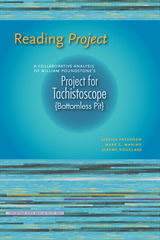 Reading Project: A Collaborative Analysis of William Poundstone's Project for Tachistoscope {Bottomless Pit}
Jessica Pressman, Mark C. Marino, and Jeremy Douglass
University of Iowa Press, 2015 Electronic literature is a rapidly growing area of creative production and scholarly interest. It is inherently multimedial and multimodal, and thus demands multiple critical methods of interpretation. Reading Project: A Collaborative Analysis of William Poundstone’s Project for Tachistoscope {Bottomless Pit} is a collaboration between three scholars combining different interpretive methods of digital literature and poetics in order to think through how critical reading is changing—and, indeed, must change—to keep up with the emergence of digital poetics and practices. It weaves together radically different methodological approaches—close reading of onscreen textual and visual aesthetics, Critical Code Studies, and cultural analytics (big data)—into a collaborative interpretation of a single work of digital literature.
Project for the Tachistoscope {Bottomless Pit} is a work of electronic literature that presents a high-speed, one-word-at-a-time animation synchronized to visual and aural effects. It tells the tale of a mysterious pit and its impact on the surrounding community. Programmed in Flash and published online, its fast-flashing aesthetic of information overload bombards the reader with images, text, and sound in ways that challenge the ability to read carefully, closely, and analytically in traditional ways. The work’s multiple layers of poetics and programming can be most effectively read and analyzed through collaborative efforts at computational criticism such as is modeled in this book. The result is a unique and trailblazing book that presents the authors’ collaborative efforts and interpretations as a case study for performing digital humanities literary criticism of born-digital poetics.
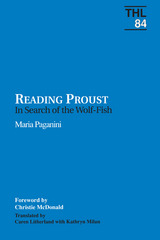 Reading Proust: In Search of Wolf-Fish
Maria Paganini
University of Minnesota Press, 1994 Reading Proust was first published in 1994.What readers of Proust in English translation miss, along with most of his critics, is how precisely his writing works, how exactly his subtle craftsmanship weaves the spell that seems to enchant and distract those who encounter it. Even critics who take up the idiosyncrasies of Proust's text, Maria Paganini asserts, refuse to test its limits for fear of running into the writer's deliberate opacities. Reading Proust puts an end to this interpretive arrest by focusing on the specificity of Proustian writing, revealing the patterns of thought and play of words peculiar to Proust's language, and showing how these metamorphose throughout La Recherche du temps perdu. Her work offers a new model for reading fictional prose, one that replaces the critical "why?" with the more practical and productive "how?" In well-known passages from La Recherche as well as often neglected ones, Paganini exposes a series of cryptic puns developed around three letters of the alphabet, "A," "R," and "T," which trigger many permutations in French: tare (flaw), rat, rater (to miss), and art. She shows how extensive passages of Proust's writings are articulated around a repetitive four-beat scansion using tare, rat, rater or arrêt, and art as its dominant theme. This four-beat scansion also translates into movement in space-point of departure, travel to the horizon, limit point, return-and Paganini uses such "promenades" to gain access to the text's mode of production. Her reading draws new meaning from this familiar yet enigmatic work and opens a new perspective on important issues such as the emergence of involuntary memory or Proust's approach to sexuality. Most significantly, though, Paganini confronts us in a very concrete way with Proust's craft, an approach that explains why and how his work continues to attract and fascinate readers. Maria Paganini is professor emerita of French at the University of Minnesota. She is the author of Flaubert, la présence de l'écrivain dans l'oeuvre.
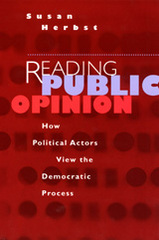 Reading Public Opinion: How Political Actors View the Democratic Process
Susan Herbst
University of Chicago Press, 1998 Public opinion is one of the most elusive and complex concepts in democratic theory, and we do not fully understand its role in the political process. Reading Public Opinion offers one provocative approach for understanding how public opinion fits into the empirical world of politics. In fact, Susan Herbst finds that public opinion, surprisingly, has little to do with the mass public in many instances.
Herbst draws on ideas from political science, sociology, and psychology to explore how three sets of political participants—legislative staffers, political activists, and journalists—actually evaluate and assess public opinion. She concludes that many political actors reject "the voice of the people" as uninformed and nebulous, relying instead on interest groups and the media for representations of public opinion. Her important and original book forces us to rethink our assumptions about the meaning and place of public opinion in the realm of contemporary democratic politics.
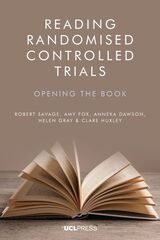 Reading Randomised Controlled Trials: Opening the Book
Robert Savage, Amy Fox, Anneka Dawson, Helen Gray, and Clare Huxley
University College London, 2025 A behind-the-scenes look at a large-scale reading intervention trial, exposing the human decisions and real-world challenges that shape educational research.
Reading Randomised Controlled Trials presents an illuminating exploration of how large-scale educational trials unfold in real-world settings, displaying the often-overlooked human decisions that shape their outcomes. Using the Flexible Phonics trial—an ambitious study involving nearly 3,000 children in 118 schools across England—as a case study, the authors examine the practical and ethical problems with conducting randomized controlled trials (RCTs) in education. Unlike pharmaceutical trials, educational RCTs operate in dynamic environments where factors such as teacher decision-making and school culture play a crucial role.
This book depicts the inner workings of education research and also underlines its broader significance, particularly in the wake of school closures during the COVID-19 pandemic. By focusing on early childhood literacy and the long-term impact of evidence-based interventions, Reading Randomised Controlled Trials provides important insights for educators and researchers seeking to bridge the gap between rigorous research and meaningful classroom practice. A must-read for those invested in improving educational outcomes, this book contests assumptions about what works in education—and why.
Reading Reform Responsa: Jewish Tradition, Reform Rabbis, and Today's Issues
Mark Washofsky
Central Conference of American Rabbis, 2024 The responsa literature, in which rabbis answer questions about halachah (Jewish law), is a vast treasury reaching back nearly fifteen centuries; Reform rabbis have been writing responsa since the 1800s. In Reading Reform Responsa, Rabbi Mark Washofsky, PhD, presents a deep dive into this literature, boldly arguing that Reform Judaism is indeed a movement fundamentally based on halachah. By inviting and guiding readers to understand Reform responsa with a critical eye, he shows that our movement has always been informed by Jewish law as well as Reform history. A teacher and mentor of generations of students at Hebrew Union College--Jewish Institute of Religion, Rabbi Washofsky gives us a peek inside his classroom, making Reform responsa---and their history, framing, and context---engaging and accessible for all.
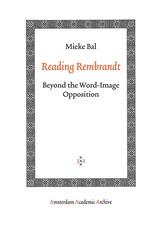 Reading Rembrandt: Beyond the Word-Image Opposition
Mieke Bal
Amsterdam University Press, 2006 Reading Rembrandt: Beyond the Word-Image Opposition explores the potential for an interdisciplinary methodology between visual art and literature. In a series of close analyses of works by “Rembrandt” – works as we see them today, through all the ways of seeing and commenting that precede – and texts related to those works, Mieke Bal questions the traditional boundaries between literary and visual analysis. Bal also studies Rembrandt’s complex handling of gender and the representation of women in Rembrandt’s painting. The methods used in this study come from both in- and outside the history of art. They demonstrate the author’s sensitivity to the visual aspects of Rembrandt’s work as meaningful. The works by Rembrandt gain in depth and interest, but an original perspective of the role of visuality in our culture also emerges, which ultimately has consequences for our views of gender, the artists, and the act of reading.
Reading, 'Riting, and Reconstruction: The Education of Freedmen in the South, 1861-1870
Robert C. Morris
University of Chicago Press, 1981 This study of education for freedmen following Emancipation is the definitive treatment of the subject. Employing a wide range of sources, Robert C. Morris examines the organizations that staffed and managed black schools in the South, with particular attention paid to the activities of the Freedman’s Bureau. He looks as well at those who came to teach, a diverse group—white, black, Northern, Southern—and at the curricula and textbooks they used. While giving special emphasis to the Freedmen’s Bureau school program, Morris places the freedmen’s educational movement fully in its nineteenth-century context, relating it both to the antislavery crusade that preceded it and to the conservative era of race relations that followed.
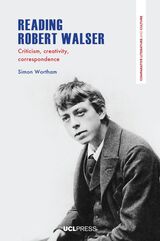 Reading Robert Walser: Criticism, Creativity, Correspondence
Simon Wortham
University College London, 2025 A radical engagement with Robert Walser’s correspondence that turns literary criticism into an act of creative recovery.
Robert Walser’s letters to Frieda Mermet, the laundry manager at a Swiss psychiatric hospital, offer an intimate and enigmatic glimpse into the mind of a writer whose literary fortunes waned even as his influence grew in the decades following his death. Covering nearly thirty years, from 1913 to 1942, these letters chart Walser’s transition from a celebrated modernist to a man institutionalized, yet still deeply engaged with language and identity.
In Reading Robert Walser, Simon Wortham studies Walser’s letters within the broader context of modernist literature and deconstruction, and also imaginatively reconstructs Mermet’s possible lost responses, blurring the lines between criticism and creativity. The result is an innovative exploration of authorship and the act of reading itself—one that deepens our understanding of Walser’s life and work while questioning the very nature of literary correspondence.
Reading Romans with St. Thomas Aquinas
Matthew Levering
Catholic University of America Press, 2012 This volume fits within the contemporary reappropriation of St. Thomas Aquinas, which emphasizes his use of Scripture and the teachings of the church fathers without neglecting his philosophical insight.
Reading Ronell
Edited by Diane Davis
University of Illinois Press, 2008 Avital Ronell has won worldwide acclaim for her work across literature and philosophy, psychoanalysis and popular culture, political theory and feminism, art and rhetoric, drugs and deconstruction. In works such as The Test Drive, Stupidity, Crack Wars, and The Telephone Book, she has perpetually raised new and powerful questions about how we think, what thinking does, and how we fool ourselves about the troubled space between thought and action. In this collection, some of today's most distinguished and innovative thinkers turn their attention to Ronell's teaching, writing, and provocations, observing how Ronell reads and what comes from reading her. By reading Ronell, and reading Ronell reading, contributors examine the ethico-political implications of her radical dislocations and carefully explicate, extend, and explore the paraconcepts addressed in her works.
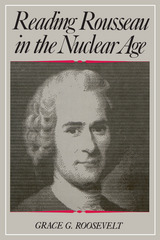 Reading Rousseau in the Nuclear Age
Grace Roosevelt
Temple University Press, 1990 "A solid contribution to Rousseau studies. It has the special merit of carefully and thoroughly analyzing several important writings of Rousseau on war and on international relations."
--Hilail Gildin, Queens College, C.U.N.Y.
For more than two centuries, the political writings of Jean-Jacques Rousseau have helped shape many different responses to historical experience. While today's readers are aware of Rousseau's contemporary significance, his writings on war and peace have been almost completely ignored. This book offers a fresh interpretation of two of Rousseau's little-known works: his unfinished "The State of War" and his summary and critique of the Abbe de Saint-Pierre's Project for Perpetual Peace. Starting with an account of her discovery of the original page sequence of Rousseau's manuscript on "The State of War," Grace G. Roosevelt explores his theory of international conflict and explains his alternative approaches to the problem of securing peace. She brings out the important connections between Rousseau's theory of international politics and his principles of education, arguing throughout for the continuing relevance of his ideas.
Roosevelt's main contention is that, when studied in relation to his works on politics and education, Rousseau's writings on war and peace provide the modern reader with a realistic analysis of the war system and a normative vision of the possibilities for peace. In discussing his principles of education, Roosevelt suggests that Rousseau's writings challenge us to confront the question of whether educational systems should aim to create citizens of a particular state or citizens of the world.
The book includes full translations, by the author, of Rousseau's unpublished manuscript on "The State of War" and of his forty-page "Summary" and "Critique" of the Project for Perpetual Peace.
Reading Sand: Selected Desert Poems, 1976-2000
William L. Fox
University of Nevada Press, 2002 The ascetic and enigmatic expanse of the Great Basin has challenged the talents of many writer, but few have met the challenge as successfully as William L. Fox. In Reading Sand, Fox's elegant minimalist poems capture the essence of the Great Basin desert—its daunting emptiness, the passage of light and wind across its surfaces, its colors and textures, its silence. In "perforated object," the collection's central piece, Fox uses a mysterious pierced-horn artifact discovered in Nevada's Humboldt Cave as the subject of an extended meditation on the nature of history and the inscrutability of the Great Basin's complex past. The result is an intellectually provocative and aesthetically moving work of a lean grandeur rarely found in recent poetry
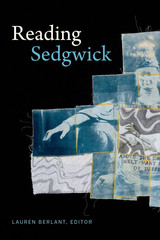 Reading Sedgwick
Lauren Berlant, editor
Duke University Press, 2019 Over the course of her long career, Eve Kosofsky Sedgwick became one of the most important voices in queer theory, and her calls for reparative criticism and reading practices grounded in affect and performance have transformed understandings of affect, intimacy, politics, and identity. With marked tenderness, the contributors to Reading Sedgwick reflect on Sedgwick's many critical inventions, from her elucidation of poetry's close relation to criticism and development of new versions of queer performativity to highlighting the power of writing to engender new forms of life. As the essays in Reading Sedgwick demonstrate, Sedgwick's work is not only an ongoing vital force in queer theory and affect theory; it can help us build a more positive world in the midst of the bleak contemporary moment.
Contributors. Lauren Berlant, Kathryn Bond Stockton, Judith Butler, Lee Edelman, Jason Edwards, Ramzi Fawaz, Denis Flannery, Jane Gallop, Jonathan Goldberg, Meridith Kruse, Michael Moon, José Esteban Muñoz, Chris Nealon, Andrew Parker, H. A. Sedgwick, Karin Sellberg, Michael D. Snediker, Melissa Solomon, Robyn Wiegman
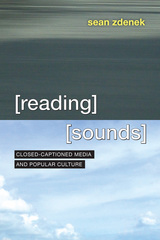 Reading Sounds: Closed-Captioned Media and Popular Culture
Sean Zdenek
University of Chicago Press, 2015 Imagine a common movie scene: a hero confronts a villain. Captioning such a moment would at first glance seem as basic as transcribing the dialogue. But consider the choices involved: How do you convey the sarcasm in a comeback? Do you include a henchman’s muttering in the background? Does the villain emit a scream, a grunt, or a howl as he goes down? And how do you note a gunshot without spoiling the scene?
These are the choices closed captioners face every day. Captioners must decide whether and how to describe background noises, accents, laughter, musical cues, and even silences. When captioners describe a sound—or choose to ignore it—they are applying their own subjective interpretations to otherwise objective noises, creating meaning that does not necessarily exist in the soundtrack or the script.
Reading Sounds looks at closed-captioning as a potent source of meaning in rhetorical analysis. Through nine engrossing chapters, Sean Zdenek demonstrates how the choices captioners make affect the way deaf and hard of hearing viewers experience media. He draws on hundreds of real-life examples, as well as interviews with both professional captioners and regular viewers of closed captioning. Zdenek’s analysis is an engrossing look at how we make the audible visible, one that proves that better standards for closed captioning create a better entertainment experience for all viewers.
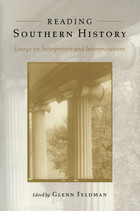 Reading Southern History: Essays on Interpreters and Interpretations
Glenn Feldman
University of Alabama Press, 2001 This collection of essays examines the contributions of some of the most notable interpreters of southern history and culture, furthering our understanding of the best historical work produced on the region. Historian Glenn Feldman gathers together a group of essays that examine the efforts of important scholars to discuss and define the South's distinctiveness. The volume includes 18 chapters on such notable historians as John Hope Franklin, Anne Firor Scott, Frank L. Owsley, W. J. Cash, and C. Vann Woodward, written by 19 different researchers, both senior historians and emerging scholars, including Jacquelyn Dowd Hall, John Shelton Reed, Bruce Clayton, and Ted Ownby. The essays examine the major work or works of each scholar under consideration as well as that scholar's overall contribution to the study of southern history. Reading Southern History will enlighten readers on the more compelling themes currently and traditionally explored by southern historians. It will appeal greatly to professors and students as a valuable multidisciplinary introduction to the study of southern history, since several of the essays are on scholars who are working outside the discipline of history proper, in the fields of political science, sociology, journalism, and economics. Feldman's collection, therefore, sheds light on a broad spectrum of themes important in southern history, including the plight of poor whites, race, debates over race and class, the "reconstruction syndrome," continuity versus discontinuity in relation to blacks and whites, and regional culture and distinctiveness. Reading Southern History will be valuable to students and scholars of women's studies, African American history, working-class history, and ethnic studies, as well as traditional southern history. Most important, the publication makes a significant contribution to the development and ongoing study of the historiography of the South.
 Reading Tao Yuanming: Shifting Paradigms of Historical Reception (427 - 1900)
Wendy Swartz
Harvard University Press, 2008 Tao Yuanming (365?–427), although dismissed as a poet following his death, is now considered one of China’s greatest writers. Over the centuries, portrayals of his life—some focusing on his eccentricity, others on his exemplary virtue—have elevated him to iconic status. This study of the posthumous reputation of a central figure in Chinese literary history, the mechanisms at work in the reception of his works, and the canonization of Tao himself and of particular readings of his works sheds light on the transformation of literature and culture in premodern China. It focuses on readers’ interpretive negotiations with Tao’s works and on changes in hermeneutical practices, critical vocabulary, and cultural demands, as well as the intervention of interested and influential readers, in order to trace the construction of Tao Yuanming. Driven by a dialogue on categories at the very heart of literati culture—reclusion, personality, and poetry—this cumulative process spanning fifteen centuries, the author argues, helps explain the very different pictures of Tao Yuanming and the divergent ways of reading his works across time and illuminates central issues animating premodern Chinese culture.
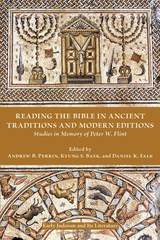 Reading the Bible in Ancient Traditions and Modern Editions: Studies in Memory of Peter W. Flint
Andrew B. Perrin
SBL Press, 2017 A collection of essays commemorating the career contributions of Peter W. Flint
An international group of scholars specializing in various disciplines of biblical studies—Dead Sea Scrolls, Septuagint, Hebrew Bible/Old Testament, Second Temple Judaism, and Christian origins—present twenty-seven new contributions that commemorate the career of Peter W. Flint (1951–2016). Each essay interacts with and gives fresh insight into a field shaped by Professor Flint’s life work. Part 1 explores the interplay between text-critical methods, the growth and formation of the Hebrew Scriptures, and the making of modern critical editions. Part 2 maps dynamics of scriptural interpretation and reception in ancient Jewish and Christian literatures of the Second Temple period.
Features
- Essays that assess the state of the field and reflect on the methods, aims, and best practices for textual criticism and the making of modern critical text editions
- Demonstrations of how the processes of scriptural composition, transmission, and reception converge and may be studied together for mutual benefit
- Clarification of the state/forms of scripture in antiquity and how scripture was extended, rewritten, and recontextualized by ancient Jewish and Christian scribes and communities
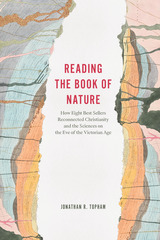 Reading the Book of Nature: How Eight Best Sellers Reconnected Christianity and the Sciences on the Eve of the Victorian Age
Jonathan R. Topham
University of Chicago Press, 2022 A powerful reimagining of the world in which a young Charles Darwin developed his theory of evolution.
When Charles Darwin returned to Britain from the Beagle voyage in 1836, the most talked-about scientific books of the day were the Bridgewater Treatises. This series of eight works was funded by a bequest of the last Earl of Bridgewater and written by leading men of science appointed by the president of the Royal Society to explore "the Power, Wisdom, and Goodness of God, as manifested in the Creation." Securing public attention beyond all expectations, the series offered Darwin’s generation a range of approaches to one of the great questions of the age: how to incorporate the newly emerging disciplinary sciences into Britain’s overwhelmingly Christian culture.
Drawing on a wealth of archival and published sources, including many unexplored by historians, Jonathan R. Topham examines how and to what extent the series contributed to a sense of congruence between Christianity and the sciences in the generation before the fabled Victorian conflict between science and religion. Building on the distinctive insights of book history and paying close attention to the production, circulation, and use of the books, Topham offers new perspectives on early Victorian science and the subject of science and religion as a whole.
Reading the Book of Revelation: A Resource for Students
David L. Barr
SBL Press, 2003 The Apocalypse lends itself to multivalent readings, and this volume fills a gap for students and scholars by discussing how different methods apply to readings. Using historical, literary, and social analysis in combination with strategies such as social-conflict theory, philosophy, women’s studies, ethics, history of religions, postcolonial studies, and popular culture, the essays in this volume focus on specific texts and show not only how each helps interpret the text but also how diverse methods produce divergent readings of a text. Developed as a classroom resource for undergraduates, this work will also prove useful to graduate students, religious leaders, and others who wish to explore how methods shape our understandings of various texts, including Revelation.
Reading the Cinematograph: The Cinema in British Short Fiction 1896-1912
Andrew Shail
University of Exeter Press, 2011
Reading the Cinematograph pairs eight short stories about the cinema—including works by such notables as Rudyard Kipling and Sax Rohmer—with eight new essays from leading film and literary scholars like Tom Gunning and Andrew Higson to reveal the influence that film and fiction had on one another in Britain at the beginning of the twentieth century.
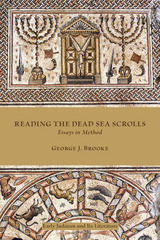 Reading the Dead Sea Scrolls: Essays in Method
George J. Brooke
SBL Press, 2013 The Dead Sea Scrolls, which have long captured the public imagination, are now all available in principal editions and accessible translations. This book addresses the next stage in their analysis by raising questions about how they should be read and studied. The essays collected here illustrate two approaches. First, some essays argue that traditional methods of studying ancient texts need to be refined and broadened in the light of the Scrolls. The volume thus contains studies on text criticism, literary traditions, lexicography, historiography, and theology. Second, the book also argues that innovative methods of study, applied fruitfully in other areas, now also need to be applied to the Scrolls, such as studies that consider the relevance for the Scrolls of deviance theory, cultural memory, hypertextuality, intertextuality, genre theory, spatial analysis, and psychology. Many of the examples in these studies relate to how authoritative scripture was handled and appropriated by the groups that gathered the Scrolls together in the caves at and near Qumran, so some of the same texts are analyzed from several different perspectives.
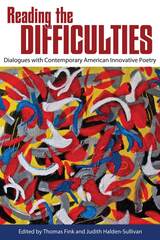 Reading the Difficulties: Dialogues with Contemporary American Innovative Poetry
Thomas Fink
University of Alabama Press, 2013 The bold essays that make up Reading the Difficulties offer case studies in and strategies for reading innovative poetry.
Definitions of what constitutes innovative poetry are innumerable and are offered from every quarter. Some critics and poets argue that innovative poetry concerns free association (John Ashbery), others that experimental poetry is a “re-staging” of language (Bruce Andrews) or a syntactic and cognitive break with the past (Ron Silliman and Lyn Hejinian). The tenets of new poetry abound.
But what of the new reading that such poetry demands? Essays in Reading the Difficulties ask what kinds of stances allow readers to interact with verse that deliberately removes many of the comfortable cues to comprehension—poetry that is frequently nonnarrative, nonrepresentational, and indeterminate in subject, theme, or message.
Some essays in Thomas Fink and Judith Halden-Sullivan’s collection address issues of reader reception and the way specific stances toward reading support or complement the aesthetic of each poet. Others suggest how we can be open readers, how innovative poetic texts change the very nature of reader and reading, and how critical language can capture this metamorphosis. Some contributors consider how the reader changes innovative poetry, what language reveals about this interaction, which new reading strategies unfold for the audiences of innovative verse, and what questions readers should ask of innovative verse and of events and experiences that we might bring to reading it.
CONTRIBUTORS
Charles Bernstein / Carrie Conners / Thomas Fink /
Kristen Gallagher / Judith Halden-Sullivan / Paolo Javier /
Burt Kimmelman / Hank Lazer / Jessica Lewis Luck /
Stephen Paul Miller / Sheila E. Murphy / Elizabeth Robinson /
Christopher Schmidt / Eileen R. Tabios
 Reading the Early Republic
Robert A. Ferguson
Harvard University Press, 2004 Reading the Early Republic focuses attention on the forgotten dynamism of thought in the founding era. In every case, the documents, novels, pamphlets, sermons, journals, and slave narratives of the early American nation are richer and more intricate than modern readers have perceived.
Rebellion, slavery, and treason--the mingled stories of the Revolution--still haunt national thought. Robert Ferguson shows that the legacy that made the country remains the idea of what it is still trying to become. He cuts through the pervading nostalgia about national beginnings to recapture the manic-depressive tones of its first expression. He also has much to say about the reconfiguration of charity in American life, the vital role of the classical ideal in projecting an unthinkable continental republic, the first manipulations of the independent American woman, and the troubled integration of civic and commercial understandings in the original claims of prosperity as national virtue.
Reading the Early Republic uses the living textual tradition against history to prove its case. The first formative writings are more than sacred artifacts. They remain the touchstones of the durable promise and the problems in republican thought
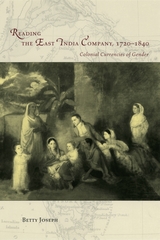 Reading the East India Company 1720-1840: Colonial Currencies of Gender
Betty Joseph
University of Chicago Press, 2003 In Reading the East India Company, Betty Joseph offers an innovative account of how archives—and the practice of archiving—shaped colonial ideologies in Britain and British-controlled India during the eighteenth and nineteenth centuries.
Drawing on the British East India Company's records as well as novels, memoirs, portraiture and guidebooks, Joseph shows how the company's economic and archival practices intersected to produce colonial "fictions" or "truth-effects" that strictly governed class and gender roles—in effect creating a "grammar of power" that kept the far-flung empire intact. And while women were often excluded from this archive, Joseph finds that we can still hear their voices at certain key historical junctures. Attending to these voices, Joseph illustrates how the writing of history belongs not only to the colonial project set forth by British men, but also to the agendas and mechanisms of agency—of colonized Indian, as well as European women. In the process, she makes a valuable and lasting contribution to gender studies, postcolonial theory, and the history of South Asia.
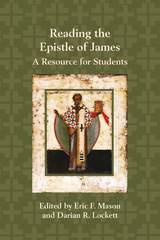 Reading the Epistle of James: A Resource for Students
Eric F. Mason
SBL Press, 2019 Foundational essays for students of New Testament epistles
This accessible introduction to contemporary scholarship on the Epistle of James begins with chapters that consider possible sources and backgrounds used by the author of James, the genre and literary structure of the book, and its major theological themes. Building on this foundation, subsequent chapters examine James through social-scientific readings, perspectives of Latin American immigrants and the marginalized, and major recent developments in textual criticism. The final chapters in the volume address the relationship between the epistle and the historical James, reception of the epistle in the early church, and major Catholic and Protestant interpretations of the book in the Reformation era. The contributions in this volume distill a range of important issues for readers undertaking a serious study of this letter for the first time.
Features
- An introduction to contemporary scholarship on this important but often-overlooked text
- Clear explanations of all technical terms and themes
- In-depth discussions of the importance of Jewish Scripture and interpretative traditions, Greco-Roman philosophy and Jewish wisdom motifs, and biblical perspectives on justice, wealth, and poverty
Reading the Epistle to the Hebrews
Eric F. Mason
SBL Press, 2011 This volume, designed for classroom use, reflects contemporary trends in the study of an important and complex biblical text. Essays address major interpretive issues and emphasize the importance of interpreting Hebrews in light of its ancient Jewish, Christian, and Greco-Roman contexts.
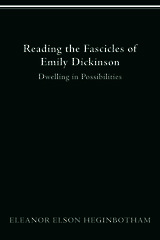 Reading the Fascicles of Emily Dickinson: Dwelling in Possibilities
Eleanor Elson Heginbotham
Ohio State University Press, 2020 Heginbotham’s book focuses on Emily Dickinson’s work as a deliberate writer and editor. The fascicles were forty small portfolios of her poems written between 1856 and 1864, composed on four to seven stationery sheets, folded, stacked, and sewn together with twine. What revelations might come from reading her poems in her own context? Are they simply “scrapbooks,” as some claim, or are they evidence of conscious, canny editing? Read in their original places, each lyric becomes different—and more interesting—than when read in isolation.
We cannot know why Dickinson compiled the books or what she thought of them, but we can observe what she left in them. What she left is visible only by noting the way the poem answers in a dialogue across the pages, the way lines spilling onto a second page introduce the next poem, the way openings suggest image clusters so that each book has its own network of concerns and language—not a story or philosophical preachment but an aesthetic wholeness.
This book is the first to demonstrate that Dickinson’s poetic and philosophical creativity is most startling when the reader observes the individual lyric in the poet’s own, and only, context for them. For teacher, student, scholar, and poetry lover, Heginbotham creates an important new framework for understanding one of the most complex, clever, and profound U.S. poets.
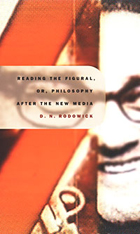 Reading the Figural, or, Philosophy after the New Media
D. N. Rodowick
Duke University Press, 2001 In Reading the Figural, or, Philosophy after the New Media D. N. Rodowick applies the concept of “the figural” to a variety of philosophical and aesthetic issues. Inspired by the aesthetic philosophy of Jean-François Lyotard, the figural defines a semiotic regime where the distinction between linguistic and plastic representation breaks down. This opposition, which has been the philosophical foundation of aesthetics since the eighteenth century, has been explicitly challenged by the new electronic, televisual, and digital media. Rodowick—one of the foremost film theorists writing today—contemplates this challenge, describing and critiquing the new regime of signs and new ways of thinking that such media have inaugurated. To fully comprehend the emergence of the figural requires a genealogical critique of the aesthetic, Rodowick claims. Seeking allies in this effort to deconstruct the opposition of word and image and to create new concepts for comprehending the figural, he journeys through a range of philosophical writings: Thierry Kuntzel and Marie-Claire Ropars-Wuilleumier on film theory; Jacques Derrida on the deconstruction of the aesthetic; Siegfried Kracauer and Walter Benjamin on the historical image as a utopian force in photography and film; and Gilles Deleuze and Michel Foucault on the emergence of the figural as both a semiotic regime and a new stratagem of power coincident with the appearance of digital phenomena and of societies of control. Scholars of philosophy, film theory, cultural criticism, new media, and art history will be interested in the original and sophisticated insights found in this book.
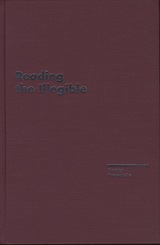 Reading the Illegible
Rainer Rumold
Northwestern University Press, 2003 A poet takes another's text, excises this, prints over that, cancels, erases, rearranges, defaces--and generally renders the original unreadable, at least in its original terms. What twentieth-century writers and artists have meant by such appropriations and violations, and how the "illegible" results are to be read, is the subject Craig Dworkin takes up in this ambitious work.
In his scrutiny of selected works, and with reference to a rich variety of textual materials--from popular and scientific texts to visual art, political and cultural theories, and experimental films--Dworkin proposes a new way of apprehending the radical formalism of so-called unreadable texts. Dworkin unveils what he describes as "the politics of the poem"--what is signified by its form, enacted by its structures, and implicit in the philosophy of language; how it positions its reader; and other questions relating to the poem as material object. In doing so, he exposes the mechanics and function of truly radical formalism as a practice that move beyond aesthetic considerations into the realms of politics and ideology. Reading the Illegible asks us to reconsider poetry as a physical act, and helps us to see how the range of a text's linguistic and political maneuvers depends to a great extent on the material conditions of reading and writing as well as the mechanics of reproduction.
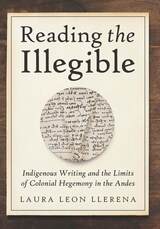 Reading the Illegible: Indigenous Writing and the Limits of Colonial Hegemony in the Andes
Laura Leon Llerena
University of Arizona Press, 2023 Reading the Illegible examines the history of alphabetic writing in early colonial Peru, deconstructing the conventional notion of literacy as a weapon of the colonizer. This book develops the concept of legibility, which allows for an in-depth analysis of coexisting Andean and non-Native media. The book discusses the stories surrounding the creation of the Huarochirí Manuscript (c. 1598–1608), the only surviving book-length text written by Indigenous people in Quechua in the early colonial period. The manuscript has been deemed “untranslatable in all the usual senses,” but scholar Laura Leon Llerena argues that it offers an important window into the meaning of legibility.
The concept of legibility allows us to reconsider this unique manuscript within the intertwined histories of literacy, knowledge, and colonialism. Reading the Illegible shows that the anonymous author(s) of the Huarochirí Manuscript, along with two contemporaneous Andean-authored texts by Joan de Santa Cruz Pachacuti and Felipe Guaman Poma de Ayala, rewrote the history of writing and the notion of Christianity by deploying the colonizers’ technology of alphabetic writing.
Reading the Illegible weaves together the story of the peoples, places, objects, and media that surrounded the creation of the anonymous Huarochirí Manuscript to demonstrate how Andean people endowed the European technology of writing with a new social role in the context of a multimedia society.
Reading the Literatures of Asian America
Shirley Geok-lin Lim
Temple University Press, 1992 With the recent proliferation of critically acclaimed literature by Asian American writers, this groundbreaking collection of essays provides a unique resource for students, scholars, and the general reading public. The homogeneity implied by the term "Asian American" is replaced in this volume with the rich diversity of highly disparate peoples. Languages, religions, races and cultural and national backgrounds. Examining a century of Asian American literature from the late 19th century up through the contemporary experimental drama of Ping Chong, the contributors address the work of writers with Chinese, Japanese, Korean, Vietnamese, Filipino, East Indian, and Pacific Island ancestry. Asian Canadian and Hawaiian literature are also considered.
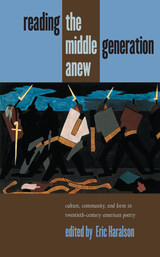 Reading the Middle Generation Anew: Culture, Community, and Form in Twentieth-Century American Poetry
Eric Haralson
University of Iowa Press, 2006 Ten original essays by advanced scholars and well-published poets address the middle generation of American poets, including the familiar—Robert Lowell, Elizabeth Bishop, Randall Jarrell, and John Berryman—and various important contemporaries: Delmore Schwartz, Theodore Roethke, Robert Hayden, and Lorine Niedecker. This was a famously troubled cohort of writers, for reasons both personal and cultural, and collectively their poems give us powerful, moving insights into American social life in the transforming decades of the 1940s through the 1960s.
In addition to having worked during the broad middle of the last century, these poets constitute the center of twentieth-century American poetry in the larger sense, refuting invidious connotations of “middle” as coming after the great moderns and being superseded by a proliferating postmodern experimentation. This middle generation mediates the so-called American century and its prodigious body of poetry, even as it complicates historical and aesthetic categorizations.
Taking diverse formal and thematic angles on these poets—deconstructionist, biographical-historical, and more formalist accounts—this book re-examines their between-ness and ambivalence: their various positionings and repositionings in aesthetic, political, and personal matters. The essays study the interplay between these writers and such shifting formations as religious discourse, consumerism, militarism and war, the ideology of America as “nature’s nation,” and U.S. race relations and ethnic conflicts. Reading the Middle Generation Anew also shows the legacy of the middle generation, the ways in which their lives and writings continue to be a shaping force in American poetry. This fresh and invigorating collection will be of great interest to literary scholars and poets.
 Reading the Mountains of Home
John Elder
Harvard University Press, 1998 Small farms once occupied the heights that John Elder calls home, but now only a few cellar holes and tumbled stone walls remain among the dense stands of maple, beech, and hemlocks on these Vermont hills. Reading the Mountains of Homeis a journey into these verdant reaches where in the last century humans tried their hand and where bear and moose now find shelter. As John Elder is our guide, so Robert Frost is Elder's companion, his great poem "Directive" seeing us through a landscape in which nature and literature, loss and recovery, are inextricably joined.
Over the course of a year, Elder takes us on his hikes through the forested uplands between South Mountain and North Mountain, reflecting on the forces of nature, from the descent of the glaciers to the rush of the New Haven River, that shaped a plateau for his village of Bristol; and on the human will that denuded and farmed and abandoned the mountains so many years ago. His forays wind through the flinty relics of nineteenth-century homesteads and Abenaki settlements, leading to meditations on both human failure and the possibility for deeper communion with the land and others.
An exploration of the body and soul of a place, an interpretive map of its natural and literary life, Reading the Mountains of Home strikes a moving balance between the pressures of civilization and the attraction of wilderness. It is a beautiful work of nature writing in which human nature finds its place, where the reader is invited to follow the last line of Frost's "Directive," to "Drink and be whole again beyond confusion."
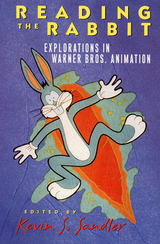 Reading the Rabbit: Explorations in Warner Bros. Animation
Sandler, Kevin S
Rutgers University Press, 1998 "A wide-ranging inquiry into an important area of contemporary scholarly interest, and also an engaging, well written and intelligently conceived collection." -Eric Smoodin, author of Animating Culture: Hollywood Cartoons From the Sound Era
Despite the success of Bugs Bunny, Daffy Duck, and their Looney cohorts, Warner Bros. animation worked in the shadow of Disney for many years. The past ten years have seen a resurgence in Warner Bros. animation as they produce new Bugs Bunny cartoons and theatrical features like Space Jam as well as television shows like Tiny Toon Adventures and Animaniacs. While Disney's animation plays it safe and mirrors traditional cinema stories, Warner Bros. is known for a more original and even anarchistic style of narration, a willingness to take risks in story construction, a fearlessness in crossing gender lines with its characters, and a freedom in breaking boundaries. This collection of essays looks at the history of Warner Bros. animation, compares and contrasts the two studios, charts the rise and fall of creativity and daring at Warner's, and analyzes the ways in which the studio was for a time transgressive in its treatment of class, race, and gender. It reveals how safety and commercialization have, in the end, triumphed at Warner Bros. just as they much earlier conquered Disney.
The book also discusses fan parodies of Warner Bros. animation on the Internet today, the Bugs Bunny cross-dressing cartoons, cartoons that were censored by the studio, and the merchandising and licensing strategies of the Warner Bros. studio stores. Contributors are Donald Crafton, Ben Fraser, Michael Frierson, Norman M. Klein, Terry Lindvall, Bill Mikulak, Barry Putterman, Kevin S. Sandler, Hank Sartin, Linda Simensky, Kirsten Moana Thompson, Gene Walz, and Timothy R. White.
 Reading the Renaissance: Black Women's Literary Reception and Taste in Chicago, 1932-1953
Mary I. Unger
University of Massachusetts Press, 2025 From 1932 to 1953, during the Black Chicago Renaissance, numerous literary events were held within and for the city’s Black community. In book clubs, public forums, print reviews, little magazines, local programming, and other public venues, Black women in particular debated the role of literature in racial uplift efforts, set literary standards, and acted as community gatekeepers for cultural production during a time known as the Black Chicago Renaissance. Through these inspiring efforts, a mix of publishers, well-known authors, and everyday readers significantly fostered a robust literary culture in the Windy City.
Reading the Renaissance constructs a reception history of the Black women who read and reviewed, published and promoted, and collected and curated literature of the era. Mary Unger interprets how local figures such as Vivian G. Harsh, Ora Morrow, Gwendolyn Brooks, Alice Browning, Fern Gayden, and Margaret Walker cultivated particular literary tastes through collective acts of reading and reception. She does so by recovering a network of readers, book clubs, literary magazines, civic programs, and book businesses that Black women created, led, and transformed during the early 1930s through the early 1950s in Bronzeville, Chicago’s predominantly Black South Side neighborhood.
This illuminating work includes close readings of texts alongside letters, scrapbooks, meeting minutes, reviews, and other ephemera of local reading practices to show how Black women facilitated diverse strategies of reading while instructing community members how to engage a variety of print cultures at the time. Unger demonstrates how Black women readers influenced individual authors as well as the norms and expectations of African American literature more broadly, becoming important (yet too often overlooked) players in American literary history.
Reading the River: A Voyage Down the Yukon
John Hildebrand
University of Wisconsin Press, 1997 “John Hildebrand sets out in a canoe . . . to explore the great riverway of northwestern Canada and Alaska. . . . The geography is closely rendered and the characters especially sharply drawn. The country is filled with mad dropouts at river fish camps, good-hearted girls in the towns, sullen natives in tumbledown villages, cranky old-timers, terrible drunks and worse moralizers who live off the wild landscape and its abundant resources. . . . This is a fine work, and Hildebrand is a fine writer.”—Charles E. Little, Wilderness
Reading the Room: A Bookseller's Tale
Paul Yamazaki
Prickly Paradigm Press, 2024 Reading the Room is Paul Yamazaki's love letter to the work of bookselling and an engaged life of the mind.
Over twenty-four hours, Paul Yamazaki leads us through the stacks of storied City Lights Booksellers in San Francisco; the care and prowess of his approach to book buying; his upbringing in a Japanese American family in Southern California and moving to San Francisco at the height of revolutionary foment; working with legendary figures in the book publishing industry like Lawrence Ferlinghetti, Sonny Mehta, and others; and his vision for the future of bookselling. Navigating building trust with readers and nurturing relationships across the literary industry, Yamazaki testifies to the value of generosity, sharing knowledge, and dialogue in a life devoted to books.
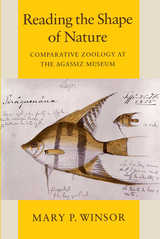 Reading the Shape of Nature: Comparative Zoology at the Agassiz Museum
Mary P. Winsor
University of Chicago Press, 1991 Reading the Shape of Nature vividly recounts the turbulent early history of the Museum of Comparative Zoology at Harvard and the contrasting careers of its founder Louis Agassiz and his son Alexander. Through the story of this institution and the individuals who formed it, Mary P. Winsor explores the conflicting forces that shaped systematics in the second half of the nineteenth century. Debates over the philosophical foundations of classification, details of taxonomic research, the young institution's financial struggles, and the personalities of the men most deeply involved are all brought to life.
In 1859, Louis Agassiz established the Museum of Comparative Zoology to house research on the ideal types that he believed were embodied in all living forms. Agassiz's vision arose from his insistence that the order inherent in the diversity of life reflected divine creation, not organic evolution. But the mortar of the new museum had scarcely dried when Darwin's Origin was published. By Louis Agassiz's death in 1873, even his former students, including his son Alexander, had defected to the evolutionist camp. Alexander, a self-made millionaire, succeeded his father as director and introduced a significantly different agenda for the museum.
To trace Louis and Alexander's arguments and the style of science they established at the museum, Winsor uses many fascinating examples that even zoologists may find unfamiliar. The locus of all this activity, the museum building itself, tells its own story through a wonderful series of archival photographs.
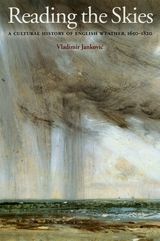 Reading the Skies: A Cultural History of English Weather, 1650-1820
Vladimir Jankovic
University of Chicago Press, 2001 From the time of Aristotle until the late eighteenth century, meteorology meant the study of "meteors"—spectacular objects in the skies beneath the moon, which included everything from shooting stars to hailstorms. In Reading the Skies, Vladimir Jankovic traces the history of this meteorological tradition in Enlightenment Britain, examining its scientific and cultural significance.
Jankovic interweaves classical traditions, folk/popular beliefs and practices, and the increasingly quantitative approaches of urban university men to understanding the wonders of the skies. He places special emphasis on the role that detailed meteorological observations played in natural history and chorography, or local geography; in religious and political debates; and in agriculture. Drawing on a number of archival sources, including correspondence and weather diaries, as well as contemporary pamphlets, tracts, and other printed sources reporting prodigious phenomena in the skies, this book will interest historians of science, Britain, and the environment.
Reading The Social Body
Catherine B. Burroughs
University of Iowa Press, 1993 The overarching argument of Reading the Social Body is that the body is cultural rather than “natural.” Some of the essays treat the social construction of bodies that have actually existed in human history; others discuss the representation of bodies in artistic contexts; all recognize that everything visible to the human body—from posture and costume to the width of an eyebrow or a smile—is determined by and shaped in response to a particular culture.
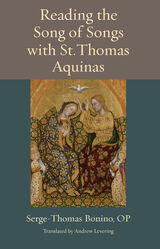 Reading the Song of Songs with St. Thomas Aquinas
Serge-Thomas Bonino
Catholic University of America Press, 2022 St. Thomas Aquinas never commented on the Song of Songs. The purpose of this book is to demonstrate, however, that he meditated on it and absorbed it, so that the words of the Song are for him a familiar repertoire and a theological source. His work contains numerous citations of the Song, not counting his borrowings of vocabulary and images from it. In total, there are 312 citations of the Song in Aquinas’s corpus, along with citations of the Song that are found in citations that Aquinas makes of other authors (as for example in the Catena aurea). Understanding the purpose and placement of these citations significantly enriches our understanding of Aquinas as a theologian, biblical exegete, and spiritual master. The book contains an Appendix listing and contextualizing each citation.
The study of the citations of the Song especially illuminates Aquinas’s spiritual doctrine. By citing the Song, Aquinas emphasizes the spiritual life’s path of dynamic ascent, through an ever increasing participation in the mystery of the nuptial union of Christ and the Church through love. The Song also highlights the eschatological tension or yearning present in the spiritual life, which is ordered to the fullness of beatific vision. Although Aquinas’s theology is highly “intellectual,” by citing the Song he brings out the affective character of the spiritual life and conveys the centrality of love in the soul’s journey toward Christ. He also draws together contemplation and preaching through his use of the Song.
Reading The Trail: Exploring The Literature And Natural History Of The California Crest
Corey Lee Lewis
University of Nevada Press, 2005 A provocative new way to read and interpret the classic works of John Muir, Mary Austin, and Gary Snyder, and to bring their ideas into the discussion of ecological values and the current environmental crisis. Lewis combines a perceptive discussion of their work and ideas with an engaging account of his own trail experiences as hiker/backpacker and volunteer trail builder, proposing that such a field-based, interdisciplinary approach to literary study and outdoors experience can enrich our appreciation for the work of nature writers.
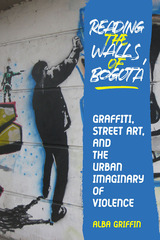 Reading the Walls of Bogota: Graffiti, Street Art, and the Urban Imaginary of Violence
Alba Griffin
University of Pittsburgh Press, 2023 A cultural imaginary is a structuring space through which collective understandings of cultural and society phenomena are formed, reproduced, and accepted as the norm. Reading the Walls of Bogotá uses graffiti and street art to explore the urban imaginaries of violence in Bogotá, Colombia. These artistic forms are produced and received in different ways in different areas of the city and offer an insight into citizens’ everyday experiences and perceptions of violence from the political, to the personal, to that of structural inequality. Through graffiti, in which critiques of memory, space, politics, and aesthetics are embedded, artists and their viewers form vernacular theories through which they interpret the world and the spaces they inhabit. By focusing on creative expression, Alba Griffin shows how Bogotá’s residents respond to imaginaries of violence, how they critique the norms, how they appropriate space to challenge or negotiate violence, and how they push back against inequality.
Reading "The Waste Land": Modernism and the Limits of Interpretation
Jewel Spears Brooker
University of Massachusetts Press, 1990 This study of T.S. Eliot's The Waste Land guides the reader through the poem line by line, taking into account a number of previous interpretations. Aims to offer a part-by-part analysis of the poem with periodic summations and a meditation on the limits of interpretation and the problematic nature of reading in the late 20th century.
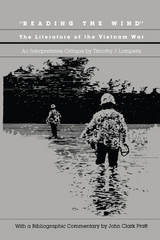 Reading the Wind: The Literature of the Vietnam War
Timothy J. Lomperis
Duke University Press, 1987 The decade following the American defeat in Vietnam has been filled with doubts about American politics and values, confusion over the lessons of the war, and anger about the physical and psychological suffering that occurred during the war as well as thereafter. In the years since the U.S. withdrawal, our need to make sense of Vietnam has prompted an outpouring of thinking and writing, from scholarly reappraisals of American foreign policy to highly personal accounts of participants. On the tenth anniversary of the final U. S. withdrawal, the Asia Society sponsored a conference on the Vietnam experience in American literature at which leading writers, critics, publishers, commentators, and academics wrestled with this phenomenon. Drawing on the synergy of this conference, Timothy J. Lomperis has produced an original work that focuses on the growing body of literature—including novels, personal accounts, and oral histories—which describes the experiences of American soldiers in Vietnam as well as the experience of veterans upon their return home.
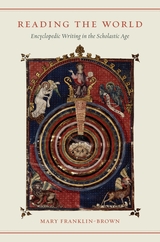 Reading the World: Encyclopedic Writing in the Scholastic Age
Mary Franklin-Brown
University of Chicago Press, 2012 The thirteenth century saw such a proliferation of new encyclopedic texts that more than one scholar has called it the “century of the encyclopedias.” Variously referred to as a speculum, thesaurus, or imago mundi—the term encyclopedia was not commonly applied to such books until the eighteenth century—these texts were organized in such a way that a reader could easily locate a collection of authoritative statements on any given topic. Because they reproduced, rather than simply summarized, parts of prior texts, these compilations became libraries in miniature. In this groundbreaking study, Mary Franklin-Brown examines writings in Latin, Catalan, and French that are connected to the encyclopedic movement: Vincent of Beauvais’s Speculum maius; Ramon Llull’s Libre de meravelles, Arbor scientiae, and Arbre de filosofia d’amor; and Jean de Meun’s continuation of the Roman de la Rose. Franklin-Brown analyzes the order of knowledge in these challenging texts, describing the wide-ranging interests, the textual practices—including commentary, compilation, and organization—and the diverse discourses that they absorb from preexisting classical, patristic, and medieval writing. She also demonstrates how these encyclopedias, like libraries, became “heterotopias” of knowledge—spaces where many possible ways of knowing are juxtaposed. But Franklin-Brown’s study will not appeal only to historians: she argues that a revised understanding of late medievalism makes it possible to discern a close connection between scholasticism and contemporary imaginative literature. She shows how encyclopedists employed the same practices of figuration, narrative, and citation as poets and romanciers, while much of the difficulty of the imaginative writing of this period derives from a juxtaposition of heterogeneous discourses inspired by encyclopedias. With rich and innovative readings of texts both familiar and neglected, Reading the World reveals how the study of encyclopedism can illuminate both the intellectual work and the imaginative writing of the scholastic age.
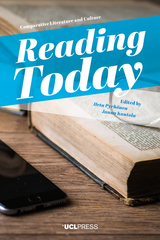 Reading Today
Edited by Heta Pyrhönen and Janna Kantola
University College London, 2018 Today we’re just as, if not more, likely to scroll, click, and tap the cold, shiny screen of a laptop, tablet, or smartphone as we are to turn the pages of a book. How has the advent of new technologies changed the way we read? Do our devices encourage quick and cursory reading? Is the experience of reading becoming “flatter” alongside the devices themselves? How have our conceptions changed of what reading is?
With Reading Today, Heta Pyrhönen and Janna Kantola have assembled contributions that respond to these questions and many more. The contributors unpack emerging strategies of reading. They consider, for example, how paying attention to our emotional reactions while reading can significantly affect how we experience the process. Other chapters consider the impacts of technology on reading through such topics as experimental literature, the contemporary encyclopedic novel, and the healing power of books.
Reading Together
Katarzyna Bartoszynska
Prickly Paradigm Press, 2025 A lively and thoughtful exploration of how book clubs change the way we read.
In this engaging and vivacious memoir, college professor Katarzyna Bartoszyńska thinks back on various book clubs she has been a part of. Through brief discussions of a variety of novels, memoirs, and nonfiction works such as Ottessa Moshfegh’s My Year of Rest and Relaxation, Marjane Satrapi’s Chicken with Plums, and Alma Guillermoprieto’s Dancing in Cuba, she considers how the things she has learned in book club discussions differ from what she tries to teach students in her literature classes. As she muses on the various benefits that we imagine reading offers, she describes the unique knowledge that book clubs can provide.
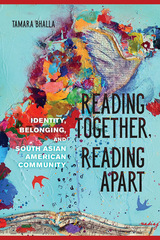 Reading Together, Reading Apart: Identity, Belonging, and South Asian American Community
Tamara Bhalla
University of Illinois Press, 2016 Often thought of as a solitary activity, the practice of reading can in fact encode the complex politics of community formation. Engagement with literary culture represents a particularly integral facet of identity formation--and expresses of a sense of belonging--within the South Asian diaspora in the United States.
Tamara Bhalla blends a case study with literary and textual analysis to illuminate this phenomenon. Her fascinating investigation considers institutions from literary reviews to the marketplace to social media and other technologies, as well as traditional forms of literary discussion like book clubs and academic criticism. Throughout, Bhalla questions how her subjects' circumstances, desires, and shared race and class, limit the values they ascribe to reading. She also examines how ideology circulating around a body of literature or a self-selected, imagined community of readers shapes reading itself and influences South Asians' powerful, if contradictory, relationship with ideals of cultural authenticity.
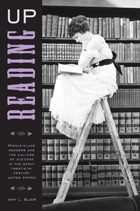 Reading Up: Middle-Class Readers and the Culture of Success in the Early Twentieth-Century United States
Amy Blair
Temple University Press, 2011 A person who reads a book for self-improvement rather than aesthetic pleasure is “reading up.” Reading Up is Amy Blair's engaging study of popular literary critics who promoted reading generally and specific books as vehicles for acquiring cultural competence and economic mobility. Combining methodologies from the history of the book and the history of reading, to mass-cultural studies, reader-response criticism, reception studies, and formalist literary analysis, Blair shows how such critics influenced the choices of striving readers and popularized some elite writers. Framed by an analysis of Hamilton Wright Mabie's role promoting the concept of “reading up” during his ten-year stint as the cultivator of literary taste for the highly popular Ladies' Home Journal, Reading Up reveals how readers flocked to literary works that they would be expected to dislike. Blair shows that while readers could be led to certain books by a trusted adviser, they frequently followed their own path in interpreting them in unexpected ways.
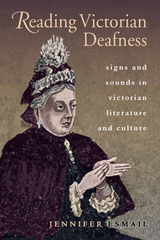 Reading Victorian Deafness: Signs and Sounds in Victorian Literature and Culture
Jennifer Esmail
Ohio University Press, 2013 Winner of the 2013 Sonya Rudikoff Award for best first book in Victorian Studies
Short-listed for the 2013 British Society for Literature and Science Book Prize. Reading Victorian Deafness is the first book to address the crucial role that deaf people, and their unique language of signs, played in Victorian culture. Drawing on a range of works, from fiction by Charles Dickens and Wilkie Collins, to poetry by deaf poets and life writing by deaf memoirists Harriet Martineau and John Kitto, to scientific treatises by Alexander Graham Bell and Francis Galton, Reading Victorian Deafness argues that deaf people’s language use was a public, influential, and contentious issue in Victorian Britain.
The Victorians understood signed languages in multiple, and often contradictory, ways: they were objects of fascination and revulsion, were of scientific import and literary interest, and were considered both a unique mode of human communication and a vestige of a bestial heritage. Over the course of the nineteenth century, deaf people were increasingly stripped of their linguistic and cultural rights by a widespread pedagogical and cultural movement known as “oralism,” comprising mainly hearing educators, physicians, and parents.
Engaging with a group of human beings who used signs instead of speech challenged the Victorian understanding of humans as “the speaking animal” and the widespread understanding of “language” as a product of the voice. It is here that Reading Victorian Deafness offers substantial contributions to the fields of Victorian studies and disability studies. This book expands current scholarly conversations around orality, textuality, and sound while demonstrating how understandings of disability contributed to Victorian constructions of normalcy. Reading Victorian Deafness argues that deaf people were used as material test subjects for the Victorian process of understanding human language and, by extension, the definition of the human.
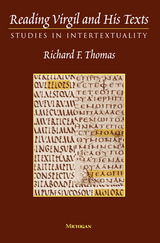 Reading Virgil and His Texts: Studies in Intertextuality
Richard F. Thomas
University of Michigan Press, 2000 There has long been vital interest in the ways that texts affect each other--through translation, imitation, parody, and other forms of emulation and subversion. Throughout the last two millennia, the Virgilian text has created its own intertextual heritage, persisting in the works of Eliot, Frost, Lowell, and Heaney. Richard F. Thomas's new volume demonstrates that such control and manipulation of the inherited tradition is to be found with great intensity in the very author who, in turn, created his own complex tradition.
The articles and notes included in this volume have been selected for their diachronic aspect in addition to the synchronic status they had in their original context. Dealing with the intricate ways in which Virgil, and in the introductory chapter his predecessor Catullus, manipulated and appropriated their inherited Greek and Roman literary tradition, this book presents a coherent profile, through these detailed studies, of the mechanics of one of the most dynamic periods in the literary history of any culture.
Richard Thomas--one of the most important voices in Latin literary studies today--shows little anxiety about objections to authorial intentionality. Throughout there is a working assumption that intertextual connections can be established and, further, that functions and purposes, even intended ones, may be inferred from those connections.
This book will be of interest to scholars and students of Greek and Latin literature but will also be of great value to students of medieval, Renaissance, and early modern vernacular literatures, most of whose poets see themselves as closely connected to Virgil.
Richard F. Thomas is Professor of Greek and Latin, Harvard University.
Reading With Clarice Lispector
Helene Cixous
University of Minnesota Press, 1990 Edited, translated, and introduced by Verena Andermatt Conley. The foremost French feminist literary critic pays homage to the premiere Latin American woman prose writer of this century.
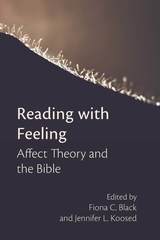 Reading with Feeling: Affect Theory and the Bible
Fiona C. Black
SBL Press, 2019 Essays with a methodological and metacritical focus
The psychological approach known as affect theory focuses on bodily feelings—depression, happiness, disgust, love—and can illuminate both texts and their interpretations. In this collection of essays scholars break new ground in biblical interpretation by deploying a range of affect-theoretical approaches in their interpretations of texts. Contributors direct their attention to the political, social, and cultural formation of emotion and other precognitive forces as a corrective to more traditional historical-critical methods and postmodern approaches. The inclusion of response essays results in a rich transdisciplinary dialog, with, for example, history, classics, and philosophy. Fiona C. Black, Amy C. Cottrill, Rhiannon Graybill, Jennifer L. Koosed, Joseph Marchal, Robert Seesengood, Ken Stone, and Jay Twomey engage a range of texts from biblical, to prayers, to graphic novels. Erin Runions and Stephen D. Moore’s responses push the conversation in new fruitful directions.
Features
- An overview of the development of affect theory and how it has been used to interpret biblical texts
- Examples of how to apply affect theory to biblical exegesis
- Interdisciplinary studies that engage history, literature, classics, animal studies, liturgical studies, philosophy, and sociology
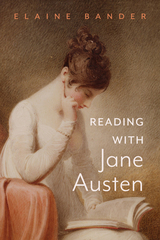 Reading with Jane Austen
Elaine Bander
Bucknell University Press, 2026 Jane Austen has more readers today than at any time in history. Many of Austen’s legions of fans, however, came to her novels after first seeing films or other adaptations made for twenty-first century audiences. Austen herself conversely spent her literary career undermining romantic clichés and rethinking novel conventions. Confident that she and her contemporaries shared a common reading culture, Austen deliberately constructed her novels to set readerly expectations, only to disrupt or confound those expectations by challenging her readers’ assumptions and values. In Reading with Jane Austen, Elaine Bander carefully rereads the great author’s novels—beginning with her late work of juvenilia, “Catharine, or The Bower,” and ending with her final fragment, “Sanditon”—against the rich context of late Georgian literary and intellectual culture. In doing so, Bander invites us into the transformative experience that Austen intentionally designed for her earliest readers, adding new layers of appreciation for those who love her work.
Published by Bucknell University Press. Distributed worldwide by Rutgers University Press.
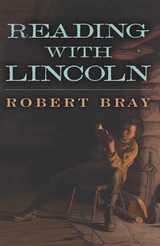 Reading With Lincoln
Robert Bray
Southern Illinois University Press, 2010 Through extensive reading and reflection, Abraham Lincoln fashioned a mind as powerfully intellectual and superlatively communicative as that of any other American political leader. Reading with Lincoln uncovers the how of Lincoln’s inspiring rise to greatness by connecting the content of his reading to the story of his life. At the core of Lincoln’s success was his self-education, centered on his love of and appreciation for learning through books. From his early studies of grammar school handbooks and children’s classics to his interest in Shakespeare’s Macbeth and the Bible during his White House years, what Lincoln read helped to define who he was as a person and as a politician. This unique study delves into the books, pamphlets, poetry, plays, and essays that influenced Lincoln’s thoughts and actions. Exploring in great depth and detail those readings that inspired the sixteenth president, author Robert Bray follows Lincoln’s progress closely, from the young teen composing letters for illiterate friends and neighbors to the politician who keenly employed what he read to advance his agenda. Bray analyzes Lincoln’s radical period in New Salem, during which he came under the influence of Anglo-American and French Enlightenment thinkers such as Thomas Paine, C. F. Volney, and Voltaire, and he investigates Lincoln’s appreciation of nineteenth-century lyric poetry, which he both read and wrote. Bray considers Lincoln’s fascination with science, mathematics, political economics, liberal social philosophy, theology, and the Bible, and devotes special attention to Lincoln’s enjoyment of American humor. While striving to arrive at an understanding of the role each subject played in the development of this remarkable leader, Bray also examines the connections and intertextual relations between what Lincoln read and how he wrote and spoke. This comprehensive and long-awaited book provides fresh insight into the self-made man from the wilderness of Illinois. Bray offers a new way to approach the mind of the political artist who used his natural talent, honed by years of rhetorical study and practice, to abolish slavery and end the Civil War.
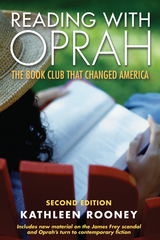 Reading with Oprah: The Book Club that Changed America
Kathleen Rooney
University of Arkansas Press, 2008 Adored by its fans, deplored by its critics, Oprah’s Book Club has been at the center of arguments about cultural authority and literary taste since it began in 1996. Reading with Oprah explores the club’s revolutionary fusion of books, television, and commerce and tells the engaging and in-depth story of the OBC phenomenon. Kathleen Rooney combines extensive research with a dynamic voice to reveal the club’s far-reaching cultural impact and its role as crucible for the clash between “high” and “low” literary taste. Comprehensive and up-to-date, the book covers the club from its inception in 1996, through the Jonathan Franzen contretemps, the surprising suspension in 2002, and, after the club’s return in 2003, the progression from “great books” to memoir. New material includes an extensive look at the James Frey scandal and Oprah’s turn to contemporary fiction, including The Road and Middlesex. Through close examination of Winfrey’s picks and personal interviews with book club authors and readers, Rooney demonstrates how the club that Barbara Kingsolver calls “one of the best possible uses of a television set” has, according to Wally Lamb, “gotten people of all ages to read, to read more, and to read widely.” First edition published in 2005.
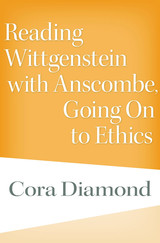 Reading Wittgenstein with Anscombe, Going On to Ethics
Cora Diamond
Harvard University Press, 2019 In Reading Wittgenstein with Anscombe, Going On to Ethics, Cora Diamond follows two major European philosophers as they think about thinking, as well as about our ability to respond to thinking that has miscarried or gone astray. Acting as both witness to and participant in the encounter, Diamond provides fresh perspective on the importance of the work of these philosophers and the value of doing philosophy in unexpected ways.
Diamond begins with the Tractatus (1921), in which Ludwig Wittgenstein forges a link between thinking about thought and the capacity to respond to misunderstandings and confusions. She then considers G. E. M. Anscombe’s An Introduction to Wittgenstein’s Tractatus (1959), in which Anscombe, through her engagement with Wittgenstein, further explores the limits of thinking and the ability to respond to thought that has gone wrong. Anscombe’s book is important, Diamond argues, in challenging contemporary assumptions about what philosophical problems are worth considering and about how they can be approached. Through her reading of the Tractatus, Anscombe exemplified an ethics of thinking through and against the grain of common preconceptions. The result drew attention to the questions that mattered most to Wittgenstein and conveyed with great power the nature of his achievement.
Diamond herself, in turn, challenges Anscombe on certain points, thereby further carrying out just the kind of ethical work Wittgenstein and Anscombe each felt was crucial to getting things right. Through her textured engagement with her predecessors, Diamond demonstrates what genuinely independent thought is able to achieve.
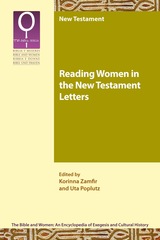 Reading Women in the New Testament Letters
Korinna Zamfir
SBL Press, 2024 This volume explores the differing views expressed in the New Testament letters about the position of women in first- and second-generation Christian communities. Contributors place the letters in their broader Jewish and Greco-Roman cultural, religious, and social contexts to better understand how gender roles, family life, and women’s responsibilities for spreading the gospel changed over time. While some essays envision the lived realities of women as wives, mothers, and widows—both the free and the enslaved, others examine the rhetorical and theological function of female metaphors. Contributors include Bernadette Brooten, Christine Gerber, Annette Bourland Huizenga, Marianne Bjelland Kartzow, Beate Kowalski, Dominika Kurek-Chomycz, Peter Lampe, William R. G. Loader, Elisa Estévez López, Heidrun E. Mader, Marinella Perroni, Silke Petersen, Uta Poplutz, María José Schultz Montalbetti, Michael Sommer, Angela Standhartinger, Miklós Szabó, Korinna Zamfir, and Silvia Zanconato.
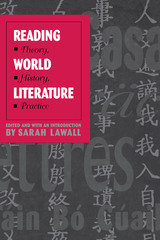 Reading World Literature: Theory, History, Practice
Edited by Sarah Lawall
University of Texas Press, 1994 As teachers and readers expand the canon of world literature to include writers whose voices traditionally have been silenced by the dominant culture, fundamental questions arise. What do we mean by "world"? What constitutes "literature"? Who should decide? Reading World Literature is a cumulative study of the concept and evolving practices of "world literature." Sarah Lawall opens the book with a substantial introduction to the overall topic. Twelve original essays by distinguished specialists run the gamut from close readings of specific texts to problems of translation theory and reader response. The sequence of essays develops from re-examinations of traditional canonical pieces through explorations of less familiar works to discussions of reading itself as a "literacy" dependent on worldview. Reading World Literature will open challenging new vistas for a wide audience in the humanities, from traditionalists to avant-garde specialists in literary theory, cultural studies, and area studies.
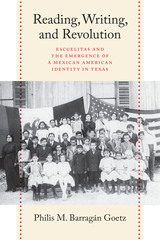 Reading, Writing, and Revolution: Escuelitas and the Emergence of a Mexican American Identity in Texas
By Philis M. Barragán Goetz
University of Texas Press, 2020 2022 National Association for Chicana and Chicano Studies Book Award
Tejas Foco Non-fiction Book Award, National Association for Chicana and Chicano Studies
2021 Tejano Book Prize, Tejano Genealogy Society of Austin
2021 Jim Parish Award for Documentation and Publication of Local and Regional History, Webb County Heritage Foundation
2021 Runner-up, Ramirez Family Award for Most Significant Scholarly Book The first book on the history of escuelitas, Reading, Writing, and Revolution examines the integral role these grassroots community schools played in shaping Mexican American identity.
Language has long functioned as a signifier of power in the United States. In Texas, as elsewhere in the Southwest, ethnic Mexicans’ relationship to education—including their enrollment in the Spanish-language community schools called escuelitas—served as a vehicle to negotiate that power. Situating the history of escuelitas within the contexts of modernization, progressivism, public education, the Mexican Revolution, and immigration, Reading, Writing, and Revolution traces how the proliferation and decline of these community schools helped shape Mexican American identity. Philis M. Barragán Goetz argues that the history of escuelitas is not only a story of resistance in the face of Anglo hegemony but also a complex and nuanced chronicle of ethnic Mexican cultural negotiation. She shows how escuelitas emerged and thrived to meet a diverse set of unfulfilled needs, then dwindled as later generations of Mexican Americans campaigned for educational integration. Drawing on extensive archival, genealogical, and oral history research, Barragán Goetz unravels a forgotten narrative at the crossroads of language and education as well as race and identity.
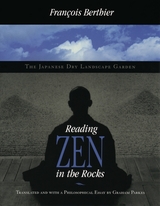 Reading Zen in the Rocks: The Japanese Dry Landscape Garden
François Berthier
University of Chicago Press, 2005 The Japanese dry landscape garden has long attracted—and long baffled—viewers from the West. While museums across the United States are replicating these "Zen rock gardens" in their courtyards and miniature versions of the gardens are now office decorations, they remain enigmatic, their philosophical and aesthetic significance obscured. Reading Zen in the Rocks, the classic essay on the karesansui garden by French art historian François Berthier, has now been translated by Graham Parkes, giving English-speaking readers a concise, thorough, and beautifully illustrated history of these gardens.
Berthier's guided tour of the famous garden of Ryoanji (Temple) in Kyoto leads him into an exposition of the genre, focusing on its Chinese antecedents and affiliations with Taoist ideas and Chinese landscape painting. He traces the roles of Shinto and Zen Buddhism in the evolution of the garden and also considers how manual laborers from the lowest classes in Japan had a hand in creating some of its highest examples. Parkes contributes an equally original and substantive essay which delves into the philosophical importance of rocks and their "language of stone," delineating the difference between Chinese and Japanese rock gardens and their relationship to Buddhism. Together, the two essays compose one of the most comprehensive and elegantly written studies of this haunting garden form.
Reading Zen in the Rocks is fully illustrated with photographs of all the major gardens discussed, making it a handsome addition to the library of anyone interested in gardening, Eastern philosophy, and the combination of the two that the karesansui so superbly represents.
Praise for the French edition:
"A small book of rare depth, remarkably illustrated, on one of the most celebrated and beautiful rock gardens of the monasteries of Kyoto."—L'Humanité
"Through Le Jardin de Ryoanji, Berthier teaches us to read the zen in the rocks, to discover the language offered by the garden at Ryoanji. Enigmatic, poetic, and disconcerting, an enriching journey through a work of art of surprising modernity, Le Jardin de Ryoanji is a work that will interest all the amateurs of Japanese art and Eastern philosophy."—Lien Horticole
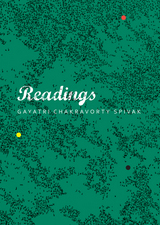 Readings
Gayatri Chakravorty Spivak
Seagull Books, 2014 Throughout her distinguished career, Gayatri Chakravorty Spivak has sought to locate and confront shifting forms of social and cultural oppression. As her work shows, the best method for doing so is through extended practice in the ethics of reading.
In Readings, Spivak elaborates a utopian vision for the kind of deep and investigative reading that can develop a will for peaceful social justice in coming generations. Through her own analysis of specific works, Spivak demonstrates modes in which such a vision might be achieved. In the examples here, she pays close attention to signposts of character, action, and place in J. M. Coetzee’s Summertime and Elizabeth Gaskell’s North and South. She also offers rereads of two of her own essays, addressing changes in her own thinking and practice over the course of her career. Now in her fifth decade of teaching, Spivak passes on her lessons through anecdote, interpretation, warning, and instruction to students and teachers of literature. She writes, “I urge students of English to understand that utopia does not happen, and yet to understand, also, their importance to the nation and the world. Indeed, I know how hard it is to sustain such a spirit in the midst of a hostile polity, but I urge the students to consider the challenge.”
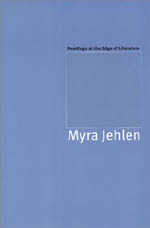 Readings at the Edge of Literature
Myra Jehlen
University of Chicago Press, 2002 Myra Jehlen's aim in these essays is to read for what she calls the edge of literature: the point at which writing seems unable to say more, which is also, for Jehlen, the threshold of the real. It is here, she argues, that the central paradoxes of the American project become clear—self-reliance and responsibility, universal equality and the pursuit of empire, writing from the heart and representing shared values and ideas. Developing these paradoxes to their utmost tension, American writers often produce penetrating critiques of American society without puncturing its basic myths. For instance, Mark Twain's Puddn'head Wilson begins as a slashing satire of racism, only to conclude by demonstrating that even an invisible portion of black blood can make a man a murderer.
Throughout these essays Jehlen demonstrates the crucial role that the process of writing itself plays in unfolding these paradoxes, whether in the form of novels by Harriet Beecher Stowe and Virginia Woolf; the histories of Captain John Smith; or even a work of architecture, such as the Guggenheim museum in Bilbao.
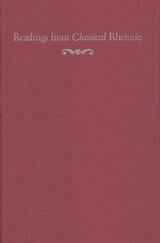 Readings from Classical Rhetoric
Edited by Patricia P. Matsen, Philip Rollinson, and Marion Sousa
Southern Illinois University Press, 1990 Here, for the first time in one volume, are all the extant writings focusing on rhetoric that were composed before the fall of Rome. This unique anthology of primary texts in classical rhetoric contains the work of 24 ancient writers from Homer through St. Augustine, including Herodotus, Thucydides, Plato, Aristotle, Cicero, Quintilian, Tacitus, and Longinus. Along with many widely recognized translations, special features include the first English translations of works by Theon and Nicolaus, as well as new translations of two works by important sophists, Gorgias’ encomium on Helen and Alcidamas’ essay on composition. The writers are grouped chronologically into historical periods, allowing the reader to understand the scope and significance of rhetoric in antiquity. Introductions are included to each period, as well as to each writer, with writers’ biographies, major works, and salient features of excerpts.
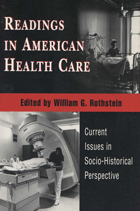 Readings In American Health Care: Current Issues In Socio-Historical Perspective
William G. Rothstein
University of Wisconsin Press, 1995 Readings in American Health Care is an introduction to the historical development and current status of a wide variety of health care topics. The readings, written by historians, sociologists, economists, physicians, nurses, and public health researchers, are organized in sections:
• Basic Concepts: mortality trends, concepts of disease, changes in medical therapy
• Public Health: AIDS, cigarette smoking, preventive medicine, fluoridation
• Health Care Professions: cardiology, pathology, women in medicine, nursing, podiatry, midwives
• Health Care Organizations: hospitals, HMOs
• Mental Illness
• Financing Health Care
• Medical Education
• Issues: abortion, ethical issues, cancer control, prenatal care, home care, the pharmaceutical industry
• Background Readings: American medicine from 1920 to midcentury.
The readings were chosen especially for course use in history, sociology, public health, and related fields, but can also provide useful background reading for anyone interested or involved in American health care. Each selection includes an introduction, questions for the reader, and a bibliography. Scholars and students alike will find the book an invaluable resource.
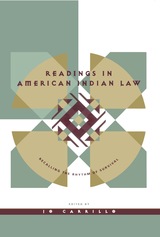 Readings In American Indian Law
Jo Carrillo
Temple University Press, 1998 This selection of works -- many by Native American scholars -- introduces selected topics in federal Indian law. Readings in American Indian Law covers contemporary issues of identity and tribal recognition; reparations for historic harms; the valuation of land in land claims; the return to tribal owners of human remains, sacred items, and cultural property; tribal governance and issues of gender, democracy informed by cultural awareness, and religious freedom.
Courses in federal Indian law are often aimed at understanding rules, not cultural conflicts. This book expands doctrinal discussions into understandings of culture, strategy, history, identity, and hopes for the future. Contributions from law, history, anthropology, ethnohistory, biography, sociology, socio-legal studies, and fiction offer an array of alternative paradigms as strong antidotes to our usual conceptions of federal Indian law.
Each selection reveals an aspect of how federal Indian law is made, interpreted, implemented, or experienced. Throughout, the book centers on the ever present and contentious issue of identity. At the point where identity and law intersect lies an important new way to contextualize the legal concerns of Native Americans.
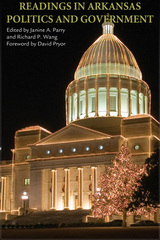 Readings in Arkansas Politics and Government
Janine A. Parry
University of Arkansas Press, 2009 Readings in Arkansas Politics and Government brings together in one volume some of the best available scholarly research, both new and not so new, on a wide range of topics and issues of interest to students of politics and government in the Natural State. The twenty-one articles are arranged in four sections, ranging from the state’s socioeconomic and political context to the workings of its policymaking institutions and the key policy puzzles facing the state in the early twenty-first century. Some of the topics covered include demographics, legislation, issues of church and state, the role of African Americans in the legislature, term limits, constitutional reform, civil rights, and education reform. Ideal for use in introductory and advanced undergraduate courses, the book will also appeal to lawmakers, administrators, journalists, and those interested in how politics and government work in the state.
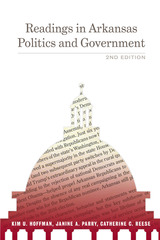 Readings in Arkansas Politics and Government
Kim U. Hoffman
University of Arkansas Press, 2020 This second edition of the authoritative Readings in Arkansas Politics and Government brings together in one volume some of the best available scholarly research on a wide range of issues of interest to students of Arkansas politics and government. The twenty-one chapters are arranged in three sections covering both historical and contemporary issues—ranging from the state’s socioeconomic and political context to the workings of its policymaking institutions and key policy concerns in the modern political landscape. Topics covered include racial tension and integration, social values, political corruption, public education, obstacles facing the state’s effort to reform welfare, and others. Ideal for use in introductory and advanced undergraduate courses, the book will also appeal to lawmakers, public administrators, journalists, and others interested in how politics and government work in Arkansas.
Readings in Chinese Literary Thought
Stephen Owen
Harvard University Press This dual-language compilation of seven complete major works and many shorter pieces from the Confucian period through the Ch’ing dynasty will be indispensable to students of Chinese literature. Stephen Owen’s masterful translations and commentaries have opened up Chinese literary thought to theorists and scholars of other languages.
Readings in Evaluation Research, 2ed
Francis G. Caro
Russell Sage Foundation, 1977 Affords a comprehensive overview of evaluative research, answering questions regarding the adequacy of organized programs in health, justice, education, employment, and welfare. Included are general statements about evaluative research, discussing the nature of the evaluative task, the role of evaluative research in programs for change, and appropriate methodological strategies. In this revised and expanded collection of readings, which includes more case materials and more illustrations of completed evaluations than the first edition, the editor presents a variety of viewpoints and a broad range of materials for the social planner, administrator, and social scientist.
 Readings in Interpretation: Holderlin, Hegel, Heidegger
Andrzej WarminskiIntroduction by Rodolphe Gasche
University of Minnesota Press, 1987 Readings in Interpretation was first published in 1987. Minnesota Archive Editions uses digital technology to make long-unavailable books once again accessible, and are published unaltered from the original University of Minnesota Press editions. Readings in Interpretation — a volume primarily on the texts of Holderlin, Hegel, and their interpreter Heidegger—locates itself strategically between literature and philosophy. In keeping with this juxtaposition, it treats the question of self-consciousness and reflection on the levels of "theme" and "text." For both Hegel and Holderlin, selfconsciousness and its relation to knowing are explicit themes, but Waminski's readings show that a more disruptive reflection is operative on the level of text. In an argument that centers on the textual aspects of Hegel's Phenomenology of the Spirit,Warminski demonstrates that the negative moment—which is often interpreted as a prelude to a unified self-consciousness—cannot be accounted for by interpretive models drawn from outside the text—by concepts like the self, consciousness, or the subject. Instead, a completely different practice and theory is necessary. The author's "Prefatory Postscript" at the beginning of the book therefore serves as an introduction to sketch the theoretical basis of the readings that follow and as a "postscript" that explains the difference between "reading" and "interpretation" which those readings make necessary.
Readings in Japanese Natural Language Processing
Edited by Francis Bond, et al.
CSLI, 2014 Readings in Japanese Natural Language Processing surveys a wide range of texts that explore Japanese morphology and syntactic analysis, discourse, and natural language process applications. Presenting such techniques in a manner accessible to those with little or no familiarity with Japanese, these carefully selected papers will broaden the scope of our study of Japanese linguistic phenomena, making this collection indispensable in the field.
Readings in Linguistics I & II
Edited by Eric P. Hamp, Martin Joos, Fred W. Householder, and Robert Austerlitz
University of Chicago Press, 1995 This volume, consisting of nineteen articles from Readings in Linguistics I and twenty articles from Readings in Linguistics II, constitutes an invaluable collection of papers in English, German, and French on subjects of continuing interest to linguists of all schools. Complete with a new preface explaining the editors' principles of selection and bibliographical citations, Readings in Linguistics I & II includes the influential work of Bloomfield, Trubetzkoy, Firth, Harris, and Kurylowicz, as well as important but less accessible articles by Vachek, Bazell, Chao, Fischer-Jorgensen, and Tesniere.
Readings in Managerial Psychology
Edited by Harold J. Leavitt, Louis R. Pondy, and David M. Boje
University of Chicago Press, 1988 With more than half the papers new to this book, the fourth edition of Readings in Managerial Psychology represents a substantial revision of this popular text. This edition focuses more than ever on the managing process, both within and between organizations, and such "soft" issues as managing creativity and imagination, managers' values and beliefs, and organizational culture play a larger role than they have before.
Readings in Managerial Psychology is designed for managers in business and industry, students of management, public and university administrators, and executives in other organizations. The collection can be used independently or as a companion volume to Harold J. Leavitt and Homa Bahrami's Managerial Psychology: Managing Behavior in Organizations (5th edition, 1988), also published by the University of Chicago Press.
Readings in Philosophy of Psychology
Ned Block
Harvard University Press, 1980 In this introduction to the philosophical problems underlying the modern study of mind and behavior, Ned Block has collected the most important papers by the major figures in the field. He provides the only central reference work now available for scholars and students in this growing area of inquiry.
Volume I covers general approaches to the study of the mind: behaviorism, reductionism, and functionalism. Volume II addresses the central topics in modern cognitive science: mental representation, imagery, grammar and innate ideas.
Readings in Philosophy of Psychology
Ned Block
Harvard University Press, 1980 This book of readings provides a complete introduction to the philosophical problems underlying the modern study of mind and behavior. The first volume covered general approaches to the study of mind. This second volume addresses the central topics in modern cognitive science: mental representation, imagery, grammar and innate ideas.
Readings in Primary Art Education
Edited by Steve Herne, Sue Cox, and Robert Watts
Intellect Books, 2009 Readings in Primary Art Education focuses on the challenges of and approaches to teaching art to primary-school students. Drawn from articles originally published in the International Journal of Art and Design, this volume gathers the work of the best scholars in the field and provides a critical framework for developing methods of teaching art to young students. Capturing the key issues and debates that are shaping both curricula and practice, Readings in Primary Art Education is an essential starting point for anyone involved in art education. This collection of essays will be a welcome addition to art and design education and will be of interest to those active in primary art and design education, including practicing teachers and scholars.
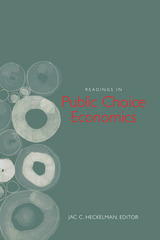 Readings in Public Choice Economics
Jac C. Heckelman, Editor
University of Michigan Press, 2004 The first classroom book for undergraduate courses in public choice analysis, covering both political economy and social choice issues
Public choice analysis applies the methodology of economics to issues in political science and the policy process. The readings in this anthology cover topics in both institutional political economy and social choice theory and are comprehensible to nonspecialists and advanced undergraduates with a background in basic economic theory. Readings are taken from academic journals and book chapters and are reproduced in their entirety. They are selected to ensure they contain a minimal amount of notation and are free of advanced econometrics.
The anthology contains two to three readings each to explore the areas of rent seeking, collective action, bureaucracy, elections and the economy, choosing decision rules, majority rule, alternative voting procedures, and the calculus of voting. Each part contains a brief introduction to the general theme, and questions are presented as a guide to each reading. Additional suggested readings are provided to develop these concepts further.
Jac C. Heckelman is Associate Professor of Economics, Wake Forest University.
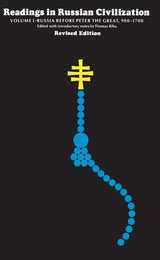 Readings in Russian Civilization Volume I: Russia before Peter the Great, 900-1700
Edited by Thomas Riha
University of Chicago Press, 1969 "This new and enlarged version of Readings in Russian Civilization is the result of fairly extensive revisions. There are now 72 instead of 64 items; 20 of the selections are new. The first volume has undergone the least change with 3 new items, of which 2 appear in English for the first time. In the second volume there are 6 new items; all of them appear in English for the first time. The third volume has undergone the greatest revision, with 11 new items, of which 6 are newly translated from the Russian. It is the editor's hope that items left out in the new edition will not be sorely missed, and that the new selections will turn out to be useful and illuminating. The aim, throughout, has been to cover areas of knowledge and periods which had been neglected in the first edition, and to include topics which are important in the study of the Russian past and present.
"The bibliographical headnotes have been enlarged, with the result that there are now approximately twice as many entries as in the old edition. New citations include not only works which have appeared since 1963, but also older books and articles which have come to the editor's attention."—From the Editor's Preface
". . . a judicious combination of seminal works and more recent commentaries that achieves the editor's purpose of stimulating curiosity and developing a point of view."—C. Bickford O'Brien, The Russian Review
"These three volumes cover quite well the main periods of Russian civilization. The choice of the articles and other material is made by a competent and unbiased scholar."—Ivan A. Lopatin, Professor of Asian and Slavic Studies, University of Southern California
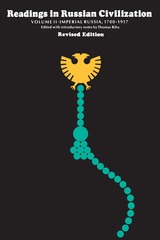 Readings in Russian Civilization Volume II: Imperial Russia, 1700-1917
Edited by Thomas Riha
University of Chicago Press, 1969 "This new and enlarged version of Readings in Russian Civilization is the result of fairly extensive revisions. There are now 72 instead of 64 items; 20 of the selections are new. The first volume has undergone the least change with 3 new items, of which 2 appear in English for the first time. In the second volume there are 6 new items; all of them appear in English for the first time. The third volume has undergone the greatest revision, with 11 new items, of which 6 are newly translated from the Russian. It is the editor's hope that items left out in the new edition will not be sorely missed, and that the new selections will turn out to be useful and illuminating. The aim, throughout, has been to cover areas of knowledge and periods which had been neglected in the first edition, and to include topics which are important in the study of the Russian past and present.
"The bibliographical headnotes have been enlarged, with the result that there are now approximately twice as many entries as in the old edition. New citations include not only works which have appeared since 1963, but also older books and articles which have come to the editor's attention."—From the Editor's Preface
". . . a judicious combination of seminal works and more recent commentaries that achieves the editor's purpose of stimulating curiosity and developing a point of view."—C. Bickford O'Brien, The Russian Review
"These three volumes cover quite well the main periods of Russian civilization. The choice of the articles and other material is made by a competent and unbiased scholar."—Ivan A. Lopatin, Professor of Asian and Slavic Studies, University of Southern California
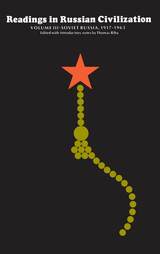 Readings in Russian Civilization Volume III: Soviet Russia, 1917-1963
Edited by Thomas Riha
University of Chicago Press, 1969 "This new and enlarged version of Readings in Russian Civilization is the result of fairly extensive revisions. There are now 72 instead of 64 items; 20 of the selections are new. The first volume has undergone the least change with 3 new items, of which 2 appear in English for the first time. In the second volume there are 6 new items; all of them appear in English for the first time. The third volume has undergone the greatest revision, with 11 new items, of which 6 are newly translated from the Russian. It is the editor's hope that items left out in the new edition will not be sorely missed, and that the new selections will turn out to be useful and illuminating. The aim, throughout, has been to cover areas of knowledge and periods which had been neglected in the first edition, and to include topics which are important in the study of the Russian past and present.
"The bibliographical headnotes have been enlarged, with the result that there are now approximately twice as many entries as in the old edition. New citations include not only works which have appeared since 1963, but also older books and articles which have come to the editor's attention."—From the Editor's Preface
". . . a judicious combination of seminal works and more recent commentaries that achieves the editor's purpose of stimulating curiosity and developing a point of view."—C. Bickford O'Brien, The Russian Review
"These three volumes cover quite well the main periods of Russian civilization. The choice of the articles and other material is made by a competent and unbiased scholar."—Ivan A. Lopatin, Professor of Asian and Slavic Studies, University of Southern California
 Readings on Fascism and National Socialism
University of Colorado, Dept. of Philosophy
Ohio University Press, 1952 The catastrophe and holocaust brought about by the two powerful movements of fascism and national socialism will mark human life always. Now, as we feel our hatred for them, we find it difficult to understand how they could have been so powerful, how they could have appealed so strongly to millions of people of a modern age. To understand our own times, it is necessary to understand these movements. And to understand them, we must read the basic philosophical and political documents which show the force of the ideas which moved a world to the brink of disaster. This collection of readings has been selected to encourage students to clarify their thinking on social philosophy. They will accordingly need to determine whether the readings contain more or less coherent body of ideas which constitutes a social philosophy. They will also need to raise the more far-reaching question of whether the ideas are acceptable. To arrive at any satisfactory answer to this latter question, they will necessarily have to compare the ideas of fascism and their practical meanings with the alternatives, real and ideal, that are the substance of live philosophical issues.
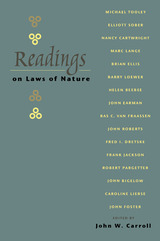 Readings On Laws Of Nature
John W. Carroll
University of Pittsburgh Press, 2004
As a subject of inquiry, laws of nature exist in the overlap between metaphysics and the philosophy of science. Over the past three decades, this area of study has become increasingly central to the philosophy of science. It also has relevance to a variety of topics in metaphysics, philosophy of mind, philosophy of language, and epistemology.
Readings on Laws of Nature is the first anthology to offer a contemporary history of the problem of laws. The book is organized around three key issues: the matter of distinguishing laws from mere correlations, questions concerning inductive reasoning and laws, and the consideration of whether there are any true laws in science.
Designed for class use, the anthology covers a remarkably broad range of views and concerns, and consists exclusively of articles that have proved highly influential in the field. Readings on Laws of Nature will also serve as a valuable research and reference tool for philosophers who do not specialize in the subject, but who have occasion to examine concepts relating to the laws of nature in their own work.
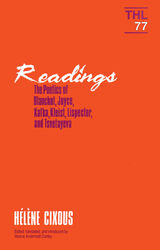 Readings: The Poetics of Blanchot, Joyce, Kakfa, Kleist, Lispector, and Tsvetayeva
Helene Cixous
University of Minnesota Press, 1991 Readings: The Poetics of Blanchot, Joyce, Kafka, Kleist, Lispector, and Tsvetayeva offers striking and novel textual studies of major literary figures and emergent authors. Selected from Cixous’s seminars taught between 1980 and 1986 at the Universite de Paris VII (Saint-Denis) and at the College International de Philosophie, the texts chronicle the French intellectual scene with its shifting tastes over the decade following May 1986. In their simple and accessible language, the texts can be read as inspiration for Cixous’s fictional and critical practices. They not only introduce readers to emergent texts from Brazil and Russia, such as Clarice Lispector’s “Foreign Legion” and Marina Tsvetayeva’s “Mother and Music,” but also give new, incisive insights into Joyce’s Portrait of the Artist and Kafka’s “Before the Law.” Drawing from philosophy and psychoanalysis, Readings: The Poetics of Blanchot, Joyce, Kafka, Kleist, Lispector, and Tsvetayeva can be read side-by-side with Reading with Clarice Lispector, as an ongoing meditation on ethics and poetics.Also from MinnesotaReading with Clarice LispectorHelene CixousEdited, translated, and introduced by Verena Andermatt ConleyFor Cixous, Lispector’s work represents one of the finest examples of ecriture feminine in that she practices, in writing, what Cixous is searching for in her theoretical practice: the giving, spending, and inscribing of pleasure; an apprenticeship in the lessons of life.Theory and History of Literature, volume 73
The Reading-Writing Connection
Edited by Nancy Nelson and Robert C. Calfee
University of Chicago Press, 1998 This volume shows that the separation of the teaching of reading and writing has been a dominant feature of educational practice at the elementary and secondary levels since colonial times. The editors identify current movements in education that have fostered connections between reading and writing as well as those that tend to push them apart.
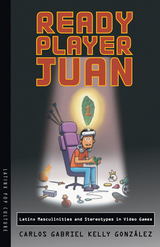 Ready Player Juan: Latinx Masculinities and Stereotypes in Video Games
Carlos Gabriel Kelly González
University of Arizona Press, 2023 Written for all gaming enthusiasts, this book fuses Latinx studies and video game studies to document how Latinx masculinities are portrayed in high-budget action-adventure video games, inviting Latinxs and others to insert their experiences into games made by an industry that fails to see them.
The book employs an intersectional approach through performance theory, border studies, and lived experience to analyze the designed identity “Player Juan.” Player Juan manifests in video game representations through a discourse of criminality that sets expectations of who and what Latinxs can be and do. Developing an original approach to video game experiences, the author theorizes video games as border crossings, and defines a new concept—digital mestizaje—that pushes players, readers, and scholars to deploy a Latinx way of seeing and that calls on researchers to consider a digital object’s constructive as well as destructive qualities.
 Ready Player Two: Women Gamers and Designed Identity
Shira Chess
University of Minnesota Press, 2017 Cultural stereotypes to the contrary, approximately half of all video game players are now women. A subculture once dominated by men, video games have become a form of entertainment composed of gender binaries. Supported by games such as Diner Dash, Mystery Case Files, Wii Fit, and Kim Kardashian: Hollywood—which are all specifically marketed toward women—the gamer industry is now a major part of imagining what femininity should look like. In Ready Player Two, media critic Shira Chess uses the concept of “Player Two”—the industry idealization of the female gamer—to examine the assumptions implicit in video games designed for women and how they have impacted gaming culture and the larger society. With Player Two, the video game industry has designed specifically for the feminine ideal: she is white, middle class, heterosexual, cis-gendered, and abled. Drawing on categories from time management and caregiving to social networking, consumption, and bodies, Chess examines how games have been engineered to shape normative ideas about women and leisure. Ready Player Two presents important arguments about how gamers and game developers must change their thinking about both women and games to produce better games, better audiences, and better industry practices. Ultimately, this book offers vital prescriptions for how one of our most powerful entertainment industries must evolve its ideas of women.
 Readying the Revolution: African American Theater and Performance from Post-World War II to the Black Arts Movement
Jonathan Shandell
University of Michigan Press, 2025 Starting in 1966, African American activist Stokely Carmichael and other political leaders adopted the phrase "Black Power!" The slogan captured a militant, revolutionary spirit that was already emerging in the work of playwrights, poets, musicians, and visual artists throughout the Black Arts movement of the mid-1960s. But the story of those theater artists and performers whose work helped bring about the Black Arts revolution has not fully been told. Readying the Revolution: African American Theater and Performance from Post-World War II to the Black Arts Movement explores the dynamic era of Black culture between the end of World War II and the start of the Black Arts Movement (1946-1964) by illuminating how artists and innovators such as Jackie Robinson, Lorraine Hansberry, Ossie Davis, Nina Simone, and others helped radicalize Black culture and Black political thought. In doing so, these artists defied white cultural hegemony in the United States, and built the foundation for the revolutionary movement in Black theater that followed in the mid 1960s. Through archival research, close textual reading, and an analysis of performance artifacts, Shandell demonstrates how these artists negotiated a space on the public stage for cultivating radical Black aesthetics and built the foundation for the revolutionary movement in Black theater that followed in the mid-1960s.
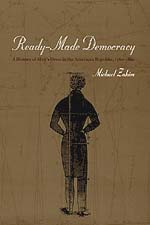 Ready-Made Democracy: A History of Men's Dress in the American Republic, 1760-1860
Michael Zakim
University of Chicago Press, 2003 Ready-Made Democracy explores the history of men's dress in America to consider how capitalism and democracy emerged at the center of American life during the century between the Revolution and the Civil War. Michael Zakim demonstrates how clothing initially attained a significant place in the American political imagination on the eve of Independence. At a time when household production was a popular expression of civic virtue, homespun clothing was widely regarded as a reflection of America's most cherished republican values: simplicity, industriousness, frugality, and independence.
By the early nineteenth century, homespun began to disappear from the American material landscape. Exhortations of industry and modesty, however, remained a common fixture of public life. In fact, they found expression in the form of the business suit. Here, Zakim traces the evolution of homespun clothing into its ostensible opposite—the woolen coats, vests, and pantaloons that were "ready-made" for sale and wear across the country. In doing so, he demonstrates how traditional notions of work and property actually helped give birth to the modern industrial order. For Zakim, the history of men's dress in America mirrored this transformation of the nation's social and material landscape: profit-seeking in newly expanded markets, organizing a waged labor system in the city, shopping at "single-prices," and standardizing a business persona.
In illuminating the critical links between politics, economics, and fashion in antebellum America, Ready-Made Democracy will prove essential to anyone interested in the history of the United States and in the creation of modern culture in general.
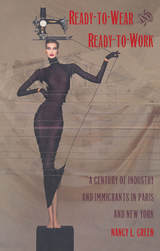 Ready-to-Wear and Ready-to-Work: A Century of Industry and Immigrants in Paris and New York
Nancy L. Green
Duke University Press, 1997 Nancy L. Green offers a critical and lively look at New York’s Seventh Avenue and the Parisian Sentier in this first comparative study of the two historical centers of the women’s garment industry. Torn between mass production and "art," this industry is one of the few manufactauring sectors left in the service-centered cities of today. Ready-to-Wear and Ready-to-Work tells the story of urban growth, the politics of labor, and the relationships among the many immigrant groups who have come to work the sewing machines over the last century.
Green focuses on issues of fashion and fabrication as they involve both the production and consumption of clothing. Traditionally, much of the urban garment industry has been organized around small workshops and flexible homework, and Green emphasizes the effect this labor organization had on the men and mostly women who have sewn the garments. Whether considering the immigrant Jews, Italians, Puerto Ricans, Dominicans, and Chinese in New York or the Chinese-Cambodians, Turks, Armenians, and Russian, Polish, and Tunisian Jews in Paris, she outlines similarities of social experience in the shops and the unions, while allowing the voices of the workers, in all their diversity to be heard.
A provocative examination of gender and ethnicity, historical conflict and consensus, and notions of class and cultural difference, Ready-to-Wear and Ready-to-Work breaks new ground in the methodology of comparative history.
Reagan and Public Discourse in America
Michael Weiler
University of Alabama Press, 1992 A critical assessment of the impact of the administration of President Ronald Reagan on public discourse in the United States
The authors show that more than any president since John F. Kennedy, Reagan’s influence flowed from his rhetorical practices. And he is remembered as having reversed certain trends and cast the U.S. on a new course. The contributors to this insightful collection of essays show that Reagan’s rhetorical tactics were matters of primary concern to his administration’s chief political strategists.
The Reagan Range: The Nostalgic Myth in American Politics
James Combs
University of Wisconsin Press, 1993 This book is an attempt to make sense out of Ronald Reagan by linking him to various grassroots dimensions of American popular mythology and mind. It attempts to utilize a variety of sources from American and popular culture studies, works on Reagan, and popular materials such as movies to offer an interpretation of reagan as an exemplar of the political relevance and power of popular culture.
The Reagan Reversal: Foreign Policy and the End of the Cold War
Beth A. Fischer
University of Missouri Press, 2000 It is often assumed that Ronald Reagan's administration was reactive in bringing about the end of the cold war, that it was Mikhail Gorbachev's "new thinking" and congenial personality that led the administration to abandon its hard- line approach toward Moscow. In The Reagan Reversal, now available in paperback, Beth A. Fischer convincingly demonstrates that President Reagan actually began seeking a rapprochement with the Kremlin fifteen months before Gorbachev took office. She shows that Reagan, known for his long-standing antipathy toward communism, suddenly began calling for "dialogue, cooperation, and understanding" between the superpowers. This well-written and concise study challenges the conventional wisdom about the president himself and reveals that Reagan was, at times, the driving force behind United States-Soviet policy.
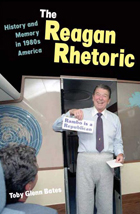 The Reagan Rhetoric: History and Memory in 1980s America
Toby Glenn Bates
Northern Illinois University Press, 2011
The Reagan Rhetoric examines the extraordinary connections between President Ronald Reagan’s conversations with the American people and the profound changes that swept the nation under those conversations’ influence. Through the lens of history, rhetoric, and memory, Bates’s work draws connections between the style, manner, and consistency of Reagan’s oratory and the social and cultural settings in which it played so vital a role. Specifically focusing on the 1980 Neshoba County Mississippi Campaign visit, the popular culture memory of the Vietnam War, and the controversy of Iran-Contra, this book illustrates Reagan’s sweeping ability to change how Americans thought about themselves, their past, and their politics. By concluding with an examination of media coverage of Reagan’s 2004 death, Bates reveals that certain interpretations Reagan rhetorically offered during his presidency had become an accepted collective memory for millions of Americans. In death, as in life, Reagan had the last word.
Through extensive archival research, the careful examination of well-known and obscure 1980s print media and popular culture, as well as new interviews, Bates challenges the prevailing Reagan historiography and provides a thoughtful reality check on some of the traditional views of his eight years in the Oval Office. The Reagan Rhetoric offers new and important contributions to Reagan studies that will appeal to scholars of the 40th president. This look at the 1980s will be of great interest to the growing number of historians studying that decade.
 Reaganism and the Death of Representative Democracy
Walter Williams
Georgetown University Press, 2003 This is a reasoned but passionate look at how Reaganism—the political philosophy of Ronald Reagan—has severely damaged representative democracy as created by the nation's founders. According to Williams, Reagan and his foremost disciple George W. Bush have created a plutocracy where the United States is no longer a government of the people, by the people, and for the people but is ruled by the wealthiest individuals and corporate America. Refreshingly unafraid to point out that Reaganism's anti-government fundamentalism stands on feet of clay, Walter Williams asks that Americans move from their political apathy to pay attention to the politicians and the corporations lurking behind the power curtain to see the dangers they represent to the true essential of the American way of life. Williams' most important contribution is his extended analysis of the central role the key institutions—the presidency, Congress, the federal agencies—must play for the U.S. government to be capable in both sustaining representative democracy and protecting the safety and economic security of the American people. A clear result of the weakened institutions has been the grossly inadequate homeland security effort following September 11, and the massive corporate fraud revealed by Enron and other large firms that robbed the nation of hundreds of billions of dollars in stock values and depleted the pension savings of millions of people. The initial destructive blow that damaged the institutions of governance can be traced to Ronald Reagan and his simplistic antigovernment philosophy that fostered rapacious business practices and personal greed. The book also takes the media to task, criticizing the dismal record of failing to investigate the political and corporate chicanery that has brought us to this pass. Keenly argued and scrupulously documented, Walter Williams has written a stinging wake-up call to the dangers of the demise of representative democracy and the rise of plutocracy that American citizens can ignore only at their peril.
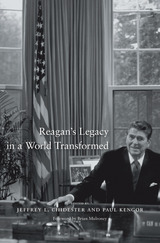 Reagan's Legacy in a World Transformed
Jeffrey L. Chidester
Harvard University Press, 2015 Since Ronald Reagan left office in 1989, the global community has witnessed the collapse of the Soviet Union and the integration of Europe, the War on Terror and the Arab Spring, a hot Chinese economy and a major international recession. Reagan’s Legacy in a World Transformed brings together scholars from diverse disciplines and persuasions to assess the fortieth president’s policies and their ongoing impact today, and to offer a timely retrospective on his complex legacy.
The authors consider the influence of Reagan’s free-market ideas on economic globalization, showing how deregulation succeeded in spurring economic expansion. In foreign policy, Reagan favored significant increases in military spending (“peace through strength”) and an assertive agenda abroad. His break with détente in dealing with the Soviet Union, notably expressed in his 1982 March of Freedom speech, effectively restored the early Cold War strategy of rolling back communism. More than twenty years later, President George W. Bush invoked this speech in describing his goals in the Middle East—a striking example of how Reagan’s ideas affected the post-9/11 world.
In contrast with his hawkish stance on defense, Reagan’s efforts to reduce nuclear arsenals, negotiated with Mikhail Gorbachev, constitute one of his enduring contributions to stability. Although Reagan’s policies soared on rhetoric rooted in ideological conviction, the president engaged in pragmatic internationalism when a multilateral approach served America’s interests. He believed that America had a special mission as a moral leader and beacon of freedom, a view that continues to inform U.S. foreign policy.
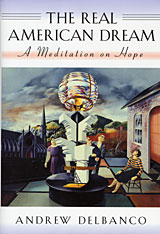 The Real American Dream: A Meditation on Hope
Andrew Delbanco
Harvard University Press, 1999 Since we discovered that, in Tocqueville’s words, “the incomplete joys of this world will never satisfy the heart,” how have we Americans made do? In The Real American Dream one of the nation’s premier literary scholars searches out the symbols and stories by which Americans have reached for something beyond worldly desire. A spiritual history ranging from the first English settlements to the present day, the book is also a lively, deeply learned meditation on hope.
Andrew Delbanco tells of the stringent God of Protestant Christianity, who exerted immense force over the language, institutions, and customs of the culture for nearly 200 years. He describes the falling away of this God and the rise of the idea of a sacred nation-state. And, finally, he speaks of our own moment, when symbols of nationalism are in decline, leaving us with nothing to satisfy the longing for transcendence once sustained by God and nation.
From the Christian story that expressed the earliest Puritan yearnings to New Age spirituality, apocalyptic environmentalism, and the multicultural search for ancestral roots that divert our own, The Real American Dream evokes the tidal rhythm of American history. It shows how Americans have organized their days and ordered their lives—and ultimately created a culture—to make sense of the pain, desire, pleasure, and fear that are the stuff of human experience. In a time of cultural crisis, when the old stories seem to be faltering, this book offers a lesson in the painstaking remaking of the American dream.
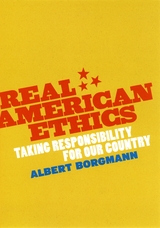 Real American Ethics: Taking Responsibility for Our Country
Albert Borgmann
University of Chicago Press, 2006 America is a wonderful and magnificent country that affords its citizens the broadest freedoms and the greatest prosperity in the world. But it also has its share of warts. It is embroiled in a war that many of its citizens consider unjust and even illegal. It continues to ravage the natural environment and ignore poverty both at home and abroad, and its culture is increasingly driven by materialism and consumerism. But America, for better or for worse, is still a nation that we have built. So why then, asks Albert Borgmann in this most timely and urgent work, are we failing to take responsibility for it?
In Real American Ethics, Borgmann asks us to reevaluate our role in the making of American values. Taking his cue from Winston Churchill—who once observed that we shape our buildings, and then our buildings shape us—Borgmann considers the power of our most enduring institutions and the condition of our present moral makeup to propose inspired new ways in which we, as ordinary citizens, can act to improve our country. This, he shows, includes everything from where we choose to live and what we spend our money on to daunting tasks like the reshaping of our cities—habits and actions that can guide us to more accomplished and virtuous lives. Using prose that is easy and direct throughout, Borgmann’s position is grounded neither by conservative nor liberal ideology, but in his understanding that he is a devoted citizen among many.
In an age in which the blame game is the only game in town, this patriotic book is an eloquent reminder of the political strength we all wield when we work together.
 Real Analysis Exchange 40, no. 1
Paul D. Humke
Michigan State University Press Journals, 2015 IN THIS ISSUE
CONFERENCE ANNOUNCEMENTS
EDITORIAL MESSAGES
TOPICAL SURVEYS
- Àkos K. Matszangosz, "The Denjoy-Young-Saks Theorem in Higher Dimensions: A Survey"
RESEARCH ARTICLES
- Emmanuel Chetcuti, Joseph Muscat, "Equilateral Weights on the Unit Ball of Rn"
- Tuomas Sahlsten, "Tangent Measures of Typical Measures"
- Ettore Minguzzi, "The Equality of Mixed Partial Derivatives Under Weak Differentiability Conditions"
- Andrei E. Ghenciu, Mario Roy, "Bowen's Formula for Shift-Generated Finite Conformal Constructions"
- Kathryn Hare, Ka-Shing Ng, "Hausdorff and Packing Measures of Balanced Cantor Sets"
- Tomasz Filipczak, Andrzej Rosłanowski, Saharon Shelah, "On Borel Hull Operations"
- Delong Li, Jie Miao, "Generalized Kiesswetter's Functions"
- Donatella Bongiorno, Giuseppa Corrao, "An Integral on a Complete Metric Measure Space"
INROADS
- John C. Georgiou, "Extreme Results on Certain Generalized Riemann Derivatives"
- Amin Farjudian, Behrouz Emamizadeh, "Absolute Continuity in Partial Differential Equations"
- Adel B. Badi, "Basic Introduction to Exponential and Logarithmic Functions"
ERRATA
- Antonio Boccuto, Xenofon Dimitriou, "Addendum to: Some New Types of Filter Limit Theorems for Topological Group-Valued Measures"
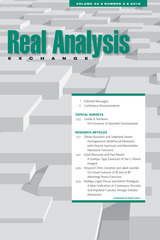 Real Analysis Exchange 40, no. 2
Paul D. Humke
Michigan State University Press Journals, 2015 IN THIS ISSUE
Conference Announcements
Editorial Messages
Topical Surveys
- Giselle A. Monteiro, "On Functions of Bounded Semivariation"
Research Articles
- Zoltán Buczolich, Stéphane Seuret, "Homogeneous Multifractal Measures with Disjoint Spectrum and Monohölder Monotone Functions"
- Eyad Massarwi, Paul Musial, "A Stieltjes Type Extension of the Lr-Perron Integral"
- Krzysztof Chris Ciesielski, Jakub Jasinski, "On Closed Subsets of R and of R2 Admitting Peano Functions"
- Rodrigo López Pouso, Adrián Rodríguez, "A New Uni
- cation of Continuous, Discrete, and Impulsive Calculus through Stieltjes Derivatives"
- Volodymyr Maslyuchenko, Vasyl' Nesterenko, "Analogues of Transitiveness and Decomposition of Continuity"
- Olena Karlova, "On Baire Classification of Strongly Separately Continuous Functions"
- Fabián E. Levis, Claudia N. Rodriguez, "Best Lp-Approximant Pair on Small Intervals"
- Fredrik Ekström, "The Fourier Dimension is Not Finitely Stable"
- Arlene Ash, J. Marshall Ash, Stefan Catoiu, "New Definitions of Continuity"
- Kathryn Hare, Franklin Mendivil, Leandro Zuberman, "Packing and Hausdorff Measures of Cantor Sets Associated with Series"
- Liwei Chen, "Special Maximal Operator and Ap+ Weights"
Inroads
- Eric J. Olson, James C. Robinson, "A Simple Example Concerning the Upper Box-Counting Dimension of a Cartesian Product"
- Kandasamy Muthuvel, "Weakly Symmetric Functions and Weakly Symmetrically Continuous Functions"
- Alexander Leonov, Cihan Orhan, "On Filter Convergence of Series"
 Real Analysis Exchange 41, no. 1
Paul D. Humke
Michigan State University Press Journals, 2016 VOLUME 41, ISSUE 1
Conference Announcements
Editorial Messages
Plenary Lectures
A. M. Olevskii, "Fourier Quasicrystals"
Marianna Csörnyei, "Tangents of Curves and Dierentiability of Functions"
Zoltán Buczolich, "Convergence of Ergodic Averages for Many Group Rotations"
Topical Surveys
Krzysztof Chris Ciesielski, David Miller, "A Continuous Tale on Continuous and Separately Continuous Functions"
Research Articles
Pongpol Ruankong, Songkiat Sumetkijakan, "Essential Closures"
Bruce H. Hanson, "Sets of Non-Differentiability for Functions with Finite Lower Scaled Oscillation"
Horst Alzer, "Inequalities for Mean Values in Two Variables"
Robert Menkyna, "On the Differences of Lower Semicontinuous Functions
S. N. Mukhopadhyay, S. Ray, "Relation Between Lp-Derivates and Peano, Approximate Peano and Borel Derivates of Higher Order"
Igor L. Bloshanskii, Denis A. Grafov, "Sufficient Conditions for Convergence Almost Everywhere of Multiple Trigonometric Fourier Series with Lacunary Sequence of Partial Sums"
Brian S. Thomson, "On VBG Functions and the Denjoy-Khintchine Integral"
Péter Komjáth, "A Certain 2-Coloring of the Reals"
Inroads
Alexander Kharazishvili, "Absolute Null Subsets of the Plane with Bad Orthogonal Projections"
René E. Castillo, Julio C. Ramos-Fernández, Margot Salas-Brown, "The Essential Norm of Multiplication Operators on Lorentz Sequence Spaces"
 Real Analysis Exchange 41, no. 2
Paul D. Humke
Michigan State University Press Journals, 2016 IN THIS ISSUE
Conference Announcements
Editorial Messages
Topical Surveys
John C. Morgan II, "Completion from an Abstract Perspective"
Research Articles
M. Archana, V. Kannan, "Intervals Containing All the Periodic Points"
Ryan M. Berndt, Greg G. Oman, "Turning Automatic Continuity Around: Automatic Homomorphisms"
Dariusz Kosz, "On the Discretization Technique for the Hardy-Littlewood Maximal Operators"
Volodymyr Mykhaylyuk, "On the Mixed Derivatives of a Separately Twice Differentiable Function"
Jimmy Tseng, "Nondense Orbits for Anosov Dieomorphisms of the 2-Torus"
Balazs Maga, "Accumulation Points of Graphs of Baire-1 and Baire-2 Functions"
Inroads
Kevin Beanland, Paul D. Humke, Trevor Richards, "On Scottish Book Problem 157"
Emma D'Aniello, T. H. Steele, "A Non Self-Similar Set"
Jan A. Grzesik, "Contour Integration Underlies Fundamental Bernoulli Number Recurrence"
Pier Domenico Lamberti, Giorgio Stefani, "Sobolev Subspaces of Nowhere Bounded Functions"
Oswaldo de Oliveira, "The Implicit Function Theorem When the Partial Jacobian Matrix Is Only Continuous at the Base Point"
Joseph L. Gerver, "A Nice Example of Lebesgue Integration"
Chris Freiling, Richard J. O'Malley, Paul D. Humke, "An Alternate Solution to Scottish Book 157"
Chris Freiling, Richard J. O'Malley, Paul D. Humke, "Approximately Continuous Functions Have Approximate Extrema, a New Proof"
 Real Analysis Exchange 42, no. 1
Paul D. Humke
Michigan State University Press Journals, 2017 IN THIS ISSUE
Editorial Messages
Conference Announcements
Plenary Lectures
Miroslav Zelený, Characterizations of σ-Porosity Using Infinite Games
Alica Miller, On Various Conditions that Imply Sensitivity of Monoid Actions
Hajrudin Fejzić, "Divided Differences and Peano Derivatives"
Luisa Di Piazza, "Integrals and Selections of Multifunctions with Values in an Arbitrary Banach Space"
Research Articles
Michael Dymond, Beata Randrianantoanina, Huaqiang Xu, "On Interval Based Generalizations of Absolute Continuity for Functions on Rn"
Changhao Chen, "A Class of Random Cantor Sets"
Silvestru S. Dragomir, "Variance Jensen Type Inequalities for General Lebesgue Integral with Applications"
Carl P. Dettmann, Mrinal Kanti Roychowdhury, "Quantization for Uniform Distributions on Equilateral Triangles"
Vassiliki Farmaki, Andreas Mitropoulos, "The l1-Dichotomy Theorem with Respect to a Coideal"
Inroads
J. Marshall Ash, Stefan Catoiu, "Directional Differentiability in the Euclidean Plane"
 Real Analysis Exchange 42, no. 2
Paul D. Humke
Michigan State University Press Journals, 2017 IN THIS ISSUE
Editorial Messages
Conference Announcements
Topical Surveys
Peter Fletcher, Karel Hrbacek, Vladimir Kanovei, Mikhail G. Katz, Claude Lobry, Sam Sanders, "Approaches to Analysis with Infinitesimals Following Robinson, Nelson, and Others"
Research Articles
Jonathan M. Fraser, Eric J. Olson, James C. Robinson, "Some Results in Support of the Kakeya Conjecture"
Michał Korch, "A Generalized Egorov's Statement for Ideals"
Redouane Sayyad, "The McShane Integral in the Limit"
Grigori A. Karagulyan, "On Exceptional Sets of the Hilbert Transform"
Franklin R. Astudillo-Villaba, René E. Castillo, Julio C. Ramos-Fernández, "Multiplication Operators on the Spaces of Functions of Bounded p-Variation in Wiener's Sense"
Ivan Werner, "On the Carathéodory Approach to the Construction of a Measure"
Vladimir Kanovei, Mikhail Katz, "A Positive Function with Vanishing Lebesgue Integral in Zermelo–Fraenkel Set Theory"
Badreddine Meftah, "On Some Gamidov Integral Inequalities on Time Scales and Applications"
Inroads
Iwo Labuda, "Measure, Category and Convergent Series"
Hajrudin Fejzić, "A Note on Monotonicity Theorems for Approximately Continuous Functions"
 Real Analysis Exchange 43, no. 1
Paul D. Humke
Michigan State University Press Journals, 2018 IN THIS ISSUE
EDITORIAL MESSAGES
CONFERENCE ANNOUNCEMENTS
TOPICAL SURVEY
- Tepper L. Gill, "Banach Spaces for the Schwartz Distributions"
PLENARY LECTURES
- Juan Bés, "Linear Subspaces of Hypercyclic Vectors"
- Bruce Hanson, "Some Results about Big and Little Lip"
- Toby C. O'Neil, "Measuring Anisotropy in Planar Sets"
RESEARCH ARTICLES
- Jörg Neunhäuserer, "Continued Logarithm Representation of Real Numbers"
- George Galvin, "An Elementary Proof of an Isoperimetric Inequality for Paths with Finite p-Variation"
- Taras Banakh, "Quasicontinuous Functions with Values in Piotrowski Spaces"
- Mrinal Kanti Roychowdhury, "Optimal Quantizers for Some Absolutely Continuous Probability Measures"
- Rachel L. Bayless, "Ergodic Properties of Rational Functions that Preserve Lebesgue Measure on R"
- Artur Nicolau, "Divided Differences, Square Functions, and a Law of the Iterated Logarithm"
- Lorenz Halbeisen, Marc Lischka, Salome Schumacher, "Magic Sets"
INROADS
- Z. Y. Zhu, E. M. Dong, "Random Cutouts of the Unit Cube with I.U.D Centers"
- Alan Chang, "On the Minkowski Sum of Two Curves"
- Alexander Kharazishvili, "A Note on the Uniqueness Property for Borel G-measures"
- Andrew M. Bruckner, Krzysztof Chris Ciesielski, "On the Composition of Derivatives"
- Hajrudin Fejzić, "A Note on the Luzin-Menchoff Theorem"
- José Mendoza, "Which Integrable Functions Fail to be Absolutely Integrable?"
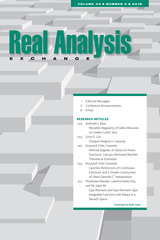 Real Analysis Exchange 43, no. 2
Paul D. Humke
Michigan State University Press Journals, 2018 In This Issue
Research Articles
Jeremiah J. Bass, "Mycielski-Regularity of Gibbs Measures on Cookie-Cutter Sets"
Sorin G. Gal, "Choquet Integral in Capacity"
Krzysztof Chris Ciesielski, "Minimal Degrees of Genocchi-Peano Functions: Calculus Motivated Number Theoretical Estimates"
Krzysztof Chris Ciesielski, "Lipschitz Restrictions of Continuous Functions and a Simple Construction of Ulam-Zahorski C1 Interpolation"
Pratikshan Mondal, Lakshmi Kanta Dey, and Sk. Jaker Ali, "Equi-Riemann and Equi-Riemann-Type Integrable Functions with Values in a Banach Space"
Olena Karlova and Tomáš Visnyai, "The Baire Classifi cation of Strongly Separately Continuous Functions on ℓ∞"
Jürgen Grahl and Shahar Nevo, "On the Growth of Real Functions and their Derivatives"
Changhao Chen, "Restricted Families of Projections and Random Subspaces"
Krzysztof C. Ciesielski and Juan B. Seoane-Sepúlveda, "Simultaneous Small Coverings by Smooth Functions Under the Covering Property Axiom"
Inroads
Anna K. Savvopoulou and Christopher M. Wedrychowcz, "A Note on Level Sets of Differentiable Functions f(x, y) with Non-Vanishing Gradient"
Benjamin Matson and Elizabeth Sattler, "S-Limited Shifts"
Leonard Huang, "Some Applications of Order-Embeddings of Countable Ordinals into the Real Line"
Oswaldo de Oliveira, "The Implicit Function Theorem for Maps that are Only Differentiable: An Elementary Proof"
Steven G. Krantz, "Uniqueness Properties of Harmonic Functions"
Harvey Rosen, "An Earlier Fractal Graph"
 Real Analysis Exchange 44, no. 1
Paul D. Humke
Michigan State University Press Journals, 2019 In This Issue
Editorial Messages
Conference Announcements
In Memoriam: Harry Miller
Topical Surveys
Tepper L. Gill, Timothy Myers, "Constructive Analysis on Banach Spaces"
Plenary Lectures
Francisco L. Hernández, Evgeny M. Semenov, "Strictly Singular Operators on Banach Lattices"
Vladimir I. Bogachev, "Distribution of Polynomials in Many Variables and Nikolskii–Besov Spaces"
Natalia Kholshchevnikova, "The Union Problem and the Category Problem of Sets of Uniqueness in the Theory of Orthogonal Series"
Research Articles
Riddhi Shah, Alok K. Yadav, "Dynamics of Certain Distal Actions on Spheres"
Horst Alzer, Alexander Kovačec, "The Inequality of Milne and its Converse, III"
Han Yu, "Erdős Semi-groups, Arithmetic Progressions, and Szemerédi's Theorem"
Alexei Yu. Karlovich, "Hardy-Littlewood Maximal Operator on the Associate Space of a Banach Function Space"
Álvaro Corvalán, "Some Characterizations of the Preimage of A∞ for the Hardy-Littlewood Maximal Operator and Consequences"
Panagiotis Georgopoulos, Constantinos Gryllakis, "On the Speed of Convergence in the Strong Density Theorem"
Redouane Sayyad, "The Weak Integral by Partitions of Unity"
Stuart A. Burrell, "On the Dimension and Measure of Inhomogeneous Attractors"
Inroads
Alexander Kharazishvili, "On the Steinhaus Property and Ergodicity via the Measure-Theoretic Density of Sets"
Sandra Lucente, "A Didactic Note on Classic Function Spaces and the Fourier Transform"
 Real Analysis Exchange 44, no. 2
Paul D. Humke
Michigan State University Press Journals, 2019 In This Issue
EDITORIAL MESSAGES
CONFERENCE ANNOUNCEMENTS
RESEARCH ARTICLES
Kathryn E. Hare and Kevin G. Hare, "Local Dimensions of Overlapping Self-Similar Measures"
Henry D. Riely, "A Modication of the Chang-Wilson-Wolff Inequality via the Bellman Function"
S. N. Mukhopadhyay and S. Ray, "Riemann Summability of Trigonometric Series and Riemann Derivatives of Real Functions"
Wahida Kaidouchi, Badreddine Meftah, Meryem Benssaad, and Sarra Ghomrani, "Fractional Hermite-Hadamard Type Integral Inequalities for Functions whose Modulus of the Mixed Derivatives are Co-Ordinated Extended (s1;m1)-(s2;m2)-Preinvex"
Antonio Boccuto, "Hahn-Banach-Type Theorems and Applications to Optimization for Partially Ordered Vector Space-Valued Invariant Operators"
INROADS
Jaroslav Lukeš and Petr Pošta, "Approximations by Differences of Lower Semicontinuous and Finely Continuous Functions"
Rodrigo López Pouso, "Fourier Method Revised to Solve Partial Differential Equations and Prove Uniqueness at One Stroke"
Savita Bhatnagar, "The Radon Nikodym Property and Multipliers of HK-Integrable Functions"
Steven G. Krantz, "Verifying Differentiability Without Calculating the Derivative
Ricky F. Rulete and Mhelmar A. Labendia, "A Descriptive Denition of the Backwards Itô-Henstock Integral"
Fábio M. S. Lima, "A Bridge Between the Unit Square and Single Integrals for Real Functions of the Form f(x • y)"
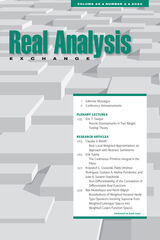 Real Analysis Exchange 45, no. 2
Paul D. Humke
Michigan State University Press Journals, 2020 In This Issue
EDITORIAL MESSAGES
CONFERENCE ANNOUNCEMENTS
PLENARY LECTURES
Eric T. Sawyer, "Recent Developments in Two Weight Testing Theory"
RESEARCH ARTICLES
Claudia V. Ridol, "Best Local Weighted Approximation, an Approach with Abstract Seminorms"
Erik Talvila, "The Continuous Primitive Integral in the Plane"
Krzysztof C. Ciesielski, Pablo Jiménez-Rodríguez, Gustavo A. Muñoz-Fernández, and Juan B. Seoane-Sepúlveda, "Non-Differentiability of the Convolution of Differentiable Real Functions"
Rza Mustafayev and Nevin Bilgiçli, "Boundedness of Weighted Iterated Hardy-Type Operators Involving Suprema from Weighted Lebesgue Spaces into Weighted Cesàro Function Spaces"
T. H. Steele, "The Dynamics of a Typical Measurable Function are Determined on a Zero Measure Set"
Soon-Mo Jung and Doyun Nam, "On the Density of the Thinnest Covering of Rn"
Dariusz Sokolowski, "Stability of n-th Order Flett's and Sahoo-Riedel's Points"
James Foran and Judit Kardos, "Characterizing the Coordinate Functions of Space Filling Curves"
Gerd Herzog and Peer Chr. Kunstmann, "Asymptotic Constants in Averaged Hölder Inequalities"
Absos Ali Shaikh and Biswa Ranjan Datta, "Generalized Almost Statistical Convergence"
Tamás Kátay, "The Intersection of Typical Besicovitch Sets with Lines"
Grzegorz Lewicki, Michael Prophet, and William Wood, "A Note on the Existence of Real Two-Dimensional Symmetric Subspaces of Lp[–1; 1]"
INROADS
Otgonbayar Uuye, "A Generalization of the Riemann-Lebesgue Theorem for Riemann Integrability"
ERRATA
Panagiotis Georgopoulos and Constantinos Gryllakis, "Corrigendum to: On the Speed of Convergence in the Strong Density Theorem"
 Real Analysis Exchange 46, no. 1
Paul D. Humke
Michigan State University Press Journals, 2021 In This Issue
EDITORIAL MESSAGES
RESEARCH ARTICLES
Max Goering, "Characterizations of Countably n-Rectifable Radon Measures by Higher-dimensional Menger Curvatures"
Igor E. Preobrazhenskii, "Suffcient Conditions for Convergence of Riemann Sums for Function Space Defined by the k-Modulus of Continuity"
Veerapazham Murugan and Rajendran Palanivel, "Non-Isolated, Non-Strictly Monotone Points of Iterates of Continuous Functions"
Paweł Barbarski, "Continuous Functions in Rings Generated by a Single Darboux Function"
Oswaldo Rio Branco de Oliveira, "The Exponential Matrix: An Explicit Formula by an Elementary Method"
Liangpan Li, "Open and Surjective Mapping Theorems for Differentiable Maps with Critical Points"
Tiago Canarias, Alexei Karlovich, and Eugene Shargorodsky, "Multiplication Is an Open Bilinear Mapping in the Banach Algebra of Functions of Bounded Wiener p-Variation"
Donát Nagy, "Substituting the Typical Compact Sets into a Power Series"
Jonathan M. Fraser and Han Yu, "Approximate Arithmetic Structure in Large Sets of Integers"
Domenico Candeloro, Anna Rita Sambucini, and Luca Trastulli, "A Girsanov Result for the Pettis Integral"
INROADS
Steen Pedersen and Joseph P. Sjoberg, "Sequential Derivatives"
Konrad J. Swanepoel, "Outer Linear Measure of Connected Sets via Steiner Trees"
Immanuel D. Calunod and I. J. L. Garces, "Strong Derivative and the Essentially Riemann Integral"
Narinder Singh and Surinder Pal Singh Kainth, "Variational Measure with Respect to Measurable Gauges"
Ladislav Mišík and János T. Tóth, "Ideal Extensions of Olivier's Theorem"
 Real Analysis Exchange 46, no. 2
Paul D. Humke
Michigan State University Press Journals, 2021 In This Issue
Editorial Messages
Conference Announcements
OBITUARIES
Richard J. Gardner
Washek Pfeffer, November 14, 1936 – January 3, 2021
Thierry De Pauw
Comments on Washek Pfeffer's Contributions to Integration Theory
Laurent Moonens
Washek Pfeffer's Books on Riemann-Type Integration
Gary Gruenhage
Some Remarks on Washek Pfeffer's Contributions in General Topology
Paul D. Humke
Togo Nishiura, November 10, 1931 – February 12, 2021
RESEARCH ARTICLES
Tomasz Filipczak and Grażyna Horbaczewska
Exceptional Points for Densities Generated by Sequences
Harrison Gaebler
Towards a Characterization of the Property of Lebesgue
Maxim J. Goldberg and Seonja Kim
An Explicit Characterization of the Domain of the Infinitesimal Generator of a Symmetric Diffusion Semigroup on LP of a Complete Positive Sigma-Finite Measure Space
Horst Alzer
Inequalities for Weighted Arithmetic and Geometric Means
Miroslav Repický
Spaces Not Distinguishing Ideal Convergences of Real-Valued Functions, I
Miroslav Repický
Spaces Not Distinguishing Ideal Convergences of Real-Valued Functions, II
Nicholas P. M. Kayban and Xianfu Wang
On Functions Determined by Dense Sets
David Hruška
A Note on Directional Lipschitz Continuity in the Euclidean Plane
Mrinal Kanti Roychowdhury
Optimal Quantization for Mixed Distributions
David de Hevia Rodríguez
On Real Universality in the Birkhoff Sense
INROADS
Marek Bienias and Szymon Głab
Lebesgue Density and Statistical Convergence
Rodolfo E. Maza and Sergio R. Canoy Jr.
On the SL-Integral of LCTVS-Valued Functions
Haipeng Chen and Jonathan M. Fraser
On Hölder Maps and Prime Gaps
 Real Analysis Exchange 47, no. 1
Paul D. Humke
Michigan State University Press Journals, 2022 In This Issue
Editorial Messages
Conference Announcements
Topical Survey
Riccardo Camerlo
Descriptive Set Theory, from Cantor to Wadge and Beyond
Research Articles
Marcus Pivato and Vassili Vergopoulos
Measure and Integration on Boolean Algebras of Regular Open Subsets in a Topological Space
Gertruda Ivanova and Irena Domnik
On Density and σ-Porosity in Some Families of Darboux Functions
Daniel Perry
Lipschitz Homotopy Groups of Contact 3-Manifolds
K. P. S. Bhaskara Rao
Comments on Charges on the Boolean Algebra of Regular Open Sets
Şahin Koçak and Murat Limoncu
Generalized Convexity and Passage from Local to Global via Differential Inequalities
P. Viswanathan
A Brief Exposition of the Space of Relatively Bounded Nonlinear Operators
E. S. Coulam and T. H. Steele
A Characterization of Attractors for Baire Functions on the Interval
Jung-Chao Ban, Chih-Hung Chang, Wen-Guei Hu, Guan-Yu Lai, and Yu-Liang Wu
Topologically Mixing Properties of Multiplicative Integer Systems
João Paulos
On Reflexivity and Point Spectrum
Hüseyin Albayrak, Öznur Ölmez, and Salih Aytar
Some Set Theoretic Operators Preserving Ideal Hausdorff Convergence
Tomas Persson
A Mass Transference Principle and Sets with Large Intersections
Juan Ferrera, Javier Gómez Gil, and Jesús Llorente
Second Order Differentiability and Related Topics in the Takagi Class
Inroads
Martin E. Price
Approximating the Decreasing Rearrangement
Errata
Stuart A. Burrell
Erratum: On the Dimension and Measure of Inhomogeneous Attractors
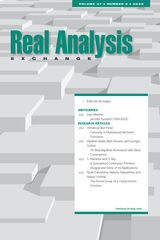 Real Analysis Exchange 47, no. 2
Paul D. Humke
Michigan State University Press Journals, 2022 In This Issue
Editorial Messages
Obituaries
Jean Mawhin
Jaroslav Kurzweil (1926-2022)
Research Articles
Immanuel Ben Porat
Convexity In Multivalued Harmonic Functions
Vladimír Baláž, Alain Faisant, and Georges Grekos
On Real Algebras Associated with Ideal Convergence
S. Mahanta and S. Ray
A Generalised Continuous Primitive Integral and Some of its Applications
Ryoki Fukushima, Makoto Nakashima, and Nobuo Yoshida
The Period Group of a Characteristic Function
Ion Chiţescu and Loredana Ioana
A Cantor-Type Construction. Invariant Set and Measure
T. H. Steele
The Density of Borel Sets
Surinder Pal Singh Kainth and Narinder Singh
Henstock-Kurzweil Integration on Metric Spaces Revisited
Idris Assani and Aidan J. Young
Non-Autonomous Spatial-Temporal Differentiation Theorems for Group Endomorphisms
Alina A. Shalukhina
On the Extension of the Reverse Hölder Inequality for Power Functions on the Real Axis
Inroads
Steven G. Krantz
Geometrically Significant Sets of Measure Zero
Clara Ying Yi Lim and Tin Lam Toh
A Note on Henstock-Itô’s Non-Stochastic Integral
Marta Kossaczká and Luděk Zajíček
On the Set of Points at which an Increasing Continuous Singular Function has a Nonzero Finite Derivative
Errata
Riddhi Shah and Alok K. Yadav
Errata: Dynamics of Certain Distal Actions on Spheres
 Real Analysis Exchange 48, no. 1
Paul D. Humke
Michigan State University Press Journals, 2023 IN THIS ISSUE
Editorial Messages
Conference Announcements
Obituaries
Michaela Mlíchová
Recollections about Jaroslav Smítal
Ľubomír Snoha
The Life and Mathematics of Jaroslav Smítal
Plenary Lectures
Zoltán Buczolich
Almost Everywhere Convergence Questions of Series of Translates of Non-Negative Functions
Research Articles
David Cruz-Uribe and Scott Rodney
A Note on the Limit of Orlicz Norms
Antoine Detaille and Augusto C. Ponce
A Decomposition for Borel Measures μ ≤ Hs
M. Bagnara, L. Gennaioli, G. M. Leccese, and E. Luongo
On the Hausdorff Measure of Rn with the Euclidean Topology
István Blahota
Approximation by Subsequences of Matrix Transform Mean of Walsh-Fourier Series
Ahmet Batal, Sadık Eyidoğan, and Haydar Göral
Irreducibility and Primality in Differentiability Classes
O. Karlovych and E. Shargorodsky
Remark on Singular Integral Operators of Convolution Type on Rearrangement-Invariant Banach Function Spaces
G. C. David, M. Kaczanowski, and D. Pinkerton
Quantitative Straightening of Distance Spheres
Inroads
Nathan Dalaklis, Kiko Kawamura, Tobey Mathis, and Michalis Paizanis
The Partial Derivative of Okamoto’s Functions with Respect to the Parameter
Suman Majumdar
Extension of the Continuity Theorems of Lebesgue Integration
Russel A. Gordon and Seán M. Stewart
Evaluating Improper Integrals using Laplace Transforms
 Real and Imagined: The Peak of Gold in Heian Japan
Heather Blair
Harvard University Press During the Heian period (794–1185), the sacred mountain Kinpusen, literally the “Peak of Gold,” came to cultural prominence as a pilgrimage destination for the most powerful men in Japan—the Fujiwara regents and the retired emperors. Real and Imagined depicts their one-hundred-kilometer trek from the capital to the rocky summit as well as the imaginative landscape they navigated. Kinpusen was believed to be a realm of immortals, the domain of an unconventional bodhisattva, and the home of an indigenous pantheon of kami. These nominally private journeys to Kinpusen had political implications for both the pilgrims and the mountain. While members of the aristocracy and royalty used pilgrimage to legitimate themselves and compete with one another, their patronage fed rivalry among religious institutions. Thus, after flourishing under the Fujiwara regents, Kinpusen’s cult and community were rent by violent altercations with the great Nara temple Kōfukuji. The resulting institutional reconfigurations laid the groundwork for Shugendō, a new movement focused on religious mountain practice that emerged around 1300. Using archival sources, archaeological materials, noblemen’s journals, sutras, official histories, and vernacular narratives, this original study sheds new light on Kinpusen, positioning it within the broader religious and political history of the Heian period.
 Real and Imagined Worlds: The Novel and Social Science
Morroe Berger
Harvard University Press, 1977 To show how the imagined world of the storyteller informs us about the real world of experience, a distinguished social scientist brings the perspective of his discipline to bear on two and a half centuries of fiction. Under his scrutiny, the novel reveals a wealth of insight into sociological, historical, and political phenomena. Morroe Berger illustrates his points with an extraordinary range of novels in Europe and America, from Defoe to Forster and Golding.
The interaction between the novel and social science started in the eighteenth century, when these two ways of examining human behavior and social life achieved their modern form. Writers of fiction broadened their outlook to take in social class and touched upon other issues that are still very much alive, such as individualism, marriage, and the status of women. The novelist, Berger makes clear, is no intruder among historians and social scientists, but rather has been focusing on the same landscape through a different lens. Berger demonstrates that the novel has enriched our understanding of political power, class, law, cultural conflict, and interpersonal relations. He compares Fielding's fiction with Mandeville's essays in the eighteenth century, and Silone's novels of power and bureaucracy with social scientists' treatments of these themes in the twentieth. He points out how such novels as Robinson Crusoe and Lord of the Flies amplify the theory of the social contract. And he examines the clash of cultures as portrayed in the novel of colonial life. Having affirmed the novel's contribution to social science, Berger explodes its claims to offering a higher scientific truth—Balzac's zoology and Zola's experimental novel are cases in point—and reviews the long-standing dispute between science and literature exemplified in the writings of C. P. Snow.
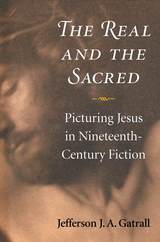 The Real and the Sacred: Picturing Jesus in Nineteenth-Century Fiction
Jefferson J. A. Gatrall
University of Michigan Press, 2014 The figure of Jesus appears as a character in dozens of nineteenth-century novels, including works by Balzac, Flaubert, Dickens, Dostoevsky, and others. The Real and the Sacred focuses in particular on two fiction genres: the Jesus redivivus tale and the Jesus novel. In the former, Christ makes surprise visits to earth, from rural Flanders (Balzac) and Muscovy (Turgenev) to the bustling streets of Paris (Flaubert), Seville (Dostoevsky), Berlin, and Boston. In the latter, the historical Jesus wanders through the picturesque towns and plains of first-century Galilee and Judea, attracting followers and enemies. In short, authors subjected Christ, the second person of the Christian trinity, to the realist norms of secular fiction. Thus the Jesus of nineteenth-century fiction was both situated within a specific time and place, whether ancient or modern, and positioned before the gaze of increasingly daring literary portraitists. The highest artistic challenge for authors was to paint, using mere words, a faithful picture of Jesus in all his humanity. The incongruity of a sacred figure inhabiting secular literary forms nevertheless tested the limits of modern realist style no less than the doctrine of Christ’s divinity. The international “quest of the historical Jesus” has been amply documented within the context of nineteenth-century biblical scholarship. Yet there has been no broad-based comparative study devoted to the depiction of Jesus in prose fiction over the same time period. The Real and the Sacred offers a comprehensive survey of this body of fiction, examining both the range of its Christ types and the varying formal means through which these types were represented. The nineteenth century—despite forecasts of God's death at the time—not only revived older Christ types but also witnessed the rise of new ones, including le Christ proletaire, the Mormon Christ, the Buddhist Christ, and the Tolstoyan Christ. Novelists played a crucial role in the invention and popularization of the historical Jesus in particular, one of modernity's major figures. These pioneering works of fiction, written by authors of diverse religious and national backgrounds, laid the formal groundwork for an enduring fascination with the historical Jesus in later fiction and film, from Mikhail Bulgakov's Master and Margarita to Mel Gibson's The Passion of the Christ. The book is enhanced by a gallery of illustrations of the historical Jesus as depicted by nineteenth-century artists.
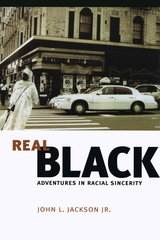 Real Black: Adventures in Racial Sincerity
John L. Jackson Jr.
University of Chicago Press, 2005 New York's urban neighborhoods are full of young would-be emcees who aspire to "keep it real" and restaurants like Sylvia's famous soul food eatery that offer a taste of "authentic" black culture. In these and other venues, authenticity is considered the best way to distinguish the real from the phony, the genuine from the fake. But in Real Black, John L. Jackson Jr. proposes a new model for thinking about these issues—racial sincerity.
Jackson argues that authenticity caricatures identity as something imposed on people, imprisoning them within stereotypes: an African American high school student who excels in the classroom, for instance, might be dismissed as "acting white." On the other hand, sincerity, as Jackson defines it, imagines authenticity as an incomplete measuring stick, an analytical model that attempts to deny people agency in their search for identity.
Drawing on more than ten years of ethnographic research in and around New York City, Jackson offers a kaleidoscope of subjects and stories that directly and indirectly address how race is negotiated in today's world—including tales of book-vending numerologists, urban conspiracy theorists, corrupt police officers, mixed-race neo-Nazis, and gospel choirs forbidden to catch the Holy Ghost. Jackson records and retells their interconnected sagas, all the while attempting to reconcile these stories with his own crisis of identity and authority as an anthropologist terrified by fieldwork. Finding ethnographic significance where mere mortals see only bricks and mortar, his invented alter ego Anthroman takes to the streets, showing how race is defined and debated, imposed and confounded every single day.
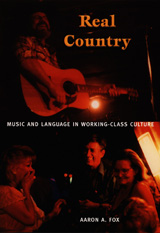 Real Country: Music and Language in Working-Class Culture
Aaron A. Fox
Duke University Press, 2004 In Lockhart, Texas, a rural working-class town just south of Austin, country music is a way of life. Conversation slips easily into song, and the songs are full of conversation. Anthropologist and musician Aaron A. Fox spent years in Lockhart making research notes, music, and friends. In Real Country, he provides an intimate, in-depth ethnography of the community and its music. Showing that country music is deeply embedded in the textures of working-class life, Fox argues that it is the cultural and intellectual property of working-class people and not only of the Nashville-based music industry or the stars whose lives figure so prominently in popular and scholarly writing about the genre. Fox spent hundreds of hours observing, recording, and participating in talk and music-making in homes, beer joints, and garage jam sessions. He renders the everyday life of Lockhart’s working-class community in detail, right down to the ice cold beer, the battered guitars, and the technical skills of such local musical legends as Randy Meyer and Larry “Hoppy” Hopkins. Throughout, Fox focuses on the human voice. His analyses of conversations, interviews, songs, and vocal techniques show how feeling and experience are expressed, and how local understandings of place, memory, musical aesthetics, working-class social history, race, and gender are shared. In Real Country, working-class Texans re-imagine their past and give voice to the struggles and satisfactions of their lives in the present through music.
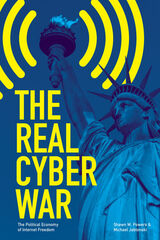 The Real Cyber War: The Political Economy of Internet Freedom
Shawn M. Powers and Michael Jablonski
University of Illinois Press, 2015 Contemporary discussion surrounding the role of the internet in society is dominated by words like: internet freedom, surveillance, cybersecurity, Edward Snowden and, most prolifically, cyber war. Behind the rhetoric of cyber war is an on-going state-centered battle for control of information resources. Shawn Powers and Michael Jablonski conceptualize this real cyber war as the utilization of digital networks for geopolitical purposes, including covert attacks against another state's electronic systems, but also, and more importantly, the variety of ways the internet is used to further a state’s economic and military agendas.
Moving beyond debates on the democratic value of new and emerging information technologies, The Real Cyber War focuses on political, economic, and geopolitical factors driving internet freedom policies, in particular the U.S. State Department's emerging doctrine in support of a universal freedom to connect. They argue that efforts to create a universal internet built upon Western legal, political, and social preferences is driven by economic and geopolitical motivations rather than the humanitarian and democratic ideals that typically accompany related policy discourse. In fact, the freedom-to-connect movement is intertwined with broader efforts to structure global society in ways that favor American and Western cultures, economies, and governments.
Thought-provoking and far-seeing, The Real Cyber War reveals how internet policies and governance have emerged as critical sites of geopolitical contestation, with results certain to shape statecraft, diplomacy, and conflict in the twenty-first century.
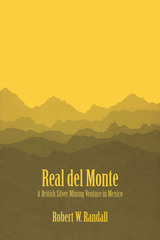 Real del Monte: A British Silver Mining Venture in Mexico
By Robert W. Randall
University of Texas Press, 1972 To speak of mining in newly independent Mexico is to speak of silver. And silver, historically abundant in the Real del Monte–Pachuca district, was the object of the Company of Adventurers in the Mines of Real del Monte. Organized in response to a plea by Pedro Romero de Terreros for help in rehabilitating his famous family’s once-rich properties, the English Real del Monte was led by men convinced that the application of English capital, management practices, and technology to those ruined mines and mills would reap them a profit and would revitalize the new nation’s most promising industry. The adventurers were to be disappointed. The story of the English company is one of financial disaster: the loss of more than $5 million between its beginning in 1824 and its dissolution in 1849. Yet this failure was ironic, for upon the foundations of the English company was built a modern concern that yielded great rewards to Mexican and American successors to the hapless Englishmen. A full account of a single risky venture, this inquiry is a microcosm of early foreign economic penetration into the Mexican mining industry. It offers specific solutions to poorly understood historical problems concerning the wave of capital that flowed from Great Britain into Latin America upon the disruption of the Spanish Empire, problems hitherto treated only in generalizations.
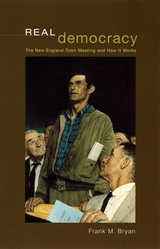 Real Democracy: The New England Town Meeting and How It Works
Frank M. Bryan
University of Chicago Press, 2003 Relying on an astounding collection of more than three decades of firsthand research, Frank M. Bryan examines one of the purest forms of American democracy, the New England town meeting. At these meetings, usually held once a year, all eligible citizens of the town may become legislators; they meet in face-to-face assemblies, debate the issues on the agenda, and vote on them. And although these meetings are natural laboratories for democracy, very few scholars have systematically investigated them.
A nationally recognized expert on this topic, Bryan has now done just that. Studying 1,500 town meetings in his home state of Vermont, he and his students recorded a staggering amount of data about them—238,603 acts of participation by 63,140 citizens in 210 different towns. Drawing on this evidence as well as on evocative "witness" accounts—from casual observers to no lesser a light than Aleksandr Solzhenitsyn—Bryan paints a vivid picture of how real democracy works. Among the many fascinating questions he explores: why attendance varies sharply with town size, how citizens resolve conflicts in open forums, and how men and women behave differently in town meetings. In the end, Bryan interprets this brand of local government to find evidence for its considerable staying power as the most authentic and meaningful form of direct democracy.
Giving us a rare glimpse into how democracy works in the real world, Bryan presents here an unorthodox and definitive book on this most cherished of American institutions.
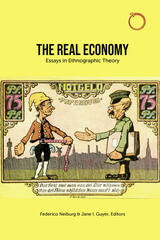 The Real Economy: Essays in Ethnographic Theory
Edited by Federico Neiburg and Jane I. Guyer
HAU, 2020 This collection highlights a key metaphor in contemporary discourse about economy and society. The contributors explore how references to reality and the real economy are linked both to the utopias of collective well-being, supported by real monies and good economies, and the dystopias of financial bubbles and busts, in which people’s own lives “crash” along with the reality of their economies.
An ambitious anthropology of economy, this volume questions how assemblages of vernacular and scientific realizations and enactments of the economy are linked to ideas of truth and moral value; how these multiple and shifting realities become present and entangle with historically and socially situated lives; and how the formal realizations of the concept of the “real” in the governance of economies engage with the experiential lives of ordinary people. Featuring essays from some of the world’s most prominent economic anthropologists, The Real Economy is a milestone collection in economic anthropology that crosses disciplinary boundaries and adds new life to social studies of the economy.
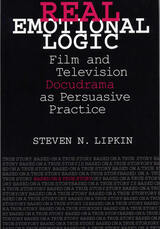 Real Emotional Logic: Film and Television Docudrama as Persuasive Practice
Steven N. Lipkin
Southern Illinois University Press, 2002 Analyzing docudrama as a mode of argument, Steven N. Lipkin explores the ethical, historical, and ideological functions of docudrama to discover why these films based on true stories offer such appealing story lines. That appeal, Lipkin discovers, is rooted in docudrama’s representation of actual people and events by means of melodramatic narrative structures that play on the emotions of the viewer. The dual nature of docudramas—blending narrative and documentary style— argues for a moral view of reality-based subject matter. The ethics, the ideology, the very presence of docudrama on television and the range of topics and problems that appear in contemporary feature film docudramas indicate how this form of presentation appeals to its audience. Docudrama offers a warranted, rational view of what the story material might suggest initially to be an irrational world. Through its moral agenda, docudrama ultimately allows the possibilities of understanding, optimism, and hope to emerge from “real stories.” Real Emotional Logic traces the development of docudramas into contemporary movies of the week and feature films, including Schindler’s List, Amistad, JFK, The Killing Fields, Quiz Show, A League of Their Own, In the Name of the Father, Call Northside 777, 13 Rue Madeleine, Cheerleader Mom, Shine, Rosewood, A Civil Action, and October Sky. Lipkin provides further insight into the genre by identifying and describing the commonalities connecting ostensibly different docudramas through their shared themes and narrative techniques. In doing so, he exposes the persuasive rhetorical strategies at the heart of docudramas and reveals the constructed emotional appeal inherent in films “based on a true story.”
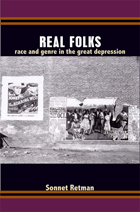 Real Folks: Race and Genre in the Great Depression
Sonnet H. Retman
Duke University Press, 2011 During the Great Depression, people from across the political spectrum sought to ground American identity in the rural know-how of “the folk.” At the same time, certain writers, filmmakers, and intellectuals combined documentary and satire into a hybrid genre that revealed the folk as an anxious product of corporate capitalism, rather than an antidote to commercial culture. In Real Folks, Sonnet Retman analyzes the invention of the folk as figures of authenticity in the political culture of the 1930s, as well as the critiques that emerged in response. Diverse artists and intellectuals—including the novelists George Schuyler and Nathanael West, the filmmaker Preston Sturges, and the anthropologist Zora Neale Hurston—illuminated the fabrication and exploitation of folk authenticity in New Deal and commercial narratives. They skewered the racist populisms that prevented interracial working-class solidarity, prophesized the patriotic function of the folk for the nation-state in crisis, and made their readers and viewers feel self-conscious about the desire for authenticity. By illuminating the subversive satirical energy of the 1930s, Retman identifies a rich cultural tradition overshadowed until now by the scholarly focus on Depression-era social realism.
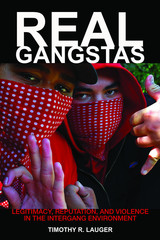 Real Gangstas: Legitimacy, Reputation, and Violence in the Intergang Environment
Lauger, Timothy R
Rutgers University Press, 2012 Street gangs are a major concern for residents in many inner-city communities. However, gangs’ secretive and, at times, delinquent tendencies limit most people’s exposure to the realities of gang life. Based on eighteen months of qualitative research on the streets of Indianapolis, Real Gangstas provides a unique and intimate look at the lives of street gang members as they negotiate a dangerous peer environment in a major midwestern city. Timothy R. Lauger interviewed and observed a mix of fifty-five gang members, former gang members, and non-gang street offenders. He spent much of his fieldwork time in the company of a particular gang, the “Down for Whatever Boyz,” who allowed him to watch and record many of their day-to-day activities and conversations. Through this extensive research, Lauger is able to understand and explain the reasons for gang membership, including a chaotic family life, poverty, and the need for violent self-assertion in order to foster the creation of a personal identity. Although the book exposes many troubling aspects of gang life, it is not a simple descriptive or a sensationalistic account of urban despair and violence. Steeped in the tradition of analytical ethnography, the study develops a central theoretical argument: combinations of street gangs within cities shape individual gang member behavior within those urban settings. Within Indianapolis, members of rival gangs interact on a routine basis within an ambiguous and unstable environment. Participants believe that many of their contemporaries claiming gang affiliations are not actually “real” gang members, but instead are imposters who gain access to the advantages of gang membership through fraud and pretense. Consequently, the ability to discern “real” gang members—or to present oneself successfully as a real gang member—is a critical part of gangland Indianapolis.
Real Gangstas offers an objective and fair characterization of active gang members, successfully balancing the seemingly conflicting idea that they generally seem like normal teenagers, yet are abnormally concerned with—and too often involved in—violence. Lauger takes readers to the edge of an actual gang conflict, providing a rare and up-close look at the troubling processes that facilitate hostility and violence.
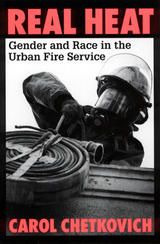 Real Heat: Gender and Race in the Urban Fire Service
Chetkovich, Carol
Rutgers University Press, 1997 In the struggle over affirmative action, no employment setting has seen more friction than urban fire departments. Thirty years of legal and political efforts have opened the doors of this historically white male preserve, but men of color have yet to consolidate their gains, and women's progress has been even more tenuous. In this unique and compelling account of affirmative action at the "street level," Carol Chetkovich explores the ways in which this program has succeeded and failed. Chetkovich follows the men and women of the Oakland Fire Department Class 1-91 through their academy training and eighteen-month probation. In vivid and sometimes surprising narratives, newcomers tell of their first battle with a full-fledged fire, their reactions to hazing rituals, and their relationships with veterans and fellow trainees. Real Heat explores how the process of becoming a firefighter interacts with the dimensions of race and gender to support some and discourage others. The book examines the implications of these interactions for public policy and social justice.
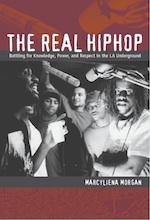 The Real Hiphop: Battling for Knowledge, Power, and Respect in the LA Underground
Marcyliena Morgan
Duke University Press, 2009 Project Blowed is a legendary hiphop workshop based in Los Angeles. It began in 1994 when a group of youths moved their already renowned open-mic nights from the Good Life, a Crenshaw district health food store, to the KAOS Network, an arts center in Leimert Park. The local freestyle of articulate, rapid-fire, extemporaneous delivery, the juxtaposition of meaningful words and sounds, and the way that MCs followed one another without missing a beat, quickly became known throughout the LA underground. Leimert Park has long been a center of African American culture and arts in Los Angeles, and Project Blowed inspired youth throughout the city to consider the neighborhood the epicenter of their own cultural movement. The Real Hiphop is an in-depth account of the language and culture of Project Blowed, based on the seven years Marcyliena Morgan spent observing the workshop and the KAOS Network. Morgan is a leading scholar of hiphop, and throughout the volume her ethnographic analysis of the LA underground opens up into a broader examination of the artistic and cultural value of hiphop. Morgan intersperses her observations with excerpts from interviews and transcripts of freestyle lyrics. Providing a thorough linguistic interpretation of the music, she teases out the cultural antecedents and ideologies embedded in the language, emphases, and wordplay. She discusses the artistic skills and cultural knowledge MCs must acquire to rock the mic, the socialization of hiphop culture’s core and long-term members, and the persistent focus on skills, competition, and evaluation. She brings attention to adults who provided material and moral support to sustain underground hiphop, identifies the ways that women choose to participate in Project Blowed, and vividly renders the dynamics of the workshop’s famous lyrical battles.
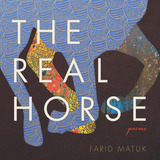 The Real Horse: Poems
Farid Matuk
University of Arizona Press, 2018 A sustained address to the poet’s daughter, The Real Horse takes its cues from the child’s unapologetic disregard for things as they are, calling forth the adult world as accountable for its flaws and as an occasion for imagining otherwise.
Offering a handbook on the possibilities of the verse line, this collection is precise in its figuring, searching in its intellect, and alert in its music. Here lyric energy levitates into constellations that hold their analytic composure, inviting readers into a shared practice of thinking and feeling that interrogates the confounding intersections of gender, race, class, and national status not as abstract concepts but as foundational intimacies.
Matuk’s interrogations of form cut a path through the tangle of a daughter’s position as a natural-born female citizen of the “First World” and of the poet’s position as a once-undocumented immigrant of mixed ethnicity whose paternity is unavoidably implicated in patriarchy. Rejecting nostalgia for homelands, notions of embodied value (self-made or otherwise), and specious ideas of freedom, these luminously multifaceted poem sequences cast their lot with the lyric voice, trusting it to hold a space where we might follow the child’s ongoing revolution against the patrimony of selfhood and citizenship.
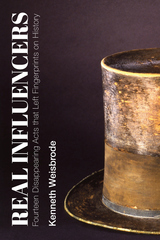 Real Influencers: Fourteen Disappearing Acts that Left Fingerprints on History
Kenneth Weisbrode
St. Augustine's Press, 2022 What is influence and why might real influencers be those whose names we no longer remember? Ken Weisbrode embarks on an exploration to trace the most powerful strands of cultural and intellectual influence, and demonstrates it might not be what we think it is.
"The influencer is a person who made an art of absence in the trade of cultural and sometimes political capital. The ones in this book represent a range of vocations, from politics to diplomacy to novel-writing, but almost all were cultural entrepreneurs. They were not puppet masters, gray eminences, unsung heroes, or Svengalis––although one or two have been portrayed thus. Rather, their influence is spread by virtue of their willful disappearance, of its perpetuation of a new language and cultural standard, and of their many conscious and unconscious imitators. The reason they had such influence was precisely because a part of their method was to be less visible in order to watch their ideas, habits, and styles proliferate without their names necessarily being affixed. […] Yet, to understand such a modus operandi is necessary today when the proliferation of social media influencers are squandering cultural capital so quickly by the simultaneous promotion of their products, above all, themselves."
 Real Kids: Creating Meaning in Everyday Life
Susan L. Engel
Harvard University Press, 2005 Decades of work in psychology labs have vastly enhanced our knowledge about how children perceive, think, and reason. But it has also encouraged a distorted view of children, argues psychologist Susan Engel in this provocative and passionate book--a view that has affected every parent who has tried to debate with a six-year-old. By focusing on the thinking processes prized by adults, too many expert opinions have rendered children as little adults. What has been lost is what is truly unique and mysterious--the childlike quality of a child's mind.
Engel draws on keen observations and descriptive research to take us into the nearly forgotten, untidy, phantasmagorical world of children's inner lives. She reminds us that children fuse thought and emotion, play and reality; they swing wildly between different ways of interpreting and acting in the world. But just as a gawky child may grow into a beauty, illogical and sometimes maddening childishness can foreshadow great adult ability.
Engel argues that the "scientist in a crib" view encourages parents and teachers to expect more logical reasoning and emotional self-control from children than they possess. She provides a concise and valuable overview of what modern developmental psychologists have learned about children's developing powers of perception and capacity for reasoning, but also suggests new ways of studying children that better capture the truth about their young minds.
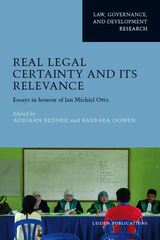 Real Legal Certainty and its Relevance: Essays in honor of Jan Michiel Otto
Edited by Adriaan Bedner and Barbara Oomen
Leiden University Press, 2018 The concept of ‘real legal certainty’ provides a much needed corrective to the general attention for legal certainty in this day and age. It emphasises relations between citizens, adds socio-legal insight, provides a ‘view from below,’ and thus leads to more realistic insights on how to build state institutions. The concept was introduced by Leiden University’s professor of Law and Governance in Developing countries Jan Michiel Otto, and can be considered a central pillar of his work. Against the backdrop of an ever-increasing interest in ‘legal certainty’ in policy-making and academia, friends and colleagues of Jan Michiel Otto engage with the concept provide a wide variety of examples of its relevance. Drawing on case material from all over the world, they show how real legal certainty can be understood in a bottom-up manner and how it is relevant for building state institutions. They also show how the concept can gain in relevance by taking into account actors other than the state. In all, the edited volume is important reading for all whom share professor Otto’s interest in what it takes to bridge law in the books and law in action.
Real Life: An Installation
Julie Carr
Omnidawn, 2018 In a book rich with formal variety and lyric intensity, Carr takes up economic inequality, gendered violence, losses both personal and national, and the crisis of the body within all of these forces. Real Life: An Installation is a terrifying book, but one that keeps us close as it moves through the disruptions and eruptions of the real.
Real Life Cryptology: Ciphers and Secrets in Early Modern Hungary
Benedek Láng
Amsterdam University Press, 2018 A large number of enciphered documents survived from early modern Hungary. This area was a particularly fertile territory where cryptographic methods proliferated, because a large portion of the population was living in the frontier zone, and participated (or was forced to participate) in the network of the information flow. A quantitative analysis of sixteenth-century to seventeenth-century Hungarian ciphers (300 cipher keys and 1,600 partly or entirely enciphered letters) reveals that besides the dominance of diplomatic use of cryptography, there were many examples of ŸprivateŒ applications too. This book reconstructs the main reasons and goals why historical actors chose to use ciphers in a diplomatic letter, a military order, a diary or a private letter, what they decided to encrypt, and how they perceived the dangers threatening their messages.
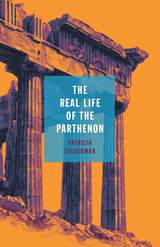 The Real Life of the Parthenon
Patricia Vigderman
Ohio State University Press, 2018
Ownership battles over the marbles removed from the Parthenon by Lord Elgin have been rumbling into invective, pleading, and counterclaims for two centuries. The emotional temperature around them is high, and steering across the vast past to safe anchor in a brilliant heritage is tricky. The stories around antiquities become distorted by the pull of ownership, and it is these stories that urge Patricia Vigderman into her own exploration of their inspiring legacy in her compelling extended essay, The Real Life of the Parthenon.
Vigderman’s own journey began at the Parthenon, but curiosity edged her further onto the sea between antiquity and the present. She set out to seek the broken temples and amphorae, the mysterious smiles of archaic sculpture, and the finely hammered gold of a funeral wreath among the jumbled streets of modern Athens, the fertile fields of Sicily, the mozzarella buffalo of Paestum. Guided along the way toward the enduring landscapes and fractured history by archeologists, classicists, historians, and artists—and by the desire they inspire—she was caught by ongoing, contemporary local life among the ruins. Gathering present meaning and resonance for the once and future remains of vanished glory, The Real Life of the Parthenon illuminates an important but shadowy element of our common cultural life: the living dynamic between loss and delight.
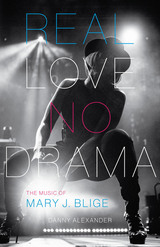 Real Love, No Drama: The Music of Mary J. Blige
By Danny Alexander
University of Texas Press, 2016 Mary J. Blige is an icon who represents the political consciousness of hip hop and the historical promise of soul. She is an everywoman, celebrated by Oprah Winfrey and beloved by pop music fans of all ages and races. Blige has sold over fifty million albums, won numerous Grammys, and even played at multiple White House events, as well as the 2013 Nobel Peace Prize ceremony. Displaying astonishing range and versatility, she has recorded everything from Broadway standards to Led Zeppelin anthems and worked with some of popular music’s greatest artists—Aretha Franklin, Eric Clapton, Elton John, Whitney Houston, Sting, U2, and Beyoncé, among them. Real Love, No Drama: The Music of Mary J. Blige tells the story of one of the most important artists in pop music history. Danny Alexander follows the whole arc of Blige’s career, from her first album, which heralded the birth of “hip hop soul,” to her critically praised 2014 album, The London Sessions. He highlights the fact that Blige was part of the historically unprecedented movement of black women onto pop radio and explores how she and other women took control of their careers and used their music to give voice to women’s (and men’s) everyday struggles and dreams. This book adds immensely to the story of both black women artists and artists rooted in hip hop and pays tribute to a musician who, by expanding her reach and asking tough questions about how music can and should evolve, has proven herself an artistic visionary.
Real Magic
Edited by Susanne Witzgall
Diaphanes, 2018 In Western societies a newly discovered and very lively interest in magical practices and occult knowledge can be witnessed. The magical seems to be evolving into a popular phenomenon that affects society as a whole and is also becoming the subject of intense debate in artistic and academic-scientific contexts. The book Real Magic investigates the current realities of the magical in the contemporary arts, sciences and everyday culture. It explores the present Western residues and forms of magical practices, the current potentials of magical perception and thinking in a world largely determined by financialised instrumental reason, and also the drawbacks of occultism. The publication is the result of the fourth annual programme of the cx centre of interdisciplinary studies at the Academy of Fine Arts Munich.
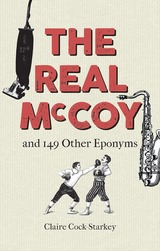 The Real McCoy: And 149 Other Eponyms
Claire Cock-Starkey
Bodleian Library Publishing, 2018 From diesel to gerrymandering, the English language is rich with eponyms—words that are named after an individual. The many histories behind these words are often mesmerizing—a word named, incidentally, after the German physician Franz Mesmer, who developed the practice of hypnotism as a form of therapy.
Deriving from numerous sources, eponyms are full of intrigue. This book features one hundred and fifty of the most interesting and enlightening specimens, delving into the origins of the words and describing the fascinating people after whom they were named. Some honor a style icon, inventor, or explorer, such as pompadour, Kalashnikov, and Cadillac. Others have roots in Greek or Roman mythology, such as panic and tantalize. Still others are far from celebratory and were created to brand the negative association of their origins—into this category can be filed boycott, Molotov cocktail, and sadist.
Encompassing words from medicine, botany, invention, science, fashion, food, and literature, this book uncovers the curious tales of discovery, mythology, innovation, and infamy behind the eponyms we use every day. The Real McCoy is the perfect addition to any wordsmith’s bookshelf.
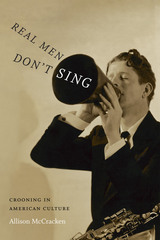 Real Men Don't Sing: Crooning in American Culture
Allison McCracken
Duke University Press, 2015 The crooner Rudy Vallée's soft, intimate, and sensual vocal delivery simultaneously captivated millions of adoring fans and drew harsh criticism from those threatened by his sensitive masculinity. Although Vallée and other crooners reflected the gender fluidity of late-1920s popular culture, their challenge to the Depression era's more conservative masculine norms led cultural authorities to stigmatize them as gender and sexual deviants. In Real Men Don't Sing Allison McCracken outlines crooning's history from its origins in minstrelsy through its development as the microphone sound most associated with white recording artists, band singers, and radio stars. She charts early crooners’ rise and fall between 1925 and 1934, contrasting Rudy Vallée with Bing Crosby to demonstrate how attempts to contain crooners created and dictated standards of white masculinity for male singers. Unlike Vallée, Crosby survived the crooner backlash by adapting his voice and persona to adhere to white middle-class masculine norms. The effects of these norms are felt to this day, as critics continue to question the masculinity of youthful, romantic white male singers. Crooners, McCracken shows, not only were the first pop stars: their short-lived yet massive popularity fundamentally changed American culture.
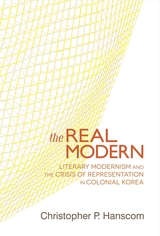 The Real Modern: Literary Modernism and the Crisis of Representation in Colonial Korea
Christopher P. Hanscom
Harvard University Press, 2013 The contentious relationship between modernism and realism has powerfully influenced literary history throughout the twentieth century and into the present. In 1930s Korea, at a formative moment in these debates, a “crisis of representation” stemming from the loss of faith in language as a vehicle of meaningful reference to the world became a central concern of literary modernists as they operated under Japanese colonial rule.
Christopher P. Hanscom examines the critical and literary production of three prose authors central to 1930s literary circles—Pak T’aewon, Kim Yujong, and Yi T’aejun—whose works confront this crisis by critiquing the concept of transparent or “empiricist” language that formed the basis for both a nationalist literary movement and the legitimizing discourse of assimilatory colonization. Bridging literary and colonial studies, this re-reading of modernist fiction within the imperial context illuminates links between literary practice and colonial discourse and questions anew the relationship between aesthetics and politics.
The Real Modern challenges Eurocentric and nativist perspectives on the derivative particularity of non-Western literatures, opens global modernist studies to the similarities and differences of the colonial Korean case, and argues for decolonization of the ways in which non-Western literatures are read in both local and global contexts.
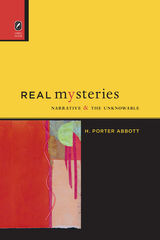 Real Mysteries: Narrative and the Unknowable
H. Porter Abbott
Ohio State University Press, 2013 The influential and widely respected narrative theorist, H. Porter Abbott, breaks new ground in Real Mysteries:Narrative and the Unknowable. In it, he revisits the ancient theme of what we cannot know about ourselves and others. But in a sharp departure, he shifts the focus from the representation of this theme to the ways narrative can be manipulated to immerse “the willing reader” in the actual experience of unknowing. As he shows, this difficult and risky art, which was practiced so inventively by Samuel Beckett, was also practiced by other modern writers. Abbott demonstrates their surprising diversity in texts by Beckett, Gabriel García Márquez, Herman Melville, Toni Morrison, Alice Munro, J. M. Coetzee, Tim O’Brien, Kathryn Harrison, and Jeanette Winterson, together with supporting roles by J. G. Ballard, Gertrude Stein, Michael Haneke, and Pseudo-Dionysius the Areopagite. The demands of this art bear directly on key issues of narrative inquiry, including the nature and limits of reader-resistant texts, the function of permanent narrative gaps, the relation between experiencing a text and its interpretation, the fraught issue of aligning grammatical and narrative syntax, the mixed blessing of our mind-reading capability, and the ethics of reading. Despite its challenges, this book has also been written with an eye to the general reader. In accessible language, Abbott shows how narrative fiction may create spaces in which our ignorance, when it is by its nature absolute, can be not only acknowledged but felt, and why this is important.
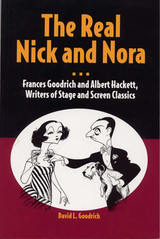 The Real Nick and Nora
David L. Goodrich
Southern Illinois University Press, 2004
Frances Goodrich and Albert Hackett wrote the screenplays for some of America’s most treasured movies, including It’s a Wonderful Life, The Thin Man, Easter Parade, Father of the Bride, Naughty Marietta, and Seven Brides for Seven Brothers. Legendary films, indeed, but writing both the play and screenplay for The Diary of Anne Frank was their crowning achievement.
Controlled chaos best describes their writing method. They discussed a scene at length, sometimes acting it out. Afterwards, they each wrote a draft, which they exchanged. “Then,” Frances said, “began ‘free criticism’—which sometimes erupted into screaming matches.” Noisy and contentious, the method worked splendidly.
Enormously successful and remarkably prolific, Goodrich and Hackett began their thirty-four-year collaboration in 1928. Married after the first of their five plays became a hit, they were in many ways an unlikely pair. Frances, the privileged daughter of well-to-do parents, graduated from Vassar, then played minor parts on Broadway. Albert’s mother put him on stage at age five, when his father died, to help pay the bills, and he became a highly paid comedian.
The Hacketts were known for their wit and high spirits and the pleasure of their Bel Air dinner parties. They waged memorable battles with their powerful bosses and were key activists in the stressful creation of the Screen Writers Guild. Once they had created Nick and Nora Charles, The Thin Man’s bright, charming, sophisticated lead couple, played memorably by William Powell and Myrna Loy, many people saw a strong resemblance, and the Hacketts acknowledged that they “put themselves into” Nick and Nora.
The Real Nick and Nora is a dazzling assemblage of anecdotes featuring some of the most talented writers and the brightest lights of American stage and screen. The work was arduous, the parties luminous. On any given night the guests singing and acting out scripts at a party might include F. Scott Fitzgerald and Sheilah Graham, S. J. Perelman, Oscar Levant, Ogden Nash, Judy Garland, Abe Burrows, Hoagy Carmichael, Johnny Mercer, Ira Gershwin, George Burns and Gracie Allen, Pat O’Brien, Dick Powell and June Allyson, Dashiell Hammett, Lillian Hellman, James Cagney, and Dorothy Parker.
Real Objects in Unreal Situations: Modern Art in Fiction Films
Susan Felleman
Intellect Books, 2014 Real Objects in Unreal Situations is a lucid account of a much neglected subject in art and cinema studies: the material significance of the art object incorporated into the fiction film. By examining the historical, political, and personal realities that situate the art works, Susan Felleman offers an incisive account of how they operate not as objects but as powerful players within the films, thereby exceeding the narrative function of mere props, copies, pastiches, or reproductions. The book consists of a series of interconnected case studies of movies, including Pride & Prejudice, The Trouble with Harry, and The Player, ultimately showing that when real art works enter into fiction films, they embody themes and discourses in a way that other objects often cannot.
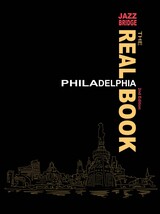 The Real Philadelphia Book
Jazz Bridge
Temple University Press, 2022 The Real Philadelphia Book, compiled by Jazz Bridge and editors David Dzubinski and Suzanne Cloud, is a collection of more than 200 original jazz and blues compositions. Arranged alphabetically by song title, the sheet music showcases work by generations of Philadelphia musicians. This volume, which is “what every aspiring jazz musician needs to know,” features tunes from Grammy Award-winners Jimmy Heath, Grover Washington, Jr., and Christian McBride, as well as legends such as Joey DeFrancesco, Ray Bryant, and Robin and Duane Eubanks. Also included are rare compositions by jazz greats Bobby Timmons, Hank Mobley, and Lee Morgan, in addition to music by local luminaries, Rhenda Fearrington, Monnette Sudler, and Kaylé Brecher. The aim of The Real Philadelphia Book is to help the jazz community make deeper, stronger connections while also formally documenting much of the important music created in the Philadelphia metro area by both well- and lesser-known musicians. Including an index of composers, The Real Philadelphia Bookwill enhance and add to the rich Philadelphia jazz and blues tradition and make the Philly jazz catalogue more easily available to musicians, jazz students and educators around the world.
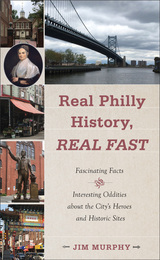 Real Philly History, Real Fast: Fascinating Facts and Interesting Oddities about the City's Heroes and Historic Sites
Jim Murphy
Temple University Press, 2021 Philadelphia is known as the home of vibrant colonial history: the Liberty Bell, the Betsy Ross House, and Independence Hall. But the City of Brotherly Love is also home to—and less well known for—its quirky history. The country’s first quarantine station was located here. One of Philly’s clocks has a face larger than Big Ben’s in London. And a unique skill of Black abolitionist James Forten saved him from a life of West Indian servitude (and “Forten” was not even his real name). In Real Philly History, Real Fast, Jim Murphy provides an original tour of the city. He highlights artistic gems including the Dream Garden Tiffany mosaic and Isaiah Zagar’s glittering Magic Gardens. He profiles intriguing historical figures from military leader Commodore Barry to civil rights heroes like Lucretia Mott. Murphy also explores neighborhoods from Chinatown to the Italian Market and the unique architectural details of Carpenters’ Hall and the PSFS building. Each chapter provides a pithy story about a historical person or site, along with bullet points featuring interesting oddities, and nearby attractions along with fun facts such as: Why there are so many churches? What is the Philadelphia Eagles’ connection to the U.S. Custom House? Which famous artist may have been Philadelphia’s first nude model? And where was the Liberty Bell secretly damaged? (We didn’t do it!) This is Philly history in bites that are as digestible as a soft pretzel with mustard.
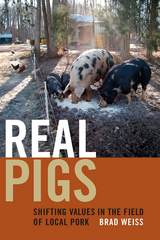 Real Pigs: Shifting Values in the Field of Local Pork
Brad Weiss
Duke University Press, 2016 In addition to being one of the United States' largest pork producers, North Carolina is home to a developing niche market of pasture-raised pork. In Real Pigs Brad Weiss traces the desire for "authentic" local foods in the Piedmont region of central North Carolina as he follows farmers, butchers, and chefs through the process of breeding, raising, butchering, selling, and preparing pigs raised on pasture for consumption. Drawing on his experience working on Piedmont pig farms and at farmers’ markets, Weiss explores the history, values, social relations, and practices that drive the pasture-raised pork market. He shows how pigs in the Piedmont become imbued with notions of authenticity, illuminating the ways the region's residents understand local notions of place and culture. Full of anecdotes and interviews with the market's primary figures, Real Pigs reminds us that what we eat and why have implications that resonate throughout the wider social, cultural, and historical world.
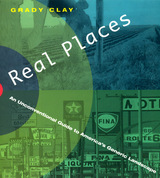 Real Places: An Unconventional Guide to America's Generic Landscape
Grady Clay
University of Chicago Press, 1994 In Real Places, Grady Clay presents the American landscape in a completely fresh and untypical way. Rather than look at locations, he studies constructed, imaginative sites. Clay explores the fascination of "Fall Color Country," or "Lover's Lane." What draws people to these "generic" landscapes and keeps them coming back literally and figuratively time and time again? Real Places catalogs and describes a unique cross-section of America, emphasizing the beauty and intrigue of these hidden gems. Heavily illustrated with maps and photographs depicting the everyday as well as the bizarre, Clay's entertaining Baedeker allows us to see in a new way what has always been "right before our eyes."
"This book provides a language for the architecture of everyday life."—Ross Miller, Chicago Tribune
"Spirited observations and capsule histories."—Suzanne Stephens, New York Times Book Review
"Compelling. . . . Included here are many nuggets of insight and illumination."—Brad Knickerbocker, Christian Science Monitor
"An amusing and touching book about the reality we Americans have captured in our language."—Boston Sunday Globe
Real Presences
George Steiner
University of Chicago Press, 1989 A powerful argument for the presence of the divine within art, from one of the twentieth-century's leading thinkers
In Real Presences, George Steiner, whom A. S. Byatt praised as "a late, late, late, late Renaissance man," addressed one of the most challenging and important questions about art and human understanding: Can there be major dimensions of a poem, a painting, a musical composition created in the absence of God? Or is God always a real presence in the arts? Drawing examples from across centuries and cultures, Steiner passionately argues that a transcendent reality grounds all genuine art and human communication.
Real Rape
Susan Estrich
Harvard University Press, 1987 Many men believe that they can force women to have sex against their will and that it isn’t rape—at least, not if the man knows the women and doesn’t beat her up or wield a weapon. The law’s casual treatment of such rape cases is the subject of this pioneering book, which is both a powerful exposé of the often shocking facts and a trenchantly written call for reform.
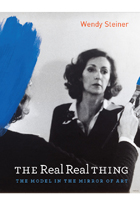 The Real Real Thing: The Model in the Mirror of Art
Wendy Steiner
University of Chicago Press, 2010 Our era is defined by the model. From Victoria’s Secret and America’s Next Top Model to the snapshots we post on Facebook and Twitter, our culture is fixated on the pose, the state of existing simultaneously as artifice and the real thing. In this bold view of contemporary culture, Wendy Steiner shows us the very meaning of the arts in the process of transformation. Her story begins at the turn of the last century, as the arts abandoned the representation of the world for a heady embrace of the abstract, the surreal, and the self-referential. Today though, this “separate sphere of the aesthetic” is indistinguishable from normal life. Media and images overwhelm us: we gingerly negotiate a real-virtual divide that we suspect no longer exists, craving contact with what J. M. Coetzee has called “the real real thing.” As the World Wide Web renders the lower-case world in ever-higher definition, the reality-based genres of memoir and documentary are displacing fiction, and novels and films are depicting the contemporary condition through model-protagonists who are half-human, half-image. Steiner shows the arts searching out a new ethical potential through this figure: by stressing the independent existence of the model, they welcome in the audience in all its unpredictability, redefining aesthetic experience as a real-world interaction with the promise of empathy, reciprocity, and egalitarian connection. A masterly performance by a penetrating, inquisitive mind, The Real Real Thing is that rarest of books, one whose provocations and inspirations will inspire readers to take a new—and nuanced—look at the world around them.
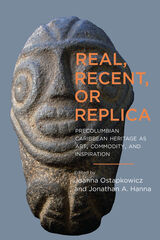 Real, Recent, or Replica: Precolumbian Caribbean Heritage as Art, Commodity, and Inspiration
Edited by Joanna Ostapkowicz and Jonathan A. Hanna
University of Alabama Press, 2021 A Choice Outstanding Academic Title, 2022
Examines the largely unexplored topics in Caribbean archaeology of looting of heritage sites, fraudulent artifacts, and illicit trade of archaeological materials
Real, Recent, or Replica: Precolumbian Caribbean Heritage as Art, Commodity, and Inspiration is the first book-length study of its kind to highlight the increasing commodification of Caribbean Precolumbian heritage. Amerindian art, including “Taíno” art, has become highly coveted by collectors, spurring a prolific and increasingly sophisticated black market of forgeries, but also contemporary artistic engagement, openly appreciated as modern artworks taking inspiration from the past. The contributors to this volume contend with difficult subject matter including the continued looting of archaeological sites in the region, the seismic increase of forgeries, and the imbalance of power and economic relations between the producers and consumers of neo-Amerindian art.
The case studies document the considerable time depth of forgeries in the region (since the late nineteenth century), address the policies put in place by Caribbean governments and institutions to safeguard national patrimony, and explore the impact looted and forged artifacts have on how museums and institutions collect and ultimately represent the Caribbean past to their audiences. Overall, the volume emphasizes the continued desire for the “authentic” Precolumbian artifact, no matter the cost. It provides insights for archaeologists, museum professionals, art historians, and collectors to combat illegal trade and support communities in creating sustainable heritage industries.
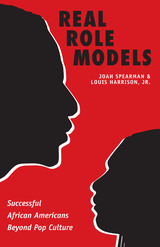 Real Role Models: Successful African Americans Beyond Pop Culture
By Joah Spearman and Louis Harrison, Jr.
University of Texas Press, 2010 All young people need good role models, and black youth especially need positive and real examples beyond the famous and wealthy people they see on SportsCenter highlights and MTV Cribs. While success as a celebrity athlete or entertainer may seem like an achievable dream, the reality is that young African Americans have a much greater chance of succeeding in the professions through education and hard work—and a mentor to show them the path. Real Role Models introduces high school and college-age African Americans to twenty-three black professionals who have achieved a high level of success in their chosen fields and who tell their stories to inspire young people to pursue a professional career and do the work necessary to achieve their dreams. Some of the individuals profiled by Joah Spearman and Louis Harrison, Jr., include Leonard Pitts, Pulitzer Prize–winning columnist for the Miami Herald; Melody Barnes, Director of the White House Domestic Policy Council; Danyel Smith, editor-in-chief of Vibe; and Dr. Tim George, Chief of Pediatric Neuroscience at Dell Children's Medical Center of Central Texas. They and other interviewees describe their backgrounds, career paths, and desire to give back by helping others reach their goals. Representing a wide range of occupations, these real role models prove to African American youths that a whole world of successful, rewarding careers awaits them. The Real Role Models - Rufus Cormier, JD, Partner at the Baker Botts Law Firm, Houston, Texas
- Melody Barnes, Director of the White House Domestic Policy Council, Washington, D.C.
- Eric Motley, PhD, Managing Director of the Aspen Institute's Henry Crown Fellowship Program, Aspen, Colorado
- James McIntyre, Spokesman for the Federal Emergency Management Agency, Washington, D.C.
- Tracie Hall, Assistant Dean and Librarian at Dominican University, River Forest, Illinois
- Kimberlydawn Wisdom, MD, Surgeon General of the State of Michigan, Lansing, Michigan
- Timothy George, MD, Chief of Pediatric Neuroscience at Dell Children's Medical Center, Austin, Texas
- Victoria Holloway Barbosa, MD, Ethnic Dermatologist and Former Executive for L'Oreal, Chicago, Illinois
- Bill Douglas, White House Correspondent for McClatchy Newspapers, Washington, D.C.
- Leonard Pitts, Jr., Columnist for the Miami Herald, Miami, Florida
- Danyel Smith, Editor of Vibe Magazine, New York, New York
- Ed Stewart, Managing Director of External Communications for Delta Airlines, Atlanta, Georgia
- Lynn Tyson, Vice President of Investor Relations for Dell, Austin, Texas
- Willie Miles, Jr., Founder and CEO of Miles Wealth Management, Houston, Texas
- Horace Allen, Founder and CEO of TeamPact, Atlanta, Georgia
- Deavra Daughtry, President and CEO of Excellent Care Management, Houston, Texas
- Je'Caryous Johnson, Founder and CEO of I'm Ready Productions, Houston, Texas
- Steve Jones, Cofounder of a graphic design company, Oakland, California
- Isiah Warner, PhD, Chemistry Professor at Louisiana State University, Baton Rouge, Louisiana
- Gloria Ladson-Billings, PhD, Professor of Education at the University of Wisconsin, Madison, Wisconsin
- Bernard Muir, Athletic Director at Georgetown University, Washington, D.C.
- Craig Littlepage, Athletic Director at the University of Virginia, Charlottesville, Virginia
- Beverly Kearney, Women's Track Coach at the University of Texas at Austin, Austin, Texas
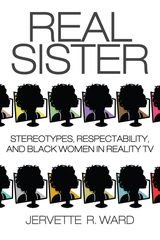 Real Sister: Stereotypes, Respectability, and Black Women in Reality TV
Ward, Jervette R
Rutgers University Press, 2015 From The Real Housewives of Atlanta to Flavor of Love, reality shows with predominantly black casts have often been criticized for their negative representation of African American women as loud, angry, and violent. Yet even as these programs appear to be rehashing old stereotypes of black women, the critiques of them are arguably problematic in their own way, as the notion of “respectability” has historically been used to police black women’s behaviors.
The first book of scholarship devoted to the issue of how black women are depicted on reality television, Real Sister offers an even-handed consideration of the genre. The book’s ten contributors—black female scholars from a variety of disciplines—provide a wide range of perspectives, while considering everything from Basketball Wives to Say Yes to the Dress. As regular viewers of reality television, these scholars are able to note ways in which the genre presents positive images of black womanhood, even as they catalog a litany of stereotypes about race, class, and gender that it tends to reinforce.
Rather than simply dismissing reality television as “trash,” this collection takes the genre seriously, as an important touchstone in ongoing cultural debates about what constitutes “trashiness” and “respectability.” Written in an accessible style that will appeal to reality TV fans both inside and outside of academia, Real Sister thus seeks to inspire a more nuanced, thoughtful conversation about the genre’s representations and their effects on the black community.
 Real Sports, Volume 95
James T. Fisher
Duke University Press The contributors to this volume were recruited by editor James T. Fisher on the basis of writing talent and a passion for sports equal to his own. These scholars and critics from such disciplines as history, English, comparative literature, and theology look to the sidelines of their academic lives to break new ground in sportswriting. But they are neither competing for turf in sports journalism nor aiming to establish an academic area such as “sports studies”—the prospect of which, says Fisher, “is not pleasant to behold.” Instead, they write about boxing, for example, in terms of living and working (out) in the college town where Larry Holmes grew up and now owns a gym; about how the religious implications of Sunday-afternoon sports in seventeenth-century England became the key to a Cambridge theology student’s understanding of the fall of Archbishop Laud and Charles I; about baseball as Cuba’s national pastime—and what that means to a Cuban professor of literature at Yale. Indeed, questions of meaning, mediation, and the mediation of the media are repeatedly raised here as contributors explore the historical, social, cultural, and personal experience of sports as an index of identity. Real Sports features a historian’s analysis of sports as a nexus between Indian and Euro-American cultures; a critique of sports talk radio and the ethic of the fan; and a literary critic’s celebration of the Midwest, complete with swamps, shopping centers, and “the Spartan green of the Big Ten.” Also explored is today’s father-son generation gap, between fathers who root for their home teams and sons whose place is six feet from the TV set, “where every team is the home team.” Contributors. Patrick Allitt, Philip Deloria, Ann Fabian, James T. Fisher, Roberto González Echevarría, Pamela Haag, Michael Oriard, Kenneth Parker, Stephen Rachman, Carlo Rotella
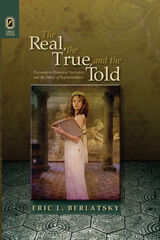 The Real, the True, and the Told: Postmodern Historical Narrative and the Ethics of Representation
Eric L. Berlatsky
Ohio State University Press, 2011 The Real, The True, and The Told: Postmodern Historical Narrative and the Ethics of Representation, by Eric L. Berlatsky, intervenes in contemporary debates over the problems of historical reference in a postmodern age. It does so through an examination of postmodern literary practices and their engagement with the theorization of history. The book looks at the major figures of constructivist historiography and at postmodern fiction (and memoir) that explicitly presents and/or theorizes “history.” It does so in order to suggest that reading such fiction can intervene substantially in debates over historical reference and the parallel discussion of redefining contemporary ethics. Much theorization in the wake of Hayden White suggests that history is little better than fiction in its professed goal of representing the “truth” of the past, particularly because of its reliance on the narrative form.While postmodern fiction is often read as reflecting and/or repeating such theories, this book argues that, in fact, such fiction proposes alternative models of accurate historical reference, based on models of nonnarrativity. Through a combination of high theory andnarrative theory, the book illustrates how the texts examined insist upon the possibility of accessing the real by rejecting narrative as their primary mode of articulation. Among the authors examined closely in The Real, The True, and The Told are Virginia Woolf, Graham Swift, Salman Rushdie, Art Spiegelman, and Milan Kundera.
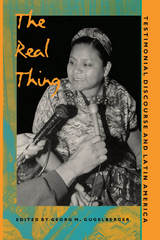 The Real Thing: Testimonial Discourse and Latin America
Georg M. Gugelberger, ed.
Duke University Press, 1996 Presented as the authentic testimony of the disenfranchised, the colonized, and the oppressed, testimonio has in the last two decades emerged as one of the most significant genres of Latin America’s post-boom literature. In the political battles that have taken place around the formation of the canon, the testimonio holds a special place: no other single genre of literature has taken up such a large part of current debate. Initially hailed in the 1970s as a genuine form of resistance literature, testimonio has since undergone a significant change in its critical reception. The essays in The Real Thing analyze the testimonio, its history, and its place in contemporary consciousness. Although the literature of testimony arose on the margins of institutional power and its ends were in large part political change, the canonization of testimonio by the academic Left has moved it from margin to center, ironically bringing about the institutionalization of its transgressive and counter-hegemonic qualities. Discussing Latin American works ranging from Salvadorian writer Roque Dalton’s Miguel Marmol to I . . . Rigoberta Menchu, a work that earned its author a Nobel Prize, this collection explores how critical writing about testimonio has turned into discourse about the institution of academia, the canon, postmodernism and postcolonialism, and the status of Latin American studies generally. Contributors. John Beverley, Santiago Colás, Georg M. Gugelberger, Barbara Harlow, Fredric Jameson, Alberto Moreiras, Margaret Randall, Javier Sanjines, Elzbieta Sklodowska, Doris Sommer, Gareth Williams, George Yúdice, Marc Zimmerman
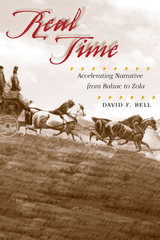 Real Time: Accelerating Narrative from Balzac to Zola
David F. Bell
University of Illinois Press, 2003 In Real Time David F. Bell explores the decisive impact the accelerated movement of people and information had on the fictions of four giants of French realism--Balzac, Stendhal, Dumas, and Zola.
Nineteenth-century technological advances radically altered the infrastructure of France, changing the ways ordinary citizens–-and literary characters--viewed time, space, distance, and speed. The most influential of these advances included the improvement of the stagecoach, the growth of road and canal networks leading to the advent of the railway, and the increasing use of mail, and of the optical telegraph. Citing examples from a wide range of novels and stories, Bell demonstrates the numerous ways in which these trends of acceleration became not just literary devices and themes but also structuring principles of the novels themselves.
Beginning with both the provincial and the Parisian communications networks of Balzac, Bell proceeds to discuss the roles of horses and optical telegraphs in Stendhal and the importance of domination of communication channels to the characters of Dumas, whose Count of Monte-Cristo might be seen as the ultimate fictional master of this accelerated culture. Finally, Bell analyzes the cinematic vision created by the arrival of the railroad, as depicted by Zola in La Bète Humaine.
Real Time Convex Optimisation for 5G Networks and Beyond
Long D. Nguyen
The Institution of Engineering and Technology, 2022 There is no doubt that we are facing a wireless data explosion. Modern wireless networks need to satisfy increasing demand, but are faced with challenges such as limited spectrum, expensive resources, green communication requirements and security issues. In the age of internet of things (IoT) with massive data transfers and huge numbers of connected devices, including high-demand QoS (4G, 5G networks and beyond), signal processing is producing data sets at the gigabyte and terabyte scales.
Real to Reel
Lidia Yuknavitch
University of Alabama Press, 2003 With an intelligence that scalds every pretense and surface, Lidia Yuknavitch's camera pans across subjects as varied as Keanu Reeves and Siberian prison laborers. She zooms in on drug addiction, crime, sex of all flavors, trauma, torture, rock and roll, and art, all the while revealing untried angles and alien shapes. She traces the inner lives of characters teetering on edges-death, birth, love, understanding-but never flinching at the spectacle of their violent descent. This collection represents a verbal cinematographer at her best as she captivates the reader with a prose style that is mesmerizing and fluid, deep and dangerous.
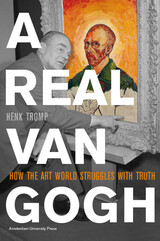 A Real Van Gogh: How the Art World Struggles with Truth
Henk Tromp
Amsterdam University Press, 2010
In 1928, after eleven years of extensive research and editing, Dr. Jacob Baart de la Faille finally finished the first catalogue raisonné of Vincent van Gogh’s work. Soon after, however, de la Faille discovered that he had mistakenly listed dozens of forged works as genuine in the catalog. He quickly set out to set the record straight but was met with strong resistance from art dealers, collectors, critics, politicians, amongst others—all of whom had self-interested reasons to oppose his corrections.
To this day, the international art world struggles to separate the real Van Goghs from the fake. A Real Van Gogh begins with the story of de la Faille and moves into the late decades of the twentieth century, outlining the numerous clashes over the authenticity of Van Gogh’s works while simultaneously exposing the often bewildering ramifications for art critics and scholars when they bring unwelcome news.
Real Wages in Soviet Russia since 1928
Janet G. Chapman
Harvard University Press "Both a dissertation under the auspices of the Department of Economics of Columbia University and part of a research program conducted by the Rand Corporation for the United States Air Force."
Bibliography: p. [373]-385.
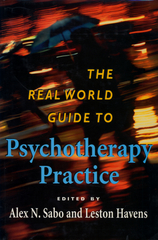 The Real World Guide to Psychotherapy Practice
Alex N. Sabo
Harvard University Press, 2000 “All of us who have long done this work can look back at those happy times when the patient’s gain has also been, in part, our own. Thereby an extraordinary joy enters the work, for both parties, through this making of lives. Can there be better work to do in the world?”—from the Epilogue by Leston HavensManaged care has radically reshaped health care in the United States, and private long-term psychotherapy is increasingly a thing of the past. The corporatization of mental health care often puts therapists in professional quandaries. How can they do the therapeutic work they were trained to do with clients whom they may barely know, whose care is intruded upon by managed care administrators? With unrelenting pressure to substitute medications for therapy and standardized behavior protocols for individualized approaches, what becomes of the therapist–client relationship?Unflinchingly honest, The Real World Guide to Psychotherapy Practice offers both compelling stories and practical advice on maintaining one’s therapeutic integrity in the managed care era. Resisting a one-size-fits-all approach, the authors focus on the principles of forming relationships with patients, and especially patients likely to be under-served (e.g., the uninsured poor) or difficult to treat.The Real World Guide to Psychotherapy Practice gives voice to therapists’ frustrations with the administrative constraints under which they work. But it accepts the reality and offers guidance and inspiration to committed therapists everywhere.
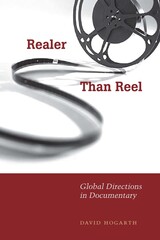 Realer Than Reel: Global Directions in Documentary
By David Hogarth
University of Texas Press, 2006 Television and globalization have transformed the traditional documentary almost beyond recognition, converting what was once a film genre devoted to public service and education into a popular televisual commodity with productions ranging from serious public affairs programming to TV "reality" shows and "docusoaps." Realer Than Reel offers a state-of-the-art overview of international documentary programming that investigates the possibilities documentary offers for local and public representation in a global age, as well as what actually constitutes documentary in a time of increasing digitalization and manipulation of visual media. David Hogarth focuses on public affairs, nature, and reality shows from around the world, drawing upon industry data, producer interviews, analyses of selected documentary programs, and firsthand observations of market sites. He looks at how documentary has become a transnational product through exports, co-ventures, and festival contacts; how local and regional "place" is represented in global documentary, especially by producers such as Discovery Networks International and the National Geographic Channel; how documentary addresses the needs of its viewers as citizens through public service broadcasting; and how documentary is challenging accepted conventions of factuality, sense, and taste. The concluding chapter considers the future of both documentary as a genre and television as a global factual medium, asking whether TV will continue to "document" the world in any meaningful sense of the term.
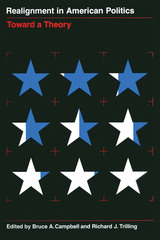 Realignment in American Politics: Toward a Theory
Edited by Bruce A. Campbell and Richard J. Trilling
University of Texas Press, 1980 To have a voice in shaping government policy has been a goal of the American people since the nation's founding. Yet, government seems even less accessible now than in the past. An increasing rate of incumbency in Congress, the unwieldy committee system that controls legislation, and the decline of political parties have all weakened representation and alienated Americans from the seat of power. The one remaining way to produce major and coherent change in national policy is through partisan realignment—a sharp, enduring shift in voter support of the two major parties. This book is about the phenomenon of realignment in American politics. It not only brings together and assesses previous work in the area but also breaks new ground in the analysis of the effects of realignment on political elites and public policy. In addition, it is the first study to present an integrated theory of realignment that can be applied to the understanding of mass, elite, and policy change in times of social crisis. Contributors include Lawrence McMichael, David Nexon, Louis Seagull, Robert Lehnen, Philip Converse, Gregory Markus, Lester Seligman, Michael King, David Brady, Kenneth Meier, Kenneth Kramer, David Adamany, Charles Stewart, Susan Hansen, and the editors.Bruce A. Campbell taught political science at the University of Georgia. He is the author of The American Electorate.
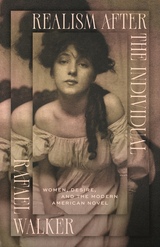 Realism after the Individual: Women, Desire, and the Modern American Novel
Rafael Walker
University of Chicago Press, 2026 A study of the transformation of the realist novel in the hands of early-twentieth-century American writers, who adapted this quintessentially nineteenth-century genre to the conditions of their age.
Realism after the Individual offers a new theoretical paradigm for understanding realist novels published in the United States between 1900 and 1920, a period that has been described wrongheadedly as a “gulf” or a “valley” in American literary history. In this generation of writers, only three have remained in favor among critics: Kate Chopin, Edith Wharton, and Theodore Dreiser. Others have disappeared from view altogether—writers such as Robert Grant, Robert Herrick, and Booth Tarkington, all of whom were critically acclaimed bestsellers in their day.
As Rafael Walker shows, this generation of writers deserves new attention for the way they revised many core facets of the nineteenth-century novel in response to the historical shifts around it. This generation of novelists not only rejected liberal individualism but also formulated alternative paradigms for conceptualizing selfhood. The result was a slew of woman-centered realist novels that broke with literary precedent: The novels punish characters not for desiring too much but for failing to desire enough, they depict subjectivity not as private and interior but as outward-facing, and they view closure not as the novel’s aim but as a convention to flout. Realism after the Individual both revises prevailing views of American realism and lays the foundation for an alternative account of the development of literary modernism, one that illuminates the continuity between realism and the modernism that followed it.
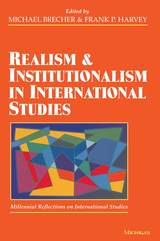 Realism and Institutionalism in International Studies
Michael Brecher and Frank P. Harvey, editors
University of Michigan Press, 2009 Realism and Institutionalism in International Studies represents a unique collection of original essays by foremost scholars in the field of International Studies. Six essays advocate, critique, or revise Realism, the theoretical paradigm that explains international politics by emphasizing security competition and war among states. The remaining four essays address Institutionalism, the paradigm that offers explanations for the formation, maintenance, variation, and significance of international institutions. The authors reflect on the strengths and weaknesses of these approaches and suggest research agendas for the future. Together, this volume provides an accessible and wide-ranging survey of the issues concerning two major paradigms in International Studies. This volume will be of interest to scholars and students alike and will undoubtedly determine the shape of future research.
Realism and Naturalism in Nineteenth-Century American Literature, Revised Edition
Donald Pizer
Southern Illinois University Press, 1984
The 1966 edition of this book has become a standard work. In this new, revised edition, Pizer has dropped three chapters and has refined and extended the work by adding six: “American Literary Naturalism: An Approach Through Form,” “American Literary Naturalism: The Example of Dreiser,” “The Problem of Philosophy in the Naturalistic Novel,” “Hamlin Garland’s 1891 Main-Travelled Roads: Local Color as Art,” “Jack London: The Problem of Form,” and “Dreiser’s ‘Nigger Jeff’: The Development of an Aesthetic.”
The book contains definitions of realism and naturalism based on representative novels of the period ranging from Howells’ Rise of Silas Lapham to Crane’s Red Badge of Courage; analyses of the literary criticism of the age, stressing that of Howells, Garland, and Norris; and close readings of specific works by major figures of the period.
Realism And Pragmatic Epistemology
Nicholas Rescher
University of Pittsburgh Press, 2005
An examination of philosophical realism from the standpoint of pragmatic epistemology, this book addresses the core idea of Rescher's work in epistemology: that functional and pragmatic concerns exert a controlling influence on the conduct of rational inquiry and on the ways in which we can and should regard its products.
Pragmatism is widely regarded as a philosophical approach that stands at odds with realism, but Rescher takes a very different approach. He views pragmatism as a realistic position that can be developed from a pragmatic point of view, and utilizes a number of case studies to augment his position. Throughout, he shows how the pragmatic and purposive setting of our putative knowledge of the real world proves to be crucial for the constituting and also for the constitution of our knowledge.
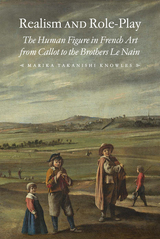 Realism and Role-Play: The Human Figure in French Art from Callot to the Brothers Le Nain
Marika Takanishi Knowles
University of Delaware Press, 2011 After the heroic nudes of the Renaissance and depictions of the tortured bodies of Christian saints, early seventeenth-century French artists turned their attention to their fellow humans, to nobles and beggars seen on the streets of Paris, to courtesans standing at their windows, to vendors advertising their wares, to peasants standing before their landlords. Fascinated by the intricate politics of the encounter between two human beings, artists such as Jacques Callot, Daniel Rabel, Abraham Bosse, Claude Vignon, Georges de la Tour, Jean de Saint-Igny, the Brothers Le Nain, Pierre Brébiette, Jean I Le Blond, and Charles David represented the human figure as a performer acting out a social role. The resulting figures were everyday types whose representations in series of prints, painted galleries, and illustrated books created a repertoire of such contemporary roles. Realism and Role-Play draws on literature, social history, and affect theory in order to understand the way that figuration performed social positions.
Published by University of Delaware Press. Distributed worldwide by Rutgers University Press.
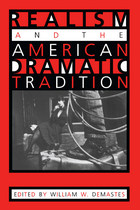 Realism and the American Dramatic Tradition
William W. Demastes
University of Alabama Press, 1996 This book reconsiders realism on the American stage by addressing the great variety and richness of the plays that form the American theatre canon. Any review of 20th-century American theatre invariably leads to the term realism. Yet despite the strong tradition of theatrical realism on the American stage, the term is frequently misidentified, and the practices to which it refers are often attacked as monolithically tyrannical, restricting the potential of the American national theatre.This book reconsiders realism on the American stage by addressing the great variety and richness of the plays that form the American theatre canon. By reconsidering the form and revisiting many of the plays that contributed to the realist tradition, the authors provide the opportunity to apprise strengths often overlooked by previous critics. The volume traces the development of American dramatic realism from James A. Herne, the "American Ibsen," to currently active contemporaries such as Sam Shepard, David Mamet, and Marsha Norman. This frank assessment, in sixteen original essays, reopens a critical dialog too long closed. Essays include: American Dramatic Realisms, Viable Frames of Thought The Struggle for the Real--Interpretive Conflict, Dramatic Method, and the Paradox of Realism The Legacy of James A. Herne: American Realities and Realisms Whose Realism? Rachel Crothers's Power Struggle in the American Theatre The Provincetown Players' Experiments with Realism Servant of Three Masters: Realism, Idealism, and "Hokum" in American High Comedy
Realism for the 21st Century: A John Deely Reader
John Deely
University of Scranton Press, 2009 Realism for the 21st Century is a collection of thirty essays from John Deely—a major figure in contemporary semiotics and an authority on scholastic realism and the works of Charles Sanders Peirce. The volume tracks Deely’s development as a pragmatic realist, featuring his early essays on our relation to the world after Darwinism; crucial articles on logic, semiotics, and objectivity; overviews of philosophy after modernity; and a new essay on “purely objective reality.”
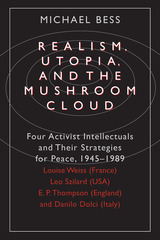 Realism, Utopia, and the Mushroom Cloud: Four Activist Intellectuals and their Strategies for Peace, 1945-1989--Louise Weiss (France), Leo Szilard (USA), E. P. Thompson (England), Danilo Dolci (Italy)
Michael Bess
University of Chicago Press, 1993 "Two world wars, concentration camps, the obliteration of Hiroshima and
Nagasaki, and continued preparations for nuclear war illustrate the modern
world's propensity for mass destruction. . . . Yet there have been
important signs of resistance to this trend. These have included not only
the emergence of mass-based peace and disarmament movements but activist
intellectuals grappling with the growing problem posed by mass violence
among nation-states. . . . Bess examines the lives and ideas of four of
these intellectuals: Leo Szilard of Hungary and (later) the United States,
E. P. Thompson of England, Danilo Dolci of Italy, and Louise Weiss of
France. . . . Realism, Utopia, and the Mushroom Cloud is a powerful,
important scholarly work, casting new light upon some of the great issues
of modern times. Readers will learn much from it."—Lawrence S.
Wittner, Peace and Change
"Bess seeks to understand the way in which the creation of the atomic bomb
has changed the social and political situation of humankind. Are we to be
held hostage by military forces or can we transform our situation? He
describes the lives of four very different activists, each with different
views on what causes conflict and how best to address conflict. . . .
Overall, this book offers an interesting perspective on life after the
atomic bomb. . . . In asking ourselves what the possibilities of our future
are, we can turn to these lives for some guidance. . . . This book is
informative, provocative, and encourages one to consider carefully how s/he
chooses to live."—Erin McKenna, Utopian Studies
"These four lives, researched and skillfully presented by historian Michael
Bess, make fascinating stories in themselves. They also serve as useful
vehicles for examining major cross-currents of Cold War resistance. . . .
From Weiss the cynical pragmatist to Szilard the high-level fixer to
hompson the social reformer to Dolce the spiritual street organizer,
Michael Bess has woven an illuminating tapestry of human efforts to cope
with life under the mushroom cloud."—Samuel H. Day Jr., The
Progressive
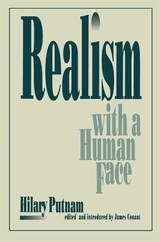 Realism with a Human Face
Hilary Putnam
Harvard University Press, 1990 The time has come to reform philosophy, says Hilary Putnam, one of America’s great philosophers. He calls upon philosophers to attend to the gap between the present condition of their subject and the human aspirations that philosophy should and once did claim to represent. Putnam’s goal is to embed philosophy in social life.
The first part of this book is dedicated to metaphysical questions. Putnam rejects the contemporary metaphysics that insists on describing both the mind and the world from a God’s-eye view. In its place he argues for pluralism, for a philosophy that is not a closed systematic method but a human practice connected to real life. Philosophy has a task, to be sure, but it is not to provide an inventory of the basic furniture of the universe or to separate reality in itself from our own projections. Putnam makes it clear that science is not in the business of describing a ready-made world, and philosophy should not be in that business either.
The author moves on to show that the larger human context in which science matters is a world of values animated by ethics and aesthetic judgments. No adequate philosophy should try to explain away ethical facts. The dimension of history is added in the third part of the book. Here Putnam takes up a set of American philosophers, some firmly within and others outside the canon of analytic philosophy, such as William James and C. S. Peirce, and he explores the pragmatist contribution to philosophy from James to Quine and Goodman.
This book connects issues in metaphysics with cultural and literary issues and argues that the collapse of philosophical realism does not entail a fall into the abyss of relativism and postmodern skepticism. It is aimed primarily at philosophers but should appeal to a wide range of humanists and social scientists.
Realism, Writing, Disfiguration: On Thomas Eakins and Stephen Crane
Michael Fried
University of Chicago Press, 1987 "A highly original and gripping account of the works of Eakins and Crane. That remarkable combination of close reading and close viewing which Fried uniquely commands is brought to bear on the problematic nature of the making of images, of texts, and of the self in nineteenth-century America."—Svetlana Alpers, University of California, Berkeley
"An extraordinary achievement of scholarship and critical analysis. It is a book distinguished not only for its brilliance but for its courage, its grace and wit, its readiness to test its arguments in tough-minded ways, and its capacity to meet the challenge superbly. . . . This is a landmark in American cultural and intellectual studies."—Sacvan Bercovitch, Harvard University
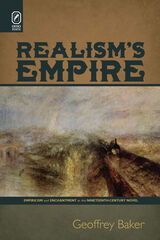 Realism's Empire: Empiricism and Enchantment in the Nineteenth-Century Novel
Geoffrey Baker
Ohio State University Press, 2009 If realist novels are the literary avatars of secular science and rational progress, then why are so many canonical realist works organized around a fear of that progress? Realism is openly indebted, at the level of form and content, to imperialist and scientific advances. However, critical emphasis on this has obscured the extent to which major novelists of the period openly worried about the fate of mystery and the dissolution of tradition that accompanied science’s shrinking of the world. Realism’s modernization is inseparable from nostalgia. In Realism’s Empire: Empiricism and Enchantment in the Nineteenth-Century Novel, Geoffrey Baker demonstrates that realist fiction’s stance toward both progress and the foreign or supernatural is much more complex than established scholarship has assumed. The work of Honoré de Balzac, Anthony Trollope, and Theodor Fontane explicitly laments the loss of mystery in the world due to increased knowledge and exploration. To counter this loss and to generate the complications required for narrative, these three authors import peripheral, usually colonial figures into the metropolitan centers they otherwise depict as disenchanted and rationalized: Paris, London, and Berlin. Baker’s book examines the consequences of this duel for realist narrative and readers’ understandings of its historical moment. In so doing, Baker shows Balzac, Trollope, and Fontane grappling with new realities that frustrate their inherited means of representation and oversee a significant shift in the development of the novel.
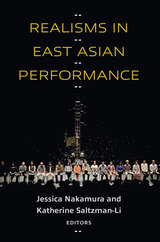 Realisms in East Asian Performance
Jessica Nakamura and Katherine Saltzman-Li, Editors
University of Michigan Press, 2023 Existing scholarly discussions of theatrical realism have been predominantly limited to 19th-century European and Russian theater, with little attention paid to wider explorations and alternative definitions of the practice. Examining theater forms and artists from China, Japan, and Korea, Realisms in East Asian Performance brings together a group of theater historians to reconsider realism through the performing arts of East Asia. The book’s contributors emphasize trans-regional conversations and activate inter-Asian dialogues on theatrical production. Tracing historical trajectories, starting from premodern periods through today, the book seeks to understand realisms’ multiple origins, forms, and cultural significances, and examines their continuities, disruptions, and divergences. In its diversity of topics, geographic locations, and time periods, Realisms in East Asian Performance aims to globalize and de-center the dominant narratives surrounding realism in theater, and revise assumptions about the spectacular and theatrical forms of Asian performance. Understanding realism as a powerful representational style, chapters collectively reevaluate acts of representation on stage not just for East Asia, but for theater and performance studies more broadly.
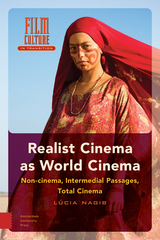 Realist Cinema as World Cinema: Non-cinema, Intermedial Passages, Total Cinema
Lúcia Nagib
Amsterdam University Press, 2020 This book presents the bold and original proposal to replace the general appellation of ‘world cinema’ with the more substantive concept of ‘realist cinema’. Veering away from the usual focus on modes of reception and spectatorship, it locates instead cinematic realism in the way films are made. The volume is structured across three innovative categories of realist modes of production: ‘noncinema’, or a cinema that aspires to be life itself; ‘intermedial passages’, or films that incorporate other artforms as a channel to historical and political reality; and ‘total cinema’, or films moved by a totalising impulse, be it towards the total artwork, total history or universalising landscapes. Though mostly devoted to recent productions, each part starts with the analysis of foundational classics, which have paved the way for future realist endeavours, proving that realism is timeless and inherent in cinema from its origin.
Realist Magic: Objects, Ontology, Causality
Timothy Morton
Michigan Publishing, 2013 Object-oriented ontology offers a startlingly fresh way to think about causality that takes into account developments in physics since 1900. Causality, argues OOO, is aesthetic. In this book, Timothy Morton explores what it means to say that a thing has come into being, that it is persisting, and that it has ended. Drawing from examples in physics, biology, ecology, art, literature and music, Morton demonstrates the counterintuitive yet elegant explanatory power of OOO for thinking causality.
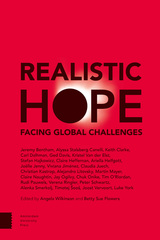 Realistic Hope: Facing Global Challenges
Angela Wilkinson
Amsterdam University Press, 2018 We are running out of water, robots will take our jobs, we are eating ourselves to an early death, old age pension and health systems are bankrupting governments, and an immigration crisis is unravelling the European integration project. A growing number of nightmares, perfect storms, and global catastrophes create fear of the future. One response is technocratic optimism — we’ll invent our way out of these impending crises. Or we’ll simply ignore them as politically too hot to handle, too uncomfortable for experts — denied until crisis hits. History is littered with late lessons from early warnings. Cynicism is an excuse for inaction. Populism flourishes in the depths of despair. Despite the gloom, there is another way to look at the future. We don’t have to be pessimistic or optimistic — we can find realistic hope. This book is written by an international and influential collection of future shapers. It is aimed at anyone who is interested in learning to refresh the present, forge new common ground, and redesign the future.
The Realistic Imagination: English Fiction from Frankenstein to Lady Chatterly
George Levine
University of Chicago Press, 1983 In The Realistic Imagination, George Levine argues that the Victorian realists and the later modernists were in fact doing similar things in their fiction: they were trying to use language to get beyond language. Levine sees the history of the nineteenth- and early twentieth-century novel as a continuing process in which each generation of writers struggled to escape the grip of convention and attempted to create new language to express their particular sense of reality. As these attempts hardened into new conventions, they generated new attempts to break free.
Realities and Relationships: Soundings in Social Construction
Kenneth J. Gergen
Harvard University Press, 1994 Recent attempts to challenge the primacy of reason—and its realization in foundationalist accounts of knowledge and cognitive formulations of human action—have focused on processes of discourse. Drawing from social and literary accounts of discourse, Kenneth Gergen considers these challenges to empiricism under the banner of “social construction.” His aim is to outline the major elements of a social constructionist perspective, to illustrate its potential, and to initiate debate on the future of constructionist pursuits in the human sciences generally and psychology in particular.
 Reality and Its Dreams
Raymond Geuss
Harvard University Press, 2016 Raymond Geuss is one of the most inventive and distinctive voices in contemporary political philosophy and a trenchant critic of the field’s dominant assumptions. In Reality and Its Dreams, he challenges the “normative turn” in political philosophy—the idea that the right approach to politics is to start from thinking abstractly about our own normative views and then, when they have been clarified and systematized, apply them to judging political structures, decisions, and events. Rather, the study of politics should be focused on the sphere of real politics, not least because normative judgments always arise from concrete historical configurations of power, including ideological power.
It is possible to do this without succumbing to a numbing or toxic form of relativism or abandoning utopianism, although utopianism needs to be reunderstood. The utopian impulse is not an attempt to describe a perfect society but an impulse to think the impossible in politics, to articulate deep-seated desires that cannot be realized under current conditions, and to imagine how conditions that seem invariant can be changed.
Geuss ranges widely across philosophy, literature, and art, exploring past and present ideas about such subjects as envy, love, satire, and evil and the work of figures as diverse as John Rawls, St. Augustine, Rabelais, and Russell Brand. His essays provide a bracing critique of ideas, too often unexamined, that shape and misshape our intellectual and political worlds.
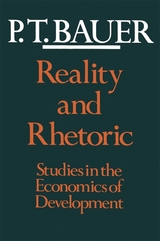 Reality and Rhetoric: Studies in the Economics of Development
P. T. Bauer
Harvard University Press, 1984 Reality and Rhetoric is the culmination of P. T. Bauer’s observations and reflections on Third World economies over a period of thirty years. He critically examines the central issues of market versus centrally planned economies, industrial development, official direct and multinational resource transfers to the Third World, immigration policy in the Third World, and economic methodology. In addition, he has written a fascinating account of recent papal doctrine on income inequality and redistribution in the Third World. The major themes that emerge are the importance of non-economic variables, particularly people’s aptitudes and mores, to economic growth; the unfortunate results of some current methods of economics; the subtle but important effects of the exchange economy on development; and the politicization of economic life in the Third World.
As in Bauer’s previous writings, this book is marked by elegant prose, apt examples, a broad economic-historical perspective, and the masterful use of informal reasoning.
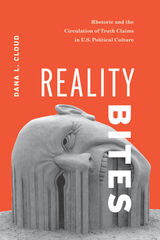 Reality Bites: Rhetoric and the Circulation of Truth Claims in U.S. Political Culture
Dana L. Cloud
Ohio State University Press, 2018 Fake news, alternative facts, post truth—terms all too familiar to anyone in U.S. political culture and concepts at the core of Dana L. Cloud’s new book, Reality Bites, which explores truth claims in contemporary political rhetoric in the face of widespread skepticism regarding the utility, ethics, and viability of an empirical standard for political truths. Cloud observes how appeals to truth often assume—mistakenly—that it is a matter of simple representation of facts. However, since neither fact-checking nor “truthiness” can respond meaningfully to this problem, she argues for a rhetorical realism—the idea that communicators can bring knowledge from particular perspectives and experiences into the domain of common sense. Through a series of case studies—including the PolitiFact fact-checking project, the Planned Parenthood “selling baby parts” scandal, the Chelsea Manning and Edward Snowden cases, Neil DeGrasse Tyson’s Cosmos, the rhetoric of Thomas Paine and the American Revolution, and the Black Lives Matter movement—Cloud advocates for the usefulness of narrative, myth, embodiment, affect, and spectacle in creating accountability in contemporary U.S. political rhetoric. If dominant reality “bites”—in being oppressive and exploitative—it is time, Cloud argues, for those in the reality-based community to “bite back.”
|
|

